
- Types Of RVs
- Tow Vehicles
- Maintenance & Repairs
- RV Power & Electrical Supplies
- RV Appliances
- Living In An RV
- Travel & Destinations
- RV Gear Buyer’s Guides
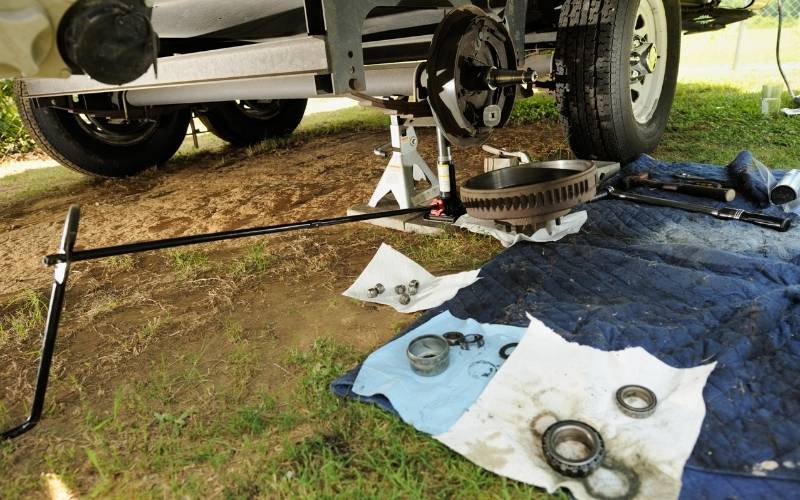

RV Maintenance Checklist: Monthly, Annual, Semi-Annual And Before Every Trip
- Last Updated: March 11, 2024
- 14 minutes read
Although they offer many of the same comforts as an apartment, RVs are built for mobility.
Part home, part vehicle, RVs have a long list of elements that could malfunction in some way or another.
Regular RV maintenance will make a huge difference in preventing costly repairs and replacements. It will also help ensure that your RV is ready for the road so that you don’t encounter any unexpected problems during your travels.
From annual maintenance checks to regular upkeep, this RV maintenance checklist covers the steps you should take to keep your RV in its best shape.
Routine Maintenance and Checks
A lot of RV maintenance should be done before and after each trip. Making sure that everything works ensures safety on the road and helps prevent unwanted surprises while on the road.
Properly cleaning and storing your RV after and between uses also prevents things like mold and rust that can eat away at the RV itself.
Let’s take a look at the various RV components that require routine maintenance.
Headlights/Brake Lights
Ensuring that all headlights and brake lights work is important for motorized RVs as well as tow vehicles.
Before each trip, do a quick inspection to make sure you and your RV are safe to hit the road.

Maintain Your RV Slide Out To keep it operational
Slides require regular maintenance to keep them working optimally. They accumulate dirt and debris. and naturally wear with use.
Each time you use a slide, particularly when parking beneath trees and telephone wires, be sure to clean off any loose leaves and droppings before bringing the slide back in.
This will keep your slide sealing properly, and will prevent acidic droppings like sap and bird droppings from eating away at the RV body.
Any place where there’s metal rubs on metal, deterioration will also occur. That’s why it’s important to keep all slides lubricated, allowing them to move smoothly with the least amount of wear on the metal as well as the motor.
Tires and Lug Nuts
It’s important to check your tires and lug nuts every time you get ready to hit the road.
Tire pressure fluctuates with changes in elevation and temperature, and lug nuts have the potential to loosen from use over time.
Proper tire pressure helps to prevent flats and blowouts. Keeping the tire pressure equal in all tires also ensures that they wear at the same rate.
The correct tire pressure for your RV can be found in either your RV’s manual, or on a sticker on the side of the door.
While you’re at it, it’s also a good idea to make sure that your spare tire is also in good condition.
Checking the lug nuts is also crucial. Loose lug nuts can fall off of tires, running the risk of an entire wheel falling off while driving.
Before each trip, check each lug nut to make sure it hasn’t loosened in storage or on your last drive.
Be sure to also readjust your lug nuts to the proper torque at least once a year. The right torque for your RV will also be found in the owner’s manual.
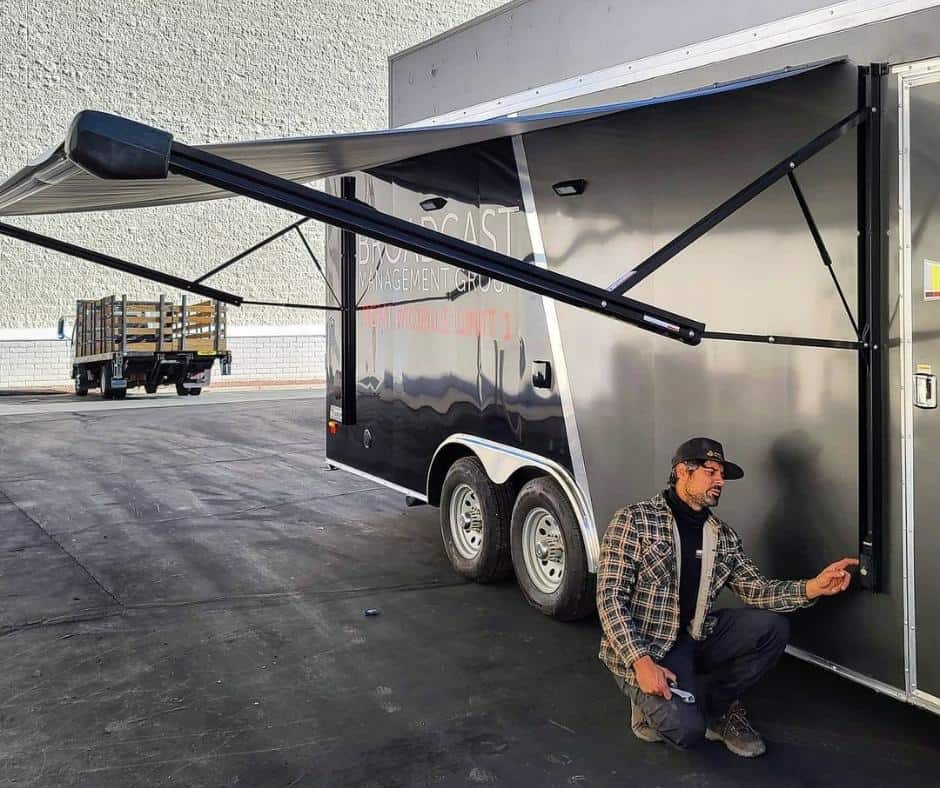
Awnings can create a great shaded outdoor space, but repairing or replacing them can be costly.
While repairs can easily cost $600, new awnings can cost over $1,000. Maintaining your RV’s awning helps to prevent rips and tears as well as mold and mildew that can cause damage.
After any rainfall, be sure to let your awning dry out completely prior to rolling it in.
When this is not possible, remember to pull it out to let it dry as soon as you make it to your next spot.
Be sure to also brush off any debris that collected on the awning to avoid sticks and branches from poking through.
RV Connections to Tow Vehicle
If you tow a fifth wheel or travel trailer, it is important to check the electrical connection between your tow vehicle and RV.
This connection is what will power the brake lights and blinkers on your RV, both of which are important safety features.
The electrical connection will also charge your RV’s battery as you travel , which is especially important for anyone planning to boondock without an external electric source.
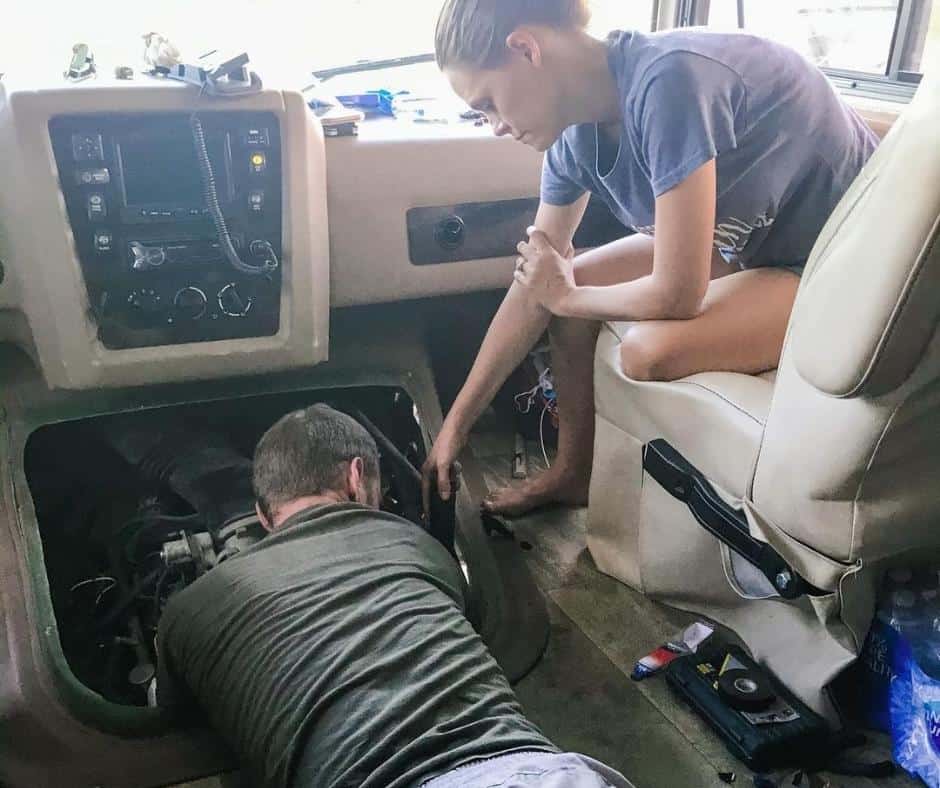
Under the Hood
Before each trip, take a quick look under the hood. Check for loose or broken belts, clamps, and hoses.
Also check for leaks, and top off any low fluids. A quick peak under the hood to make sure everything is in place can prevent some serious problems like overheating of the engine or transmission.
Semi-Annual RV Maintenance Checklist
Some RV maintenance should be conducted a couple times a year as certain elements begin to wear out.
These semi-annual RV maintenance task can also keep your RV running properly by preventing buildup and clogs.
Water Tanks
Maintaining your RV’s water tanks will keep them clean and unclogged. The steps taken to do so will depend on which tank you are treating.
For gray and black water tanks , there are specialized chemical treatments that will break down and flush-out any buildup.
Flushing your tanks regularly will prevent potential clogs and valve damage.
Although they will not experience buildup in the same way gray and black water tanks do, fresh water tanks also require maintenance.
It is difficult to know exactly how clean the water at various campgrounds is, but flushing the fresh water tank with bleach will kill unwanted microbes and rinse out any growth or mineral buildup.
Just as with other vehicles, motorized RVs require regular oil changes. How often you get an oil change, however, will depend on how much you use your RV.
If you take it out once or twice a year, changing your oil seasonally should suffice.
For those who go on regular outings, a good rule of thumb is changing your RV’s oil every 3,000-4,000 miles.
All batteries have a lifespan. Testing them regularly will ensure that you don’t get stuck with a dead battery as you head out on your next trip.
Deep-cycle batteries like those found on towed trailers tend to lose capacity after about three years, while start-type batteries that are found in motorized RVs keep their capacity for up to five years.
Lead acid batteries that are commonly found in older RV models have water levels that may need to be topped off.
Be sure to only use distilled water when topping off batteries because even the cleanest tap water has minerals that can leave deposits in the battery.
When checking your batteries, also check that all connection points are secured properly without damage or corrosion.
Moisture, debris, and movement from traveling down the road can all lead to frayed wires and failed connections.
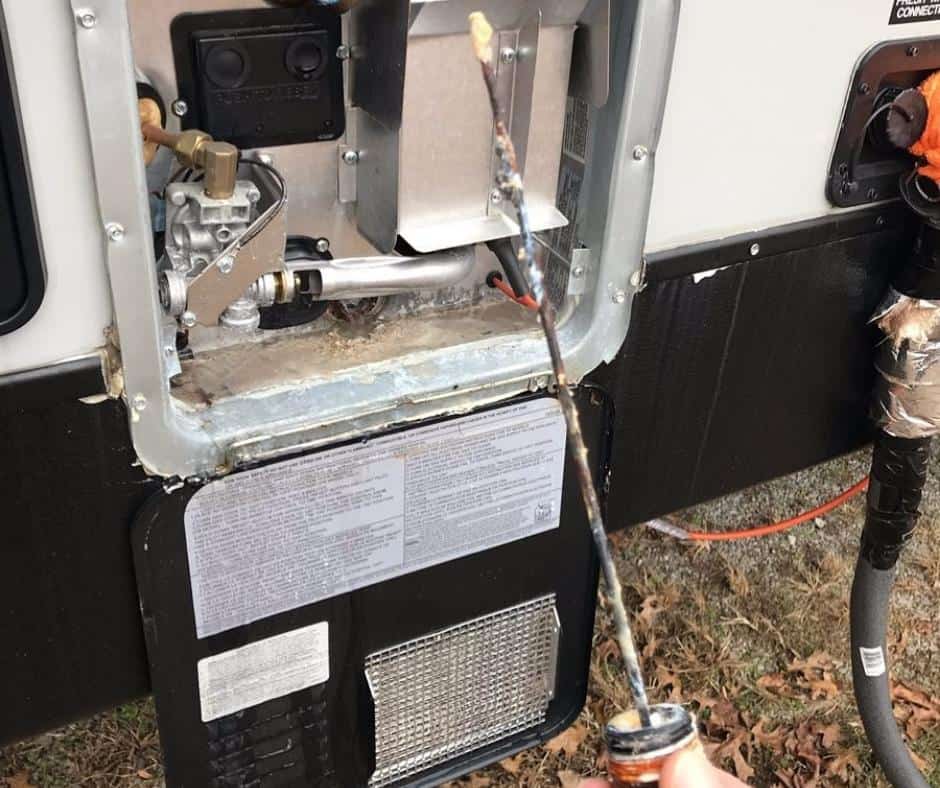
Water Heater
Many water heaters use filters that help to provide clean water. These filters tend to last around six months before needing to be replaced.
Water heaters are also susceptible to rust and corrosion caused by heat, acidity, and oxidation.
Installing an anode rod will attract much of this corrosion to the rod and prevent it from affecting the water heater.
This paired with a semi-annual flush will keep your water heater in its best condition and will keep your water clean.
Electrical System
RVs run on two separate electrical systems. A 120-vold AC system connects to an external electrical source to power larger appliances like the AC unit, electrical outlets, and microwaves.
A 12-Volt DC system connects to the batter to power appliance needing less power, such as lights, water pumps, and televisions.
Running a basic safety test on your RV’s electrical system requires connecting to shore power.
Turn on and test all appliances and unites requiring power. If you find any that aren’t working, check that all fuses in the circuit breaker are connected properly.
Further issues with the connections of any of these fuses may indicate a larger electrical issue and should be addressed by a professional.
Annual RV Maintenance & Spring Cleaning
Some RV maintenance checks on components that wear out slowly over time can be performed once a year.
Although they may not be as pressing as some of the aforementioned steps, the following annual maintenance checks and and cleaning tasks will keep your RV fully functional and will prevent some unwanted malfunctions as you travel.
Working breaks are crucial for road safety. While breaks should be tested before each trip, a closer look should also be taken at the wheel bearings and brake pads at least once a year.
Pack wheel bearings so they are lubricated for the year to come, and make sure that the breaks still have a sufficient padding left on them.
If you happen to need new brakes, this generally includes a repacking of wheel bearings as a package deal.
Roof Seals and Seams
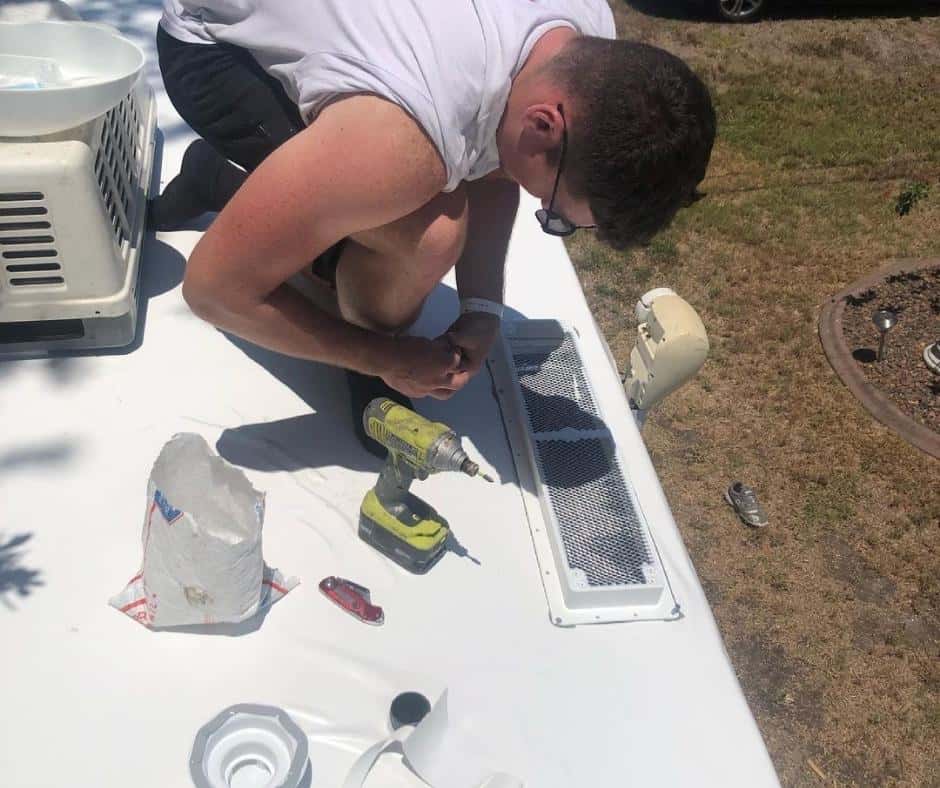
RV seals and seams dry out over time from the Sun’s rays and can get pulled and stretched from the moving and shifting that occurs while traveling.
These can lead to leaks, cracks, and even unwelcomed creepy crawlies. By checking your roof seals and seams regularly, you can prevent sneaky water damage that can cause rot as well as mold and mildew.
It is important to choose the right type of sealant for your needs . Doing so will ensure that everything will seal properly, and that it will last.
To choose the right type of sealant for your RV, consider the following factors:
- Type of material
- Area being sealed
The Climate
Humidity levels as well as extreme hot or cold temperatures can affect the type of sealant that will work best for your RV.
Sealants with UV protection do best in sunnier areas, whereas wetter climates will make mold and mildew a greater concern.
Type of Material
Knowing the type of material that you are sealing can help in determining the right sealant to choose.
This primarily applies to sealing RV roofs, as roofs are commonly made from one of the following four types of materials:
- EPDM (Rubber)
Area Being Sealed
Roof sealants will differ from those needed for the seams of your RV, so it is important to choose the right sealant for the job. Roof sealants come in the form of:
- Self-leveling
This type of sealants can be used to seal leaks and cracks in the roof, as well as cracks and gaps around vents and AC units.
It is important to consider the amount of sun and water exposure your RV will get in order to choose a sealant that will protect your RV’s roof from further damage in the future.
Sidewall and corner sealants tend to be puddy and caulking. Puddy can be found under moldings and around cut-out holes such as those for windows and vents.
These seams are then also caulked from the outside. While caulking can patch holes and cracks, older vehicles may also need the base puddy around those seams redone.
Propane System
Propane plays a key role in RVs by providing:
- Heat for the furnace
- Powers for water heaters and refrigerators
- Fuel for stoves and ovens
The rattling and vibrations that occur while driving can damage pipes and loosen fittings.
When checking the propane system, look for leaks, rust, and any place the system is not connected properly.
An annual Timed Pressure Drop Test should also be performed by a qualified RV technician.
This test involves using a manometer and a specialized propane test device to test if the pressure of the propane cylinder drops when these devices are connected.
Any drop in the pressure is an indicator that there is a leak somewhere in the system. This test should also be performed any time you smell propane and suspect a leak.
Air Conditioner
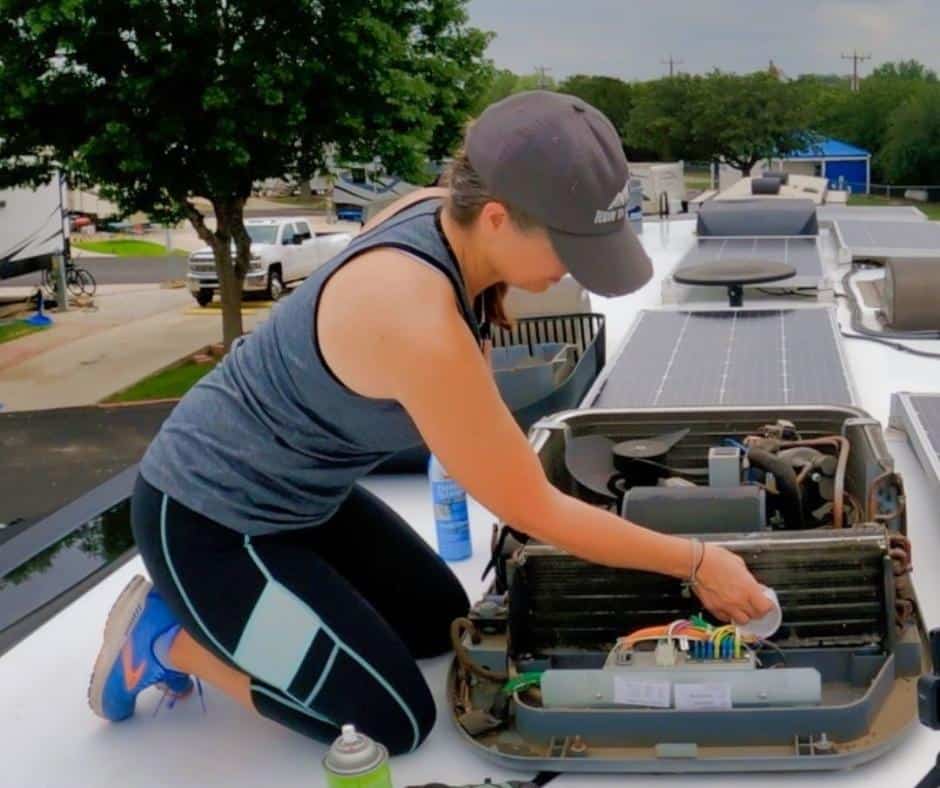
Your RV’s AC unit should be checked at least once a year to prevent leaks and debris from getting into the unit.
Checking the air conditioner requires climbing up on the roof to inspect the unit from the top.
Take off the cover to ensure that all cooling fins are straight and pointing in the same direction.
If you find that some are bent, you can gently brush them back into the proper condition or else they will prevent air from properly flowing through the unit.
When replacing the hood, make sure that it fully covers the unit and seals snugly to prevent moisture and debris from getting in.
Air conditioners should also be inspected from the interior of the RV. The filter can carefully be reused after being cleaned with soap and water.
While the filter is removed, vacuum as far into the duct as possible to clear out any dust and pollen.
sensor Detectors
The two main detectors found in RV’s are smoke detectors and carbon monoxide detectors. Test buttons can be found on the sides of both devices.
Deep Cleaning
Deep cleaning your RV before it is stored away for an extended period of time, particularly before it is winterized and put into storage for the cold season, will keep it in its best shape until its next use.
A thorough deep clean can prevent moisture from leaking into the RV and causing water damage, mold, mildew, and rust.
It can also keep critters from claiming your RV as their home, and it will save you time and effort when preparing for your next trip.
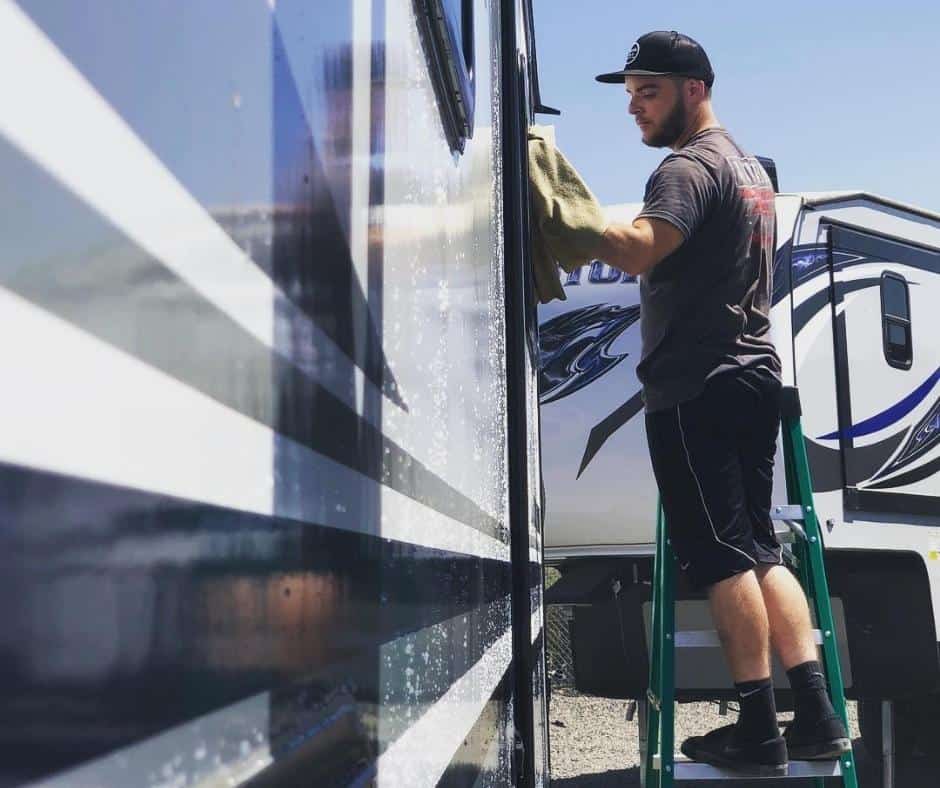
Waxing the exterior of your RV doesn’t only keep it looking its best, but it can also help to prevent deterioration caused by:
- Dirt and grim
- The Sun’s UV rays
Standard car wax works great for painted RVs, whereas a specialized RV wax should be used on fiberglass surfaces.
Tips for Maintaining Your RV
Expert RVers will know that there are some tricks to proper RV maintenance. Along with following the above checklist, taking a couple additional steps will keep you organized and prepared on the road.
Keep a Maintenance Log
Keeping a log of the maintenance performed on your RV is not only useful for owners, but it can be highly beneficial when considering insurance or resale.
An up-to-date log should be complete with the following:
- The date that the maintenance is performed
- The checks that were made
- Whether or not the RV passed each check
- Any replacements or repairs performed
Recording these details in a notebook or binder is an easy way to track the condition of your RV.
Stock an Emergency Toolbox
Carrying a stocked toolbox can save you time, money, and a lot of hassle if anything goes wrong on the road.
Depending on the issue, having the right tools on hand could save you a trip to the repair shop, getting you back on the road more quickly and potentially saving your trip.
Along with basic tools and parts, it’s a good idea to keep small bottles of all essential fluids on hand.
RV Maintenance Checklist for Before You Hit the Road
Along with performing routine maintenance on your RV, creating a routine checklist before each time that you hit the road will prevent accidental damage from oversights such as forgetting to turn off appliances or leaving doors and windows ajar.
The following points serve as a checklist that can be used each time you get your RV ready to travel.
- Roll in and properly stow the awning
- Ensure that all jacks are lifted completely
- Do a walk around your RV to check that all tires are inflated and appear to have equal pressure
- Turn off gas and water heaters
- Take down or lower the satellite and/or antenna
- Remove and stow drain and fill hoses, and ensure that all caps have been replaced
- Remove and stow the water pressure regulator
- Disconnect and stow the external electrical cable
- Close and lock all external storage compartments
- Turn off the furnace to prevent overheating and potential fires
- Turn off the water pump
- Make sure the refrigerator door is fully closed and that the setting is set to gas or automatic. This keeps the refrigerator cold while being disconnected from electrical power
- Make sure all pilot lights on your stove and oven are turned off
- Close all windows and vents
- Close all internal cabinets, dressers, and drawers to keep things from falling out while in transit
- Secure loose items by setting them on the floor, into sinks and bath tubs, or in storage boxes
- Close and lock your entry door
- If you have a towable RV, make sure that the hitch (as well as the sway bar and weight distribution hitch, if applicable) are secured properly
- For towable RVs, also ensure that no wires connecting the RV to the tow vehicle are clamped or at risk of getting caught in the hitch while in transit
final thought about RV Maintenance
Proper RV maintenance requires a long list of steps and checks, but is an essential part of keeping your RV in its best possible condition.
Although this long RV maintenance checklist may at first seem daunting, these steps will quickly become second nature the more you go through them.
About Author / Aaron Richardson
Aaron Richardson is an expert RVer and the co-founder of RVing Know How. Aaron, along with his wife Evelyn, has been living and traveling in their Keystone Fuzion RV since 2017. Their adventures span across the country and beyond, including memorable RVing experiences in Mexico. Aaron's passion for the outdoors and RVing shines through in his writings, where he shares a blend of travel stories, practical tips, and insights to enhance the RV lifestyle.
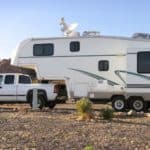
What to Do When Your RV Slide-Out Sections Goes Out But Not Back In
How to choose the best rv battery monitor for 12v electrical systems.
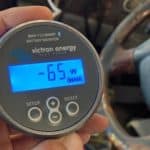
Leave a Comment Cancel reply
Your email address will not be published.
Save my name, email, and website in this browser for the next time I comment.
You Might Also Like
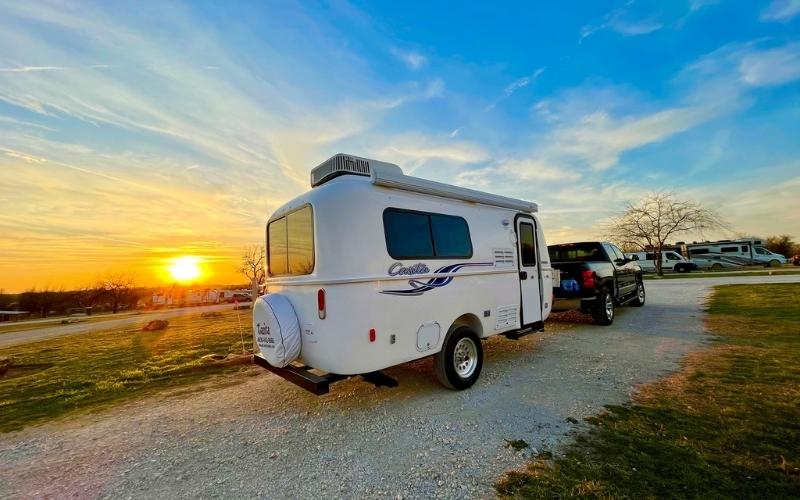
Casita Travel Trailer Review: Are They High Quality?
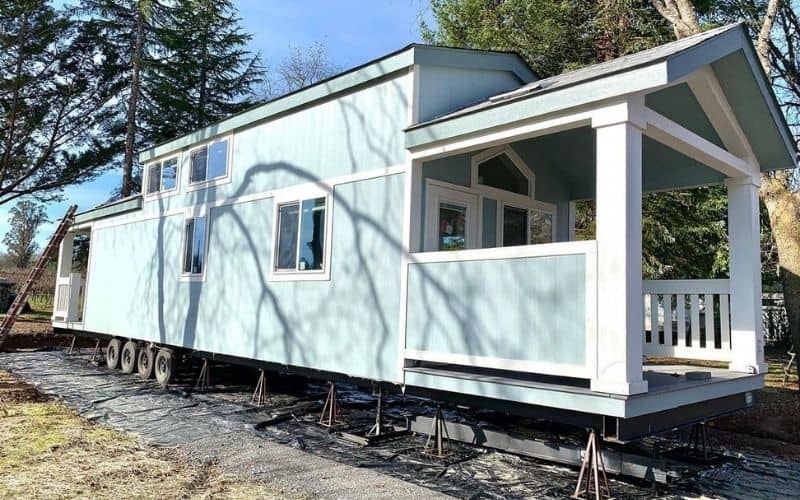
Park Model RV Is The Long-term Living Setups You Will Love!
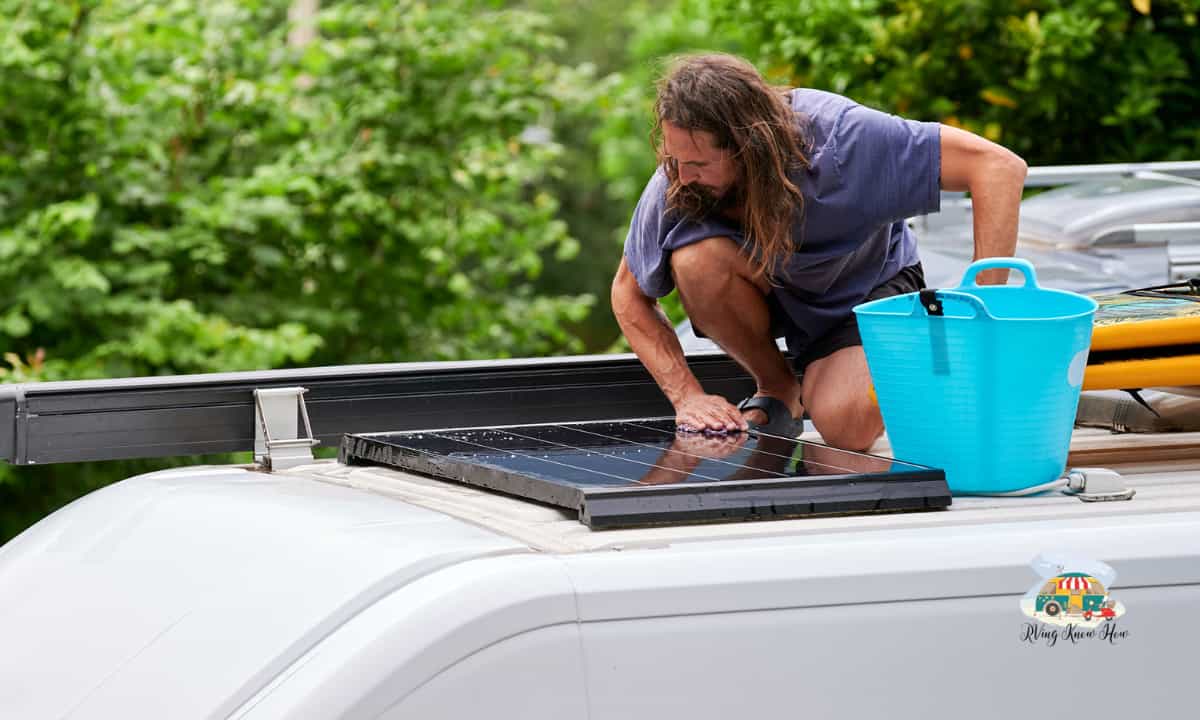
Will Rv Batteries Freeze When Plugged In
Start typing and press Enter to search

14 Crucial RV Maintenance Tips (Complete Guide)

- BEGINNERS GUIDE
G. Yoganand
Whether you own a travel trailer, motorhome or a fifth wheel, its maintenance is important. RV or camper has so many components, parts and appliances that you cannot ignore one aspect of it.
That’s all makes it a RV. A home on road which gives equivalent comfort.
For an uninterrupted fun, strictly follow a maintenance schedule. The annual schedule can include checks on the tires and the RV battery, oil changes, and checks on parts of the RV.
In this article let go through a comprehensive checklist for maintaining any type of RV .
So, where do you start? How do you maintain an RV?
Lets go through different aspects, appliances and components of RV and their maintenance.
Keep Tires Properly Inflated
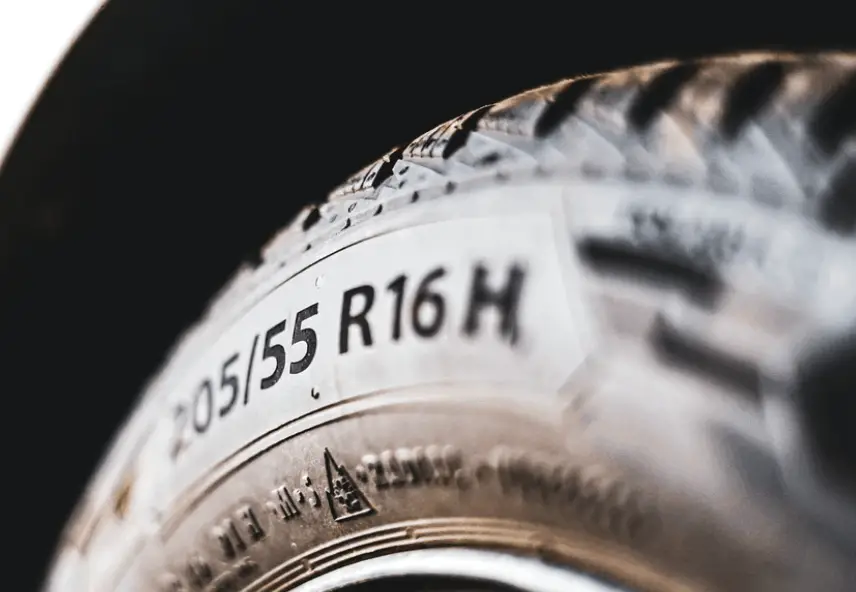
An RV is made of so many important parts which makes it difficult to name one specific critical part of the RV. The RV tires are one of these essential parts.
The tires take the load of the RV making it possible for you to enjoy those fun road trips. There are several ways how you can protect the camper tires . Below are some tips on how you can ensure your RV tires are in their best shape at all times.
- Inspect tire sidewalls for any cracks and splits. Cracks are great signs of a aging RV or motorhome tire. Do this check every time you head-out for a trip.
- RV tires should be inflated properly. Under inflated tires is a major cause of tire failures. Make sure you check the tire pressure every time before starting the journey. Do this even for spare tires as well.
- Rotate tires from time to time. This helps in even wear and tear of tires and you end up up having one tires completely worn out.
- Covering the tires can help enhance their life. UV radiation do affect tires and stopping that is only wise. Lifting the tires and covering them in storage is also advisable.
- Avoid Overloading your RV
- Always make sure you are carrying an even load with your RV before setting off. Even though carrying lots of stuff on your trip is fun, this can overload the RV hence straining the wheels.
You want to avoid this because when the RV is evenly loaded, you can economize fuel, avoid tread wear and handle the RV better.
Thus, before starting the trip, weigh the RV on a CAT scale and check the weight on each tire. Do this after packing the motorhome or camper with everything you are taking with you on the trip. Ensure the weight does not exceed the Gross Vehicle Weight Rating (GVWR).
Make Sure RV Batteries Do Not Loose Their charge below 50%
Did you know that RV batteries that are well-maintained can last for up to 6 years? However, some RV batteries are replaced every year. One of the ways to extend your RV battery life is by properly charging it.
- Make sure Battery does not loose its charge below 50%. A fully charged battery has around 12.7 Volts. This is one of prime reasons why battery fails early. When you recharge the batteries from time to time helps in preventing sulfation in batteries.
- Similarly high temperatures and overcharging also kills the battery.
- Keep the vent caps on battery open while charging this prevents water loss due to bubbling.
To properly charge your RV battery, you need to do so in stages. Three stages should be involved when charging a battery. These stages are as follows:
Bulk charge – This is done when returning the battery to about 90% of its full charge. This is usually done during the initial hours of charging the RV battery.
Absorption charge – This is done once the battery attains 90% of its full charge. Absorption charge is done to fill up the remaining 10% of the charge and also to prevent loss of water and battery gassing.
Float charge – This stage is done for the sole purpose of maintaining the full charge.
Many RV battery charges are three-stage chargers, but not all of them. If your battery charger is not a three-stage charger, be sure to get one that is so you can be sure your battery is charged properly.
Run RV generator often enough
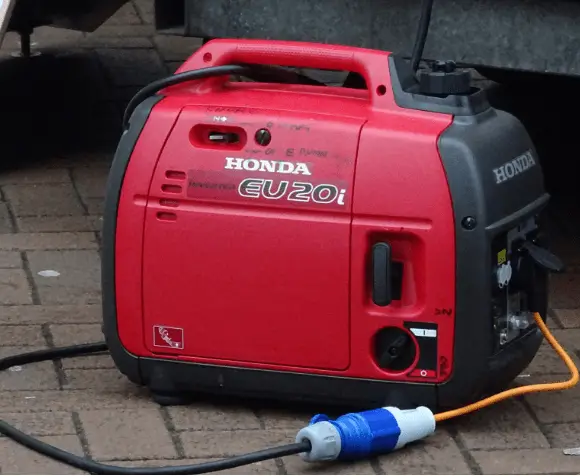
One of the best tips to ensure your RV generator stays at top shape is to run it often. You need to frequently run it even if you are not using it.
You can run the generator for about two hours and then repeat the same after a month. Most generators use gasoline as fuel and leaving the gasoline to sit for long periods of time without using it can make the gasoline go bad.
Some other things you need to do include,
- Replace oil and coolants after designated hours or years. This can be around 1-2 years or 100-150 hours depending on the model and watts.
- Check for fuel leaks.
- Do a visual inspection every 300 hours or so
- Run the generator under load once in a while.
Read : Tips to maintain an RV generator
Make Use Of Rug To Keep Floor Clean
You may be camping but that does not mean that you can be un-tidy. Keeping your RV floor clean and tidy is one way of ensuring you maintain cleanliness as well as prolong its lifespan.
Get a Rug : One thing you can do to ensure the dirt stays outside the RV is to get a good rug to lie outside.
You can then set up your outdoor living area on the rug outside the motorhome. If the area weather allows it, this can be a great way of ensuring your RV floor is free from constant use which makes it susceptible to damage.
Additionally, you can place small rugs at strategic areas in the RV such as the entrance of the RV and the areas with the most traffic.
Do not forget to replace the RV carpet with the vinyl flooring if your RV features an already-installed carpet. Vinyl flooring is easy to clean, lightweight and inexpensive.
Also, to ensure your RV floor is always at the best shape, you need to frequently check for wears and tears.
Another thing about floor is never keep the floor wet. Dry it as early as possible .
Inspect Roof Often and Keep It Debri Free
Without any doubt the RV roof is one of the most important parts of the RV.
You cannot go on the trip if your RV roof leaks. The roof protects you from the harsh weather elements such as rain, sunlight, as well as cold snow and ice.
You want to make sure your RV roof is good before you set off, otherwise, your camping experience can be ruined when you begin to observe leaks as it rains outside.
- Inspect the roof often enough to identify any cracks and gaps well before they become big. A damage not identified early will need bigger repair later on.
- Seal the cracks using adhesive that better suits your rv roof material . Caulking and coating from time to time really helps in enhancing the roofs life.
- While walking on roof is fine do not overdoo it. It has a limit upto which it can support the load.
- A roof hold a lot of things like skylights, air conditioner, vents. These can cause mold at edges and get dirty. So, inspect everywhere on the roof and apply caulking after good round of cleaning.
Cleaning : Keeping your RV roof clean is one of the most essential maintenance steps. You should clean your RV roof at least three times every year. Before cleaning, first get rid of any debris including leaves on the roof.
Washing the roof : Make sure you do not pressure wash the roof too often. Rubber roof are susceptible for damage if you go harsh. Do not use harsh products for washing.
After removing the debris and the leaves or branches, sweep off the remaining loose dirt and then spray the roof with water. Since this is a messy situation, be sure to stay away from homes or objects that can get easily spoiled. Cleaning the RV roof at a car cleaning site is recommended.
Read : Can you pressure wash a RV?
After spraying the roof, use a mop or a cleaning brush and soap and start scrubbing the roof. Be sure to select the right cleaner for your type of roof and wear protective gear as you clean.
Keep RV Interiors Clean
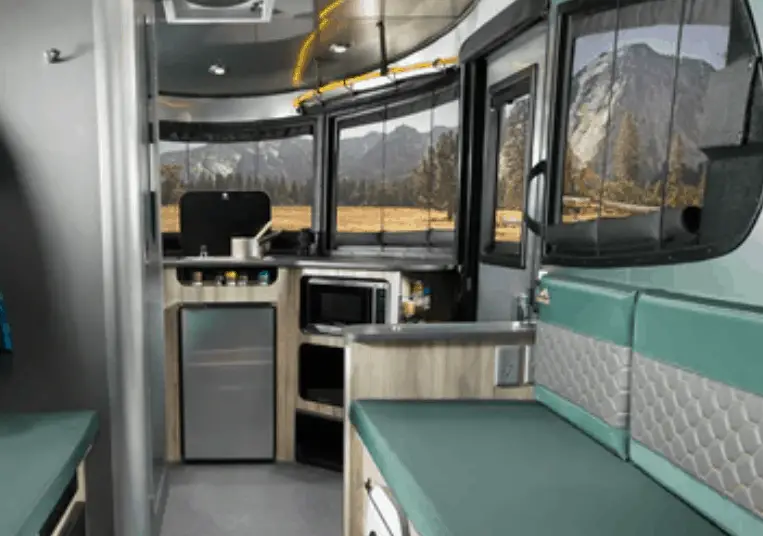
One way of maintaining your RV interiors is by keeping them clean at all times. For windows, you need to keep them well-sealed in addition to keeping them clean.
When they are well-sealed, you can prevent leaks as well as water damage.
To properly clean your windows, you need to invest in some good cleaning materials. These materials include a super fine steel wool and a residue-free glass cleaner and a reach and clean tool for those difficult to reach areas.
Furthermore, avoid cleaning your RV windows in the blazing sun since the sun can cause the cleaning agents to dry fast leaving streaks or water spots on the glass window.
It is advisable to clean the windows in the morning, evening or in the shade.
Clean Kitchen and Bathroom Often
The RV kitchen and bathroom are among the most used areas of the RV. Thus, the two areas have to be at their best shape so you can continue to enjoy your trip without any stress.
The cooktop is one of the most used parts of the kitchen. This is where you prepare most of your meals, if not all. Thus you need to ensure it is well-maintained.
Stove and Oven liners : One of the easiest ways of maintaining the kitchen is by getting stove and oven liners. The stove and oven liners will help you keep your kitchen clean as well as maintain the stove and oven.
To use them, simply press them down on the stove or oven. Once the stove or oven gets dirty, you simply peel off the liner. This will help you save the time that you would have spent cleaning up the mess. You can then use this time to enjoy the trip. Additionally, the liners help prevent staining on your RV stove or oven.
For the bathroom, you can maintain this crucial area by regularly cleaning it and checking for any leaks.
Keep RV organized
Just because you are camping does not mean that you have a pass for being untidy. You can make your RV organized and cozier by adhering to a few tips and tricks.
One of the tips is designating a specific place for specific items.
And everything’ here means everything. This includes the keys, fly sweater, the helmets of your bike (if you have one).the RV trash can and the loose change. Doing this is the right step in getting your RV organized.
Inspect RV Air Conditioner For Leakage

When enjoying the camping experience, the last thing you need is to keep sweating because of a faulty Air Conditioner (AC) . A poor AC can easily ruin your RV camping experience which is why you need to ensure it works perfectly before setting off.
- Inspect RV cover for any cracks or splits. Its the part that has to deal with outer elements like wind, sun and dust.
- Check for any loose connection between the AC and the roof. The rubber gasket between the ac and roof can loosen up resulting in water leaking. Water damage is something can lead to bigger problems so better be proactive in identifying this.
- RV air conditioner cannot be recharged and thus repairs are costly. Therefor you should make no mistake while operating this appliance in RV.
One smart tip of maintain your RV AC is by managing the thermostat settings of the AC.
One way of doing this is by setting the AC to n’ instead of setting it at a low temperature. By doing this, the AC will automatically adjust the temperature when it achieves the desired heat or cold and distribute the cool air in the RV.
Managing the AC thermostat settings helps prevent overloading the RV capacity and ultimately prolong the lifespan of the AC.
Read : A complete guide on how to maintain an RV AC
Proactively Hunt For Water Leaks And Damage
You may have checked your RV for leaking spots while cleaning it, but this is not enough. One smart tip for ensuring your RV is free from the annoying leaks and damage is by thoroughly checking for the damage and leaks.
Mold : Water damage can result in molds and mildew and the cleaning can get real tough.
You can do this by running your hands along the door jamb, window seal as well as the slide-out seam. Do this on the inside as well as the outside.
After checking these areas, go on the RV roof and check for leaks and damage by pressing the seals gently using your fingers. Check for any holes and in case you find one, arrange to fix it as soon as possible.
Nevertheless, make sure your RV roof was built to withstand your weight. Otherwise, you risk winding up in your R V living room with a skylight overhead.
Maintain Slide-Outs For Better Functioning
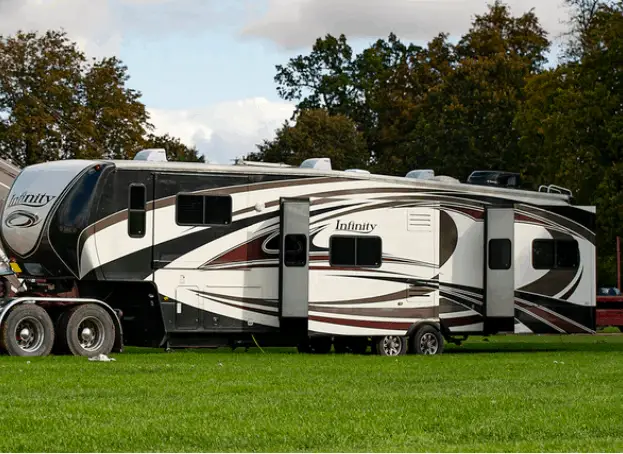
Maintaining the slide-outs is all about taking some preventive measures. One of these measures includes regularly inspecting the slide-out seals.
Lubricate the slide-outs for better functioning.
The seals are responsible for preventing debris as well as other elements from entering the RV. You need to inspect them for any wear and tear so they can be at their best shape.
In addition, you have to frequently clean the seals to avoid dirt and other debris from building up along the tracks. When the dirt or debris builds up along the tracks, the slide-outs can easily fail to function properly.
Sanitize And Keep Water Pipeline Leak Free
You may fall under the category of people who do not have to worry about their supply of water because the taps are constantly running and full of water.
However, when you are in an RV the story may be different without taking the necessary measures.
The RV water system is not connected to any plumbing grid. Thus, you need to connect your RV to the city water using a portable water hose so you can fill up your water tank as you head for the road.
Sanitize : One of the best ways in ensuring your RV water pipeline water system is in the best condition is by frequently sanitizing it and checking for any blockage and leaks.
Maintaining the RV waste water system is also important. Make sure you flush the grey and black water systems often. Use products that are not harsh and avoid chemical that are not recommended by manufacturer.
Change Air filter, Oil and coolants
Inspect air filters, coolants and other hydraulic filters and replace them as needed. Oil should also be changed during your schedules maintenance.
A professional technician can help you with this. Every manufacturer will have a designated number of miles after which it has to be done.
So, do check in the manufacturer manual for this. Same with RV brakes as well,do consult your RV professional on when to replace them.
Follow Maintenance Schedule
Basically, your RV maintenance can be equated to that of your car. Thus, if you have a car, maintaining your RV will not be that difficult. RV maintenance involves checking the generator, the battery, the seams and seals as well as the roof.
A lot RVs stay idle during winter season and go into storage. You should properly sanitize all the water systems and store the RV with full protection in storage.
Since the RV is not used as often as the other vehicles, make sure you start and run it for a few hours once a month . This will keep the engine in good shape and avoid any problems that may occur when the RV sits for a long period.
Also, cleaning the RV should be part of your RV maintenance schedule and this can be done at least three times a year when the RV is not in use. As you clean it, you can also check for other damage and leaks.
As seen from the above text, maintaining your RV is not difficult and does not take much of your time. All you have to do is to be thorough whenever you do any checks or clean the RV.
Cost of RV maintenance
RV Maintenance cost can vary depending on what type of RV you have. A Motorhome like class A or class C will have bigger needs as compared to a small pop up camper.
If you own a standard RV like travel trailer or a class B Motorhome expect to spend anything around $400 to $1200 per year on maintenance.
Having said this, it obviously will depend on lot of factors.
It also depends on how old your RV is. With more years the maintenance will also be more. For example, RV roof initially will not need much maintenance but with years the cost will increase.
In Consluion:
Maintaining an RV can be hard but if you take it step-by-step and each thing at a time, it can be much easier. Getting professional help is also key. As a new RVer you may not have experience with dealing things. Get the required help initially and once you are accustomed do the preventive maintenance, you will be better at it. As they say, you learn a lot with experience.
You Might Also Like
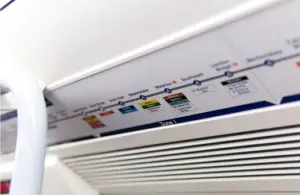
How to make RV AC more efficient

What amp surge protector do I need for my RV?

Fiberglass vs. Aluminum RV (Pros and Cons)

24 practical tips for camping in a pop up camper

This post may contain affiliate links or mention our own products, please check out our disclosure policy .
Travel Trailer Maintenance Tips
Published on June 8th, 2018 by Ray & Tammy Roman This post was updated on August 7th, 2022
Like any other vehicle, travel trailers need care and maintenance. The last thing you want is your travel trailer or any of its systems to break down during a vacation or weekend getaway. Here are some travel trailer maintenance tips to keep your RV looking great and keep you safe on the road.
Major steps to help you take care of your travel trailer
- Exterior routine inspection and maintenance
- Wash the exterior
- Avoid power washers
- Interior routine inspection and maintenance
- Interior vacuum, dust, and wipe
- Clean floors
- Clean bathrooms
- Disinfect counter-tops
Detailed steps are provided in the travel trailer maintenance guide below.
We are going to g over what you need to do to keep your travel trailer in optimum operating conditions. We have separated this guide into the following sections. Exterior, Interior, Systems, and Winterizing. Let’s begin.
DON’T MISS OUT ON RV LIVING UPDATES
Sign up for the newsletter today.
Please enter a valid email address.
An error occurred. Please try again later.

Thank you for subscribing to the RV Living newsletter, keep your eye on your inbox for updates.
Travel trailer exterior care.
Taking care of the exterior of your camper involves a routine inspection, preventive maintenance, and cleaning.
Routine Inspection
Walk around the exterior of your travel trailer and look for the following:
- Loose or missing screw or nuts
- Deteriorating rubber seal around storage panel, hose inlets and outlets, and other areas where seals are used.
- Check around the perimeter for damage or obstruction if your travel trailer has a slide-out. Even though it’s part of the systems check can take the time now to make sure your slide-out is operating smoothly.
- Check for cracks in the fiberglass if you have it, and check for signs of rust
Once you are satisfied everything is in order, and no repairs need to be made, it’s time to wash the exterior of your travel trailer.
How To Wash Your Travel Trailer
To wash your travel trailer, follow these simple steps.
- Use a soft-bristled brush. A soft bristle brush is recommended since you won’t damage the exterior of your travel trailer. Get a brush that has an extendable handle for those hard-to-reach places.
- For a rubber roof, use a cleaner that will help protect the roof from the sun.
- Use a soap designed specifically for the vehicle or travel trailers. You don’t want anything harsh that may damage the paint and seals.
- Keep your slide-out running smoothly by using a slide-out lubricant.
- After you have completely washed your travel trailer, let it dry fully.
- Apply a coat of wax to all exterior surfaces. Don’t wax in direct sunlight; only do it after the surface of your travel trailer has cooled.
Can I Pressure Wash My Travel Trailer?
One of the questions I am often asked is if you should power wash your travel trailer. In our opinion, you should not, since a power washer is typically too hard on many of the seals and surfaces on a travel trailer.
The only place we would use a power washer would be a rubber roof, and even then, with extreme caution, and the tires.
Travel Trailer Interior Care
The interior of your travel trailer needs just as much care as the exterior as you spend quite a bit of time in it. Keeping the interior clean will make your travels comfortable and healthy.
You don’t want an unhealthy, smelly, or unsanitary living environment in your RV so take the time to clean the inside properly.
It won’t take much but some elbow grease and typical household products, so let’s get started.
Vacuum, Dust, and Wipe
The best tool to use for vacuuming the interior of your travel trailer is a small portable vacuum with an assortment of attachments. Black and Decker portable vac that we highly recommend. It’s affordable and works very well.

- Handle quick pick ups on hard floors and carpet with plenty of suction from the high performance motor
- Included Components: Jack plug charger, 2 in 1 nozzle/flip up brush, crevice tool, BDH200FVPH pet hair brush, PVF110 washable filter, washable plastic pre filter, clip on accessory...
Last update on 2024-04-24 / Paid Affiliate Link / Images from Amazon Product Advertising API
You will also need a duster, preferably one with a long handle to get to those hard-to-reach places.
Use the vacuum on your floors, drapes, blinds, and upholstery. Use the vacuum attachment vacuum drawers, inside cabinets, along with window edges, and just about any nook and cranny you find.
Once you are done mopping, use a good disinfecting antibacterial wipe on your countertops and cabinets. This will make for a safe food prep environment.
Wet mop floors (tiled floors, bathroom floors) using a household floor cleaner, preferably a no-rinse cleaner. You can go over the floors again with a squeezed mop so your floors can dry a bit quicker.
You can purchase cleaners specifically for the surfaces you will find in a travel trailer bathroom. They might not contain any harsh bleach or abrasive that can damage the surface.
For the shower, use a squeegee, and wipe all surfaces and fixtures with the cleaner you purchased. Use a scrub brush and cleaner for the toilet, and you should be good to go.
Prepare For Your Trip
Before you set out on your trip, you should check a few things. Check your fluid levels, including your grey water tanks, battery acid, LP gas, and black water tanks.
Having RV batteries that are in good condition is important for any trip you take. I wrote an article on the best RV battery for your RV. I think you’ll find it helpful.
Every travel trailer should have a fire extinguisher; if yours does not, go ahead and add one. It’s a good safety item to have. Make sure you check the fire extinguisher often. You should also have an LP gas leak detector in your travel trailer.
Check it often, about every three months, along with the carbon monoxide and smoke alarm batteries. Do not neglect this as it can save your life.
Before you hit the road, inspect the tires carefully and repair or replace them as needed before you load up. Tires can easily start to crack and rot from sitting in the sun. Think about purchasing RV tire covers; they will prolong the life of your tires.
Before pulling out of the driveway, inspect all your mirrors to ensure you have good visibility around your travel trailer. Make sure you know your blind spots before you also hit the road.
If you tow a travel trailer, check your towing equipment and hitch. Maintain it as necessary. Inspected it regularly and grease if necessary
Just like an automobile, your travel trailer has lights that need to be inspected. Ensure the brake light is working properly as it is one of the most important lights on your travel trailer.
Another major item to inspect, which many people forget, is your roof. Sometimes low-hanging branches cause damage to the rooftop. Make sure you inspect it and make any necessary repairs.
If your travel trailer has an awning, ensure it is in working condition and has no tears. To avoid mold and mildew, let it dry before rolling it up.
How To Clean Your Travel Trailer Awning
Before cleaning your travel trailer awning, you need to know whether it’s a fabric awning or vinyl. Cleaning and caring for your fabric awning will be different than your vinyl awning.
Fabric Awning – This breathable material can withstand UV rays and is designed to dry quickly. Fabric awnings have a special finish that makes them water and oil-based stain resistant. This finish can fade over time. If not treated, a fabric awning will become permanently soiled and can leak.
Vinyl Awning – When cleaning your vinyl awning, do not use any cleaners that contain bleach or harsh chemicals. These are harmful to the vinyl. Not using these harsh cleaners will extend the life of your awning.
Wash your awning with a high-quality cleaner made to work on outdoor vinyl. We recommend this cleaner.

- Cleans and brightens – Recommended by Sunbrella, a leading outdoor fabric manufacturer, 303 Marine Multi-Surface Cleaner provides the ultimate cleaning power for all water safe...
- Rinses residue free – This multi-purpose detailing spray easily removes dust and dirt from your prized marine possessions. Simply spray on and wipe off with a microfiber towel, and...
Once you have thoroughly washed your awning, let it dry and treat it with a surface protectant made for vinyl like this one.

- Ultimate Protection – Superior protection against UV rays, dust, dirt, salt water, and staining keeps your products looking like new by preventing fading and cracking
- Non-Greasy – Dries to a smooth matte finish that blends in easily to maintain a like-new appearance, texture, and color with no oily or greasy residue
Regularly reapply a coat of the protectant spray so your awning stays cleaner longer.
10 More RV Maintenance Tips
The following ten travel trailer maintenance tips can ensure the longevity of your vehicle and boost its performance, ultimately saving you money on repair or replacements.
1. Check the Roof
The roof of your travel trailer is mostly overlooked by many of us. Travel trailer roofs are made from materials such as rubber and fiber class.
The maintenance will be done depending on the material. In addition to regular maintenance, you must check your roof before every trip to find any leaks or cracks.
If there is any, fix it fast before heading towards your destination. You can use sealants to patch the RV’s roof leak. Make sure that the sealant is compatible with the roof material.
For regular maintenance, inspect the roof every three months. Check the roof edges, skylight, vents, or air conditioning unit for leaks.
2. Tighten Wheels
Your travel trailer is simply a house on wheels. The wheels are exposed to road conditions during trips. Regular traveling or traveling in unfavorable conditions can make wheels lose.
Therefore, you should always keep a screwdriver and wrench to tighten your wheels whenever required. Pay attention to finding out the things attached outside that might cause a security risk.
Driving with loose nuts or wheels can cause accidents, and you might lose the wheel on the road. Just imagine what will happen if your vehicle loses its wheel while driving. Always take extra care to avoid such a condition.
3. Check Seals and Seams
You need to inspect the external seals and seams. Without regular maintenance, there might be dirt buildup around the seals. So, clean the slide-out and then lubricate the slider mechanism to boost performance.
You can also use lubricants for window seals. Buy the one that is specifically designed for window sealing. Lubrication will ensure easy movement of your windows.
Also, look out for holes and cracks. Water penetration can damage your wheel significantly. If a leak goes unnoticed for a long, then mold or rot might develop.
4. Change Oil Filter, Oil, and Coolants (Motorhomes)
Like your car, your RV must regularly change its oil and oil filters. It is important to boost the efficiency of your engine. If you avoid changing the oil regularly, it will not only affect your engine’s performance but will also seize your engine.
Oil and oil filter change will cost you around $10,000. You will have to spend much less on changing oil only. It is suggested to change the oil after every 3,000 to 4,500 miles.
In addition, you need to change coolant, air, and fuel on a seasonal basis. Proper maintenance is important to ensure the smooth functioning of your engine.
5. Inspect RV Batteries
Regular checking of batteries is one of the most helpful camper maintenance tips. Can you imagine a situation with a dead RV battery in the middle of a trip? It is horrible. All RV batteries are not the same. Some have water levels; others do not demand maintenance. The objective is to charge your battery fully before any trip.
RV batteries are designed to last for three to five years. After this period, the battery will not work efficiently, and you need to replace it.
To learn more about the RV batteries we think are the best, check out this article I wrote called 10 Best RV Batteries .
6. Check Your RV Tire Pressure
You need to check the RV tire pressure before the trip since overinflated tires might explode, causing damage to your RV. It might cause a road accident. Underinflated tires will create problems as well. They will create control problems while generating more resistance. All these will affect gas mileage.
If your camper doesn’t have a tire pressure monitoring system, I recommend the following.

- 💎Five Types Of Alarms And User-set Alarm Values💎 Tymate Tire Pressure Monitoring System M7-3 provides five-alarm modes (including fast leak alarm, high/low-pressure alarm,...
- 💎Low Power Consumption And High Accuracy Data Reading Sensor💎 Tymate Tire Pressure Monitoring System M7-3 equipped with 4 advanced external sensors, which are low power...
If your RV has been sitting for a long, then it is important to check the tire pressure and fuel to ensure a safe ride.
7. Maintain Your RV’s Brake
Brake plays an important role in the safety of any vehicle, and your RV is not an exception. You must maintain your RV’s brake to ensure your and others’ safety on the road. You should always keep it at the top of your checklist.
In addition, check your wheel bearing and lubricate them with the right oil in the summer. Make sure that enough material is left on the brake to function smoothly.
If you do not maintain your brake properly, it can cause accidents putting your life at risk. Also, you will have to replace the brake frequently without maintenance.
Brake replacement will cost you anywhere between $300 and $500. Replacement means replacing the seals and repacking the wheel bearing.
Another article I wrote that you might be interested in is Do Travel Trailers Have Brakes ?
8. Follow the Regular Servicing Schedule
Always follow the manufacturer’s instructions for servicing, oil, and filter change. If you ignore the manufacturer’s instructions and delay servicing, you might need to spend up to $9,000 in repair. So, be regular about the servicing and schedule an appointment much before to work as a reminder.
Also, run the generator regularly even if the RV is stored. Any irregularity might cost around $400 to repair the unit’s carburetor.
9. Check the Electrical Connection from RV to Tow Vehicle
A proper electrical connection from RV to the tow vehicle will ensure the safety of your RV trip. This electrical connection will transmit the signal from the tow vehicle to an RV and will turn on RV’s brake light when you hit the brake.
The electrical connection is important to ensure your daily and night safety.
Also, the electrical connection will enable the tow vehicle to charge the RV battery throughout, ultimately offering good brake activation with a fully charged battery.
10. Maintain Your RV Awning
A maintained RV awning will look and remain clean. That will prevent mold and mildew growth. Also, regular inspection will enable you to repair the possible damages early.
If you do not clean the awning, then the accumulated dirt might cause nest build-up and damage. For repairs, you will have to spend up to $600 depending on the damage.
When damage is severe and repair is no longer option, you will have to spend between $1,300 and $1,400 for replacement.
Follow these simple RV maintenance tips to maintain your RV and prevent unfavorable conditions.
Travel Trailer Maintenance Tips Summary
Keeping your travel trailer clean is going to add many years of safe and sanitary enjoyment, as well as protect your investment. It does take some effort to keep your travel trailer looking great, but in the end, it is well worth it.
Don’t overlook this important aspect of owning a travel trailer. If you liked this article, please share, and don’t forget to look at our best travel trailers article. Also, consider RV winterizing if you live in an area where the cold months may get below freezing.
If you need to hang pictures on your RV walls, here are five easy ways to do it without drilling.

If you enjoyed this post Please Share:
Related posts:.
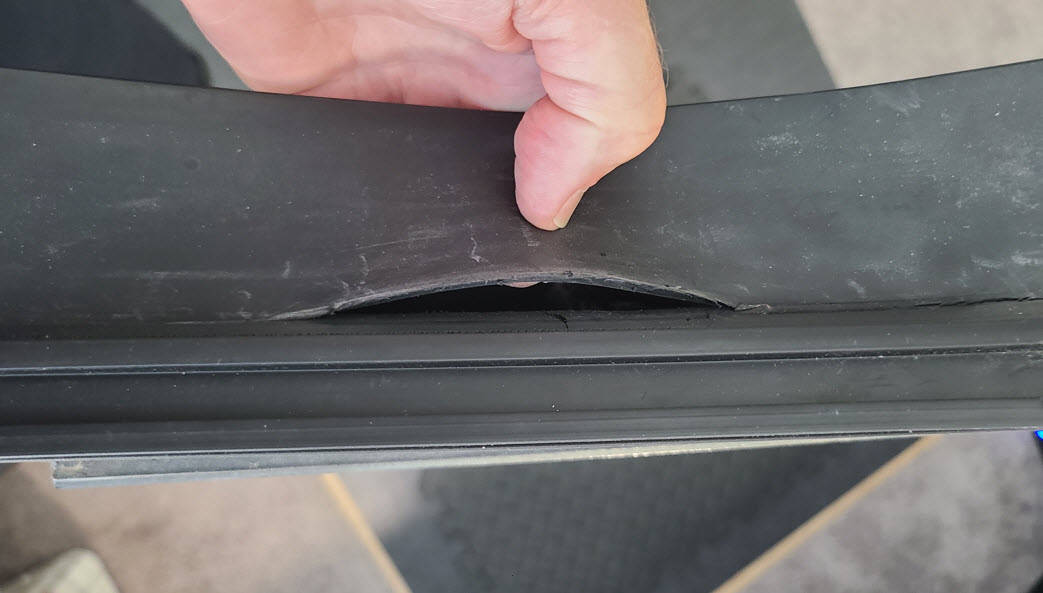
Tips for RV Seal and Seam Maintenance
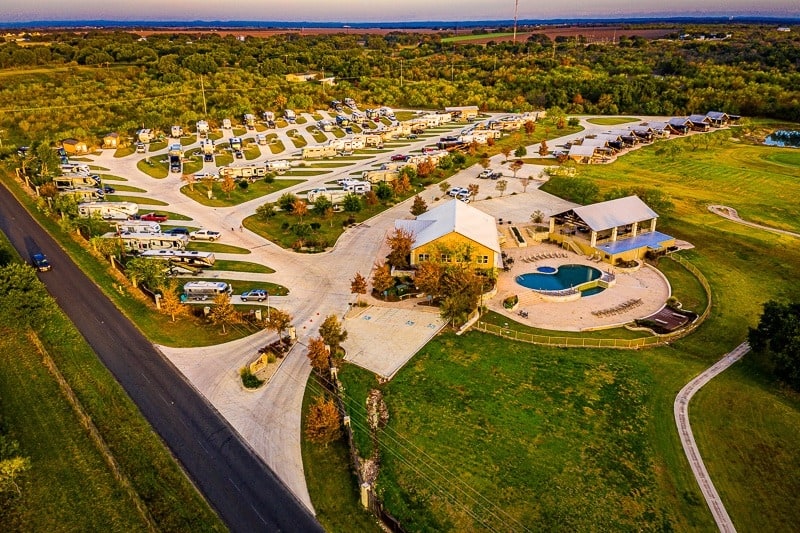
Why Alsatian RV Resort Should Be Your Luxury Getaway Near San Antonio
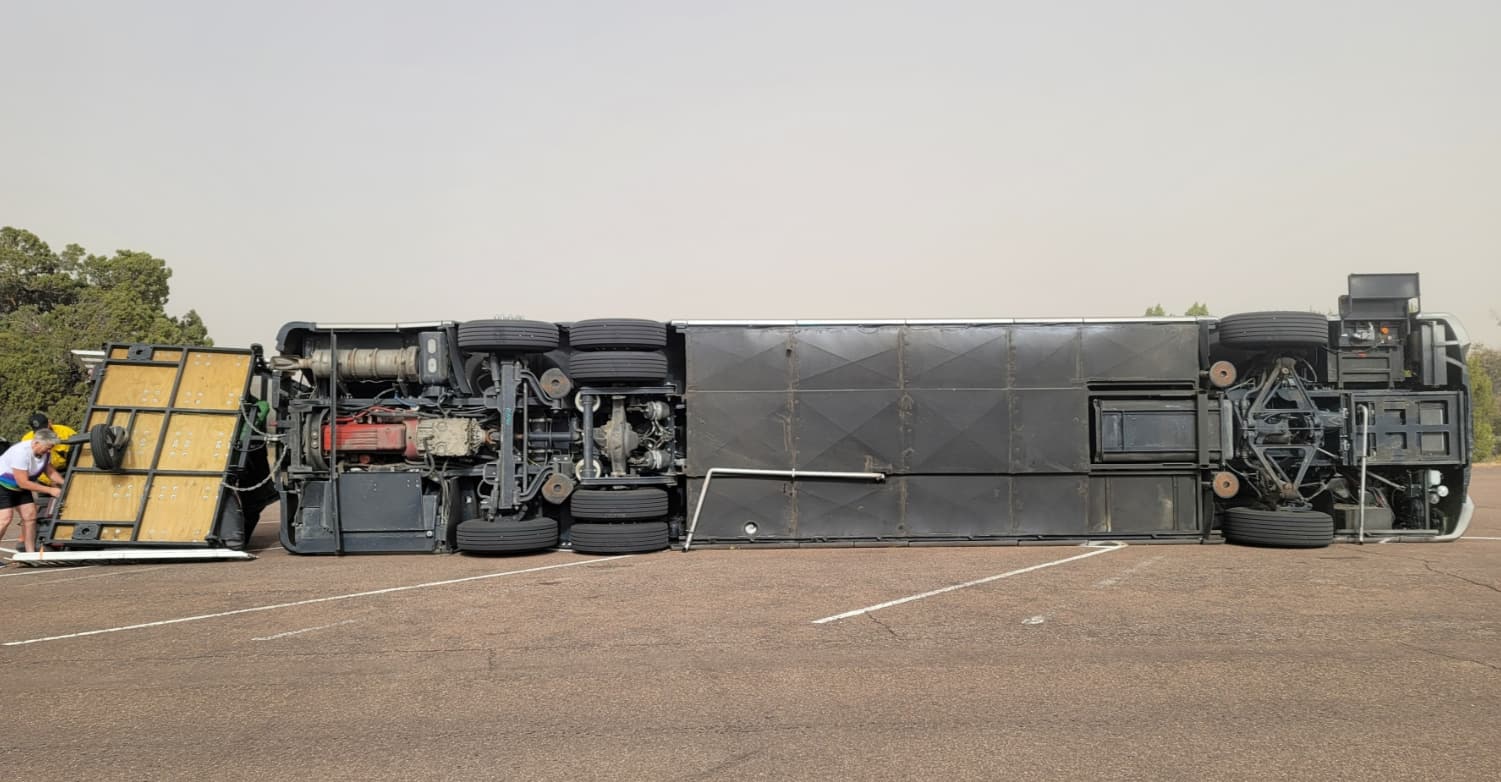
High Winds Flipped Their Parked Motorhome, and their Dog Survived!
About the author:.
The Ultimate RV Maintenance Checklist for Every Season
Before you hit the road for your next adventure, be sure you’re up to date on all the necessary RV maintenance with our handy checklist.
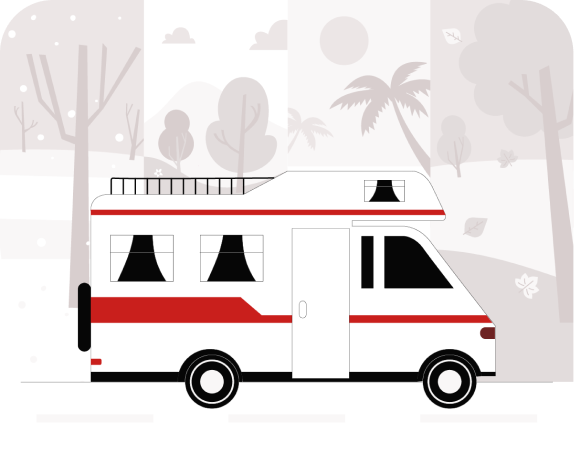
Long road trips are par for the course when you’re an RV owner, but to ensure safer travels on your next adventure, it’s important to know the requirements for pre-trip, monthly, semi-annual, and annual maintenance on your RV. Therefore, we’ve created a maintenance checklist just for you!
Table of Contents
How often should you check your rv for repairs, pre-trip maintenance, monthly rv maintenance.
- Seasonal/Semi-Annual RV maintenance
Yearly RV maintenance
Essential rv amenities.

Good maintenance is essential when you own an RV, whether you keep it parked for a while, are constantly on the go, or plan to sell it one day. Keeping your RV in good shape makes it reliable as well as helps it maintain its value.
You should conduct RV maintenance in two different ways: regular maintenance on a fixed schedule as well as before each trip—no matter how short the trip may be. Monthly, annual, and seasonal care (with special attention to hot- and cold-weather maintenance) keeps your RV in good running order for the long haul and ensures that whatever the conditions outside, your vehicle will be in shape to handle each new road trip .
Perform pre-trip maintenance before every trip. Even a well-maintained RV needs a solid examination before setting out for a trip far away or close to home. This may sound like an obvious step to take if your RV has been sitting for a while and you’re planning your first trip of the season. However, even if you’re just preparing to leave a campground for your next destination or heading home, pre-trip maintenance offers essential preventative care. You get a chance to note any small things that could lead to big issues while on the road.
Because every RV is different, you can customize your own checklist based on a series of important components you should examine both inside and outside of your RV.
Inside your RV
To compile your custom checklist, walk from the front to the back of the vehicle and write down all of your checkpoints in order. That way, you’re less likely to overlook an item on your list. You can use the following checklist to create your own pre-trip checklist for the inside of your RV or just check off the items online as you go:

Turn off the furnace
Your furnace runs on propane, which can open you to a host of problems if you travel with it on, including the pilot light being blown out causing methane to leak into your unit. So switching it off before you leave avoids these hazards
Turn off the water pump
Even a small leak can turn into a big flooding problem when you’re on the road. Shutting off your water pump ensures no water flows through your RV while traveling.
Turn off the refrigerator
Even small shifts while driving can cause your fridge’s propane line to break. Since a switched-off RV fridge filled with ice-cold beverages and food won’t drop its temp much if you leave the door closed—even for eight hours of traveling—turning it off while driving makes the safest choice.
Turn off the pilot lights
Since you’re switching off all of your propane-fed appliances, you won’t need the pilot lights. So turning them off helps prevent propane-related issues like gas leaks.
Check antenna
Outdoor antennas can easily snap, so if you have an outdoor antenna, make sure you lower and properly store it before setting out.
Turn off the water heater
Like any other appliance in your RV, slight shifts from traveling can cause dangerous propane leaks. Since you won’t have to wait long for it to reheat at your destination, keep it off while traveling.
Close and secure all windows
Of course, open windows allow dust and dirt just as they would in a car, but unlike a car, open RV windows can cause uneven pressure that leads to blown-out windows. Open RV windows can also cause your RV to sway dangerously with even small wind gusts.
Close all the roof vents
Similar to windows, you want to keep roof vents closed while traveling to keep out dust and debris as well as moisture.
Secure all large items
Even if wall-mounted, be sure things like your TV and computer are stored and secured tight so they don’t get damaged en route.
Close and lock cabinets
After carefully storing items in your cabinets, you don’t want them falling out, or worse, having flapping cabinet doors damaging the interior of your RV while driving.
Close and latch interior doors
An RV frame may shift slightly while traveling and allow doors to open, which can obstruct views or damage the inside of your RV. So be sure you don’t simply close interior doors but also latch them tightly to prevent them from opening on the road.
Secure all entry doors
Like interior doors, exterior entry points can open when your RV frame flexes on the road. Locking may not be enough so be sure to secure all doors to prevent them from opening while driving.
Secure all trash cans
Empty your trash cans before you get underway and secure them in place so that you don’t have trash or empty cans rolling around your RV. Using collapsible trash cans allows you to use less storage space while on the road.
Outside your RV
Walk around the outside of your RV more than once to ensure that you’ve checked everything and leave nothing behind. The following checklist gives you places to check outside your RV but can’t tell you other things, such as which pieces of outside furniture you may have missed:
Check the jacks
Outdoor conditions can cause damage to your jacks so look for things like dents and twisted or corroded metal. Because the vibration of traveling can loosen bolts, check for loose bolts and stripped threads as well. If your RV uses electric or hydraulic jacks, look through your manual to ensure you check all necessary components, such as wiring and hydraulic fluid.
Remove and store chocks
You need your chocks at the next stop so be sure to store them securely after you remove them. Make sure you store them somewhere convenient so you can easily get to them first at your next destination to secure your RV.
Check all your lights
Ensure all your lights are working properly, including high beams, brake lights, fog lamps, and turn signals. Don’t forget to check the lights on your tow vehicle as well, if you have one.
Check the brakes
Just like the lights check the brakes on your RV as well as any tow vehicle you’re using.
Inspect your tires
While the tires are cold, check the tread and walls for wear and tear or uneven tread, check the pressure on each tire, and make sure all lug nuts are tightened. If you need to buy new tires , you should do this now and not when you’re stranded on the road. Be sure to check the tires on your tow vehicle as well.
Remove and store the levelers
Remove whatever system you use for leveling and store them securely for use at your destination.
Put away and secure the awning
Retract all awnings and lock or store them securely.
Check all exterior compartments
Make sure you completely close compartment doors and latch them. Check for and tighten any loose latches.
Clean the campsite and throw away all trash
Check more than once to ensure you leave nothing behind and that you properly dispose of all trash.
Stow and secure all outside furniture and recreational equipment
Just like when you check for trash, be sure that whatever furniture and equipment you’ve used you pack back up. Store and secure all furniture and equipment so that it doesn’t get loose and become a hazard.
Check both the drain and fill hoses
Inspect your hoses for cracks, holes, and breakages, and secure your freshwater, gray water, and black water valves or caps to avoid leaks.
Close off propane tanks
For the same reasons you turn off your water heater and appliances, you should drive with your propane tank closed to avoid dangerous leaks.
Inspect your generator
Make sure it runs properly, shows no signs of corrosion, and that the wiring is in good working order. Change the filter and fluids, if needed.
Remove and store the water pressure regulator
Store this somewhere handy so you can easily grab it when you hit your destination.
Fold up, retract, and secure exterior stairs or steps you use
If your RV isn’t equipped with retractable stairs, store and secure loose steps or stools that you use to enter and exit the RV.
Developing a maintenance schedule begins with a monthly list. Even if you haven’t driven your RV in the past month, you need to make sure everything is in running order. Sometimes, leaving it sitting for an extended period is even more reason to do a maintenance check.
Check and repair seals as needed
Check seals around your windows, exterior compartments, doors, and on the roof for any water damage. Repair missing or broken seals and look for signs that water has gotten in, such as standing water, water marks, or a wet interior. Water damage to an RV roof can be extremely expensive to repair, and debris left sitting on your roof can cause damage as well.
Check your wet-cell batteries’ water levels
Check the battery manufacturer’s recommendation for how much water to add to your batteries.
Vacuum and clean air conditioner vents and ducts
Just like your own home not on wheels, make sure you clear these of dust and debris.
Run your generator
You need to exercise your generator each month to keep it in shape. Consult the owner’s manual for your generator to get specifics for how long to run it and how much load to add while it runs.
Check the engine
Whether your RV runs on gas or diesel, starting your engine and taking it for a short drive helps keep engine components lubricated.
Check and top off fluid levels
When the engine is cool, examine your oil, coolant, transmission, brake, and wiper fluids. Follow the steps in your owner’s manual for safely checking these components.How often you need an oil change depends on how much you use your RV. So now is a good time to get that done if your RV is nearly due for one.
Pack and/or repack your emergency toolbox
Make sure you have all the correct tools you need and that you have spare batteries included.
Check smoke detectors and carbon monoxide detectors
All batteries should be working. Be sure you have backups on board.
Check your tire
When tires are sitting in the same position for a long period of time, they lose tire pressure. Inspect your tires so that you can add air as needed, and make sure your lug nuts are tightened, too. When you take your RV for a short drive, pay attention to your alignment and take it to a mechanic if you notice any problems.
Check under your motorhome
Make sure you see no signs of animals trying to nest or hang out under your RV for shelter. Be sure to look for entry holes or damage to equipment like hoses or gaskets. Also check for loose parts, signs of rust, or fluid leaks.
Lubricate and inspect slideouts
Your slideouts should move smoothly and easily. Engage them each month to examine the latches, hinges, and other moving parts. Lubricate them as needed to ensure they move smoothly.
Seasonal/Semi-annual RV maintenance
Seasonal maintenance is important, too. Some items that don’t need to be checked monthly will need attention every six months. So at the six-month mark, while you’re doing one of your monthly inspections, include these items in your monthly checklist, too:
Wax your motorhome’s exterior
Elements from the road, sun exposure, and droppings from animals can damage your exterior when left on your RV. Clean and rinse your vehicle and then wax it to protect it from these damage-causing elements.
Do a thorough damage check
Walk around your RV and inspect the outside for any problems, such as rusted areas, soft areas, or bubbling that could signal water damage, or holes and cracks that could let in dirt, dust, insects, and animals.
Lubricate high-wear metal areas
Hinges, jacks, hitches, slideouts, and other metal moving parts should be lubricated at this time.
Check and/or replace the water filter
Your water filter lasts for three to four months, depending on how often you use your RV. If you are using your RV full time, you need to replace your filter more often than you would for occasional use, so adjust this maintenance task as necessary.
Deep clean or detail RV interior
Just like the exterior, elements allowed to sit inside your RV can lead to bigger problems and damage down the road. Whether your RV sits in the sun or receives no interior light while not in use, a thorough cleaning of your interior every six months helps prevent damage.
Weigh your RV
Weigh your RV with it loaded for a typical trip. Check the manufacturer’s gross axle weight rating (GAWR) for your RV as well as the Gross Combination Weight Rating (GCWR). The GAWR helps you understand how to distribute the weight in your vehicle and the GCWR gives you the maximum weight of everything onboard, including cargo and passengers, and don’t exceed it.
Your yearly maintenance checklist should include what’s on your monthly checklist, your semi-annual checklist, plus the following checks you might need to do less often:
Check windshield wiper blades
Be sure these operate properly and show no signs of wear and tear. If you haven’t replaced these recently, you may be due for some new ones.
Inspect the propane tanks
Check for any propane odor and check your hoses and seals to see if they show any signs of wear or cracking. Inspect your cylinders and hardware for rust or damage and have a trained service technician make any necessary repairs. Check to see whether your tank needs to be recertified.
Test all safety equipment to ensure it works
This list should include your fire extinguisher(s), smoke detector(s), carbon monoxide detector, and your horn. Change the batteries in your smoke alarms and carbon monoxide detectors.
Service your brakes
Check your brake fluid and brake pads, and adjust your brakes as necessary.
Sanitize your freshwater tank
You need to sanitize your freshwater tank to ensure you have safe, potable water. Use ¼ cup of bleach, diluted in water, for every 16 gallons in your freshwater tank. Add it to your tank using a funnel, fill the tank with water, and let it sit for 12 hours. Then, drain the tank and flush the system.
Tune-up heating and cooling systems
Inspect your air conditioner and water heater and have them professionally serviced, if needed.
Update your maintenance log
Keeping track of what you’ve done can keep you on top of maintenance tasks, and knowing when you’ve performed them will remind you when regular maintenance is due.
Check and rotate your tires
Rotate your RV tires so they wear evenly, and look for any problems. If you need replacements, used tires can be an option, as long as they’re in good condition. It’s a good option for saving money, as long as you stay safe. If you’re towing a trailer, then don’t forget to check your trailer tires , too.
Inspect your engine’s belts and hoses
Take a look under the hood and check for any cracking or deterioration in the belts and hoses. Make sure they’re at proper tension and not loose.
Hot weather RV maintenance
Summer travel and the heat associated with it pose their own challenges. Although your monthly maintenance tasks should take care of your needs, pay close attention to these items if you know you’ll be traveling in the heat of summer.
How to prepare your RV for hot weather
Especially if you skipped some monthly maintenance checks, be sure to do the following before traveling in the heat:
Make sure you have enough coolant and refrigerant in your air conditioner.
Examine your air filter
Clean or replace it if necessary.
Test batteries and refill fluid levels
Test your batteries to make sure they have a good charge, and top off the water with distilled water as needed.
Clean and wax the RV’s exterior
The wax can help prevent damage from UV rays.
Check and repair broken seals
Repairing seals protects your RV from weather damage both inside and out.
How to protect your RV’s interior
Heat and direct sunlight can cause fading, cracking, and other aging to the interior of your RV. Follow these tips to minimize direct sunlight damaging your interior:
- Park in the shade.
- Use curtains.
- Use a fold-up sunscreen/visor to protect your dashboard.
- Use seat covers to protect seats.
- Apply conditioner to keep leather surfaces soft and protect them from cracking caused by the sun.
If you budget only allows for the necessities, don’t leave home without ensuring you have the following essential components for RV travel:
Wheel chocks
Your parking brake may keep your RV stable, but it doesn’t keep it immobile. Wheel chocks keeps your RV secure so it doesn’t go rolling away.
Your RV must be level for your equipment to work properly. Even if you have electric or hydraulic levelers, you need to bring some type of manual level system along for when you must park on uneven ground.
Drinking water hose
You need a dedicated hose to fill your freshwater tank at each destination. Because the spigot could be far away, get at least one 25-foot-long hose labeled “potable,” meaning suited for drinking water.
Water filter
Water quality varies from place to place, and a water filter keeps debris out of your pump and out of your drinking water.
You don’t want this hose to be cheap. Get a nice, 10- to 20-foot sewer hose with adapters—if it comes with a see-through connector, even better.
Surge protector
Protect your electronics from sudden electrical surges and dips, common to life at the campground.
Shore power cord
If your RV isn’t equipped with a power cord, you can’t use a home extension cord for your RV power so you need a shore power cord instead. Check the amperage of your RV to select the appropriate cord.
Electrical adapters
Adapters can enable you to adjust to different service outputs or receptacles as needed.
Water pressure regulator
This mechanism is a valve that moderates water pressure from a source. Water pressure at different sites can vary, and this regulator ensures you don’t ruin your plumbing.
Tire pressure gauge
A digital pressure gauge is helpful in checking your tire pressure; don’t count on finding a gas station with an accurate gauge when you need one.
For quick fixes, it’s hard to beat for RVers.
If you break down on a dark road, you’ll need a powerful bright flashlight that can illuminate a large area, is durable, and takes batteries with long life. One with multiple settings can be helpful, too.
Emergency road kit
Creating a checklist of your own can help ensure you don’t forget anything, from water to blankets; ice scrapers to tire chains in winter; screwdrivers to lug wrenches; a first-aid kit; and other necessities.
Extra motor oil and transmission fluid
It’s good to have some of each on hand in case you break down far away from the nearest gas station.
Fire extinguisher
It’s just as important on the road as it is at home—perhaps more so, considering potential engine problems.
Closed bag for important documents
Include things like your registration, insurance, reservations, prescriptions, emergency contact numbers, list of allergies, and so on.
Conducting routine maintenance on your motorhome can make your RV camping trip more enjoyable by freeing you from worry and reducing the chance of potential mishaps. These RV maintenance tips should help you keep your camper, motorhome, fifth wheel, or travel trailer in tip-top shape.
Additional resources
- https://maintainmyrv.com/
- https://rvlife.com/rv-maintenance-big-deal/
- https://www.gorving.com/tips-inspiration/how-tos/common-rv-maintenance
- https://rvblogger.com/blog/25-essential-tips-storing-rv-hot-weather/
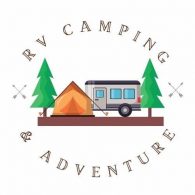
The Ultimate RV Maintenance Checklist
Whether you have a new RV or have had yours for a few years, keeping it in optimum condition will ensure that you will have safe and enjoyable camping trips for years to come. So, if you’re looking for the best way to stay on top of everything without feeling overwhelmed, here is an RV maintenance checklist that can help you get started.

Free RV Maintenance Checklist & Log
Sign up below to get a free printable RV maintenance checklist and a maintenance log that can help you stay organized and keep your camper in tip-top shape!
You have successfully joined our subscriber list and will be receiving your RV maintenance list and log very soon!
Easy RV Maintenance Schedule
Whether your camper is used often or just taken out once or twice a year, a good inspection and RV maintenance are always a good idea.
Since routine maintenance is essential, we have included an RV maintenance checklist for before and after trips, monthly maintenance, and even a seasonal maintenance checklist so you can make sure everything is in tip-top shape!
Let’s get started with a visual inspection of the interior and exterior that is great for before and after each trip.
Pre And Post Trip Maintenance Tips
Checking for problems before and after each camping trip might sound tiring but a properly maintained camper will definitely save you time and money over time as well as ensure safety.
Let’s get started with RV maintenance!
Internal Checkups
In the interior of your RV or travel trailer, here are a few maintenance tasks you will want to do before leaving and after your trip when you return home.
1. Water Pump Turned Off
Whether you’re ready to hit the road or getting ready to store your RV for a while, it is important to make sure that the water pump for the fresh water tank is turned off.
2. Water Heater Turned Off
Your RV’s water heater must be shut off before you start to drive or before storing for any amount of time. If the water heater isn’t being used, there’s no reason to have the heater on!
3. Furnace Turned Off
A common source of fire inside an RV is the furnace. Therefore, we recommend you to keep it off when not in use.
4. Turn Off the Fridge
Many states won’t allow using propane freezers inside a running RV. Also, like the furnace, why use propane to keep an appliance going when the camper isn’t being used?
5. Switch Off The Pilot Lights
While moving, pilot lights will not be necessary. You must keep them off to be on the safe side as they can also culminate in a fire hazard.
6. Test The Smoke Detector And Carbon Monoxide Detector
Testing smoke alarms and carbon monoxide detectors is so important for safety! Even with the best maintenance, a fire could occur or a leak could happen.
So be sure to check these two alarms, and don’t forget to have a fire extinguisher and a first aid kit in your camper too!
7. Put Down the TV Antenna
If you have an antenna be sure to fold it down before you leave.
8. Check All Windows, Doors, and Cabinets
Before you start driving, make sure that all the doors, windows, and cabinets are locked and secured.
9. Keep the Shower Closed
You must close the shower doors properly, as they can swing open if not shut tight.
If there are bathroom accessories, ensure they are stowed properly too.
10. Empty And Secure Trash Cans
A moving vehicle will make the trash can fall or move from place to place, so before you head out, be sure to empty any trash and secure the cans.
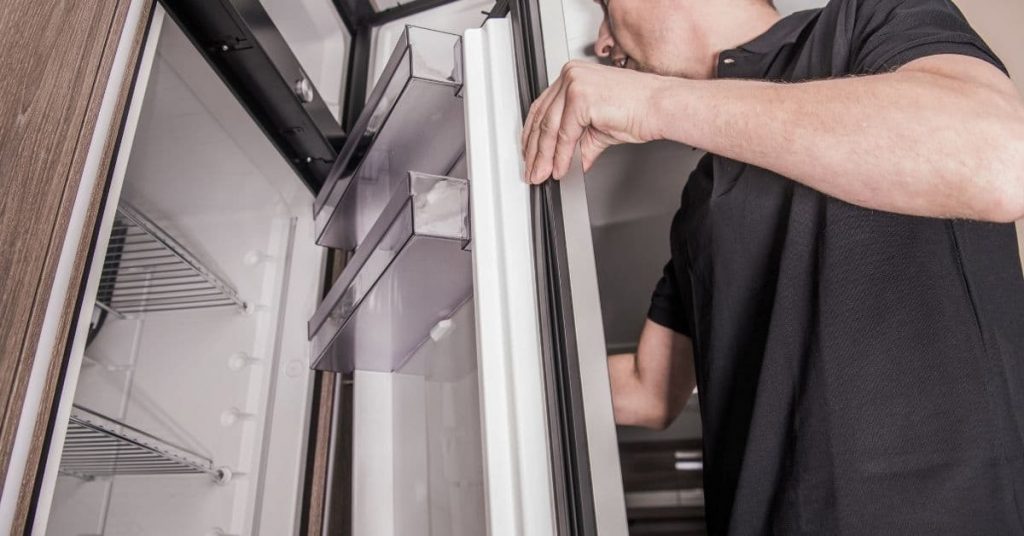
External Checks
Ok, so we’ve gone over the interior checklist, let’s go over everything to inspect the exterior of your camper.
1. Secure The Jacks
RV jacks might fall off while you are driving. So, to stop it from happening, it’s important to keep them secured in a raised position.
Always look for potential corrosion, split metals, and loose ends on the jacks.
2. Remove The Chocks
If you are using chocks, be sure to remove them and stow them in a secured position before you drive.
3. Check All Lights
To make sure all beams, signal lights, brake lights, and fog lights are working properly and there are no loose connections, flip the necessary switches and step on the pedals to make sure they are functional.
If the cable connections seem loose or you notice the pedal doesn’t feel quite right when you push on it, be sure to take it to your mechanic to service brakes and check the electrical system.
4. Inspect The RV Tires
Remove the tire covers, then examine the tires thoroughly. Check to see if each one has the recommended tire pressure, and do a visual inspection of its overall condition.
You’ll want to make sure that there are no nails or screws in the tread, each tire has all necessary lug nuts (and they’re tight), and they seem to wear evenly.
Don’t forget to check the spare tire too!
5. Secure the Awning
Securing the awning is really, really important! If you drive with an awning that isn’t secured properly you risk losing the awning, damage to your fifth wheel or camper, or even damaging someone else’s vehicle if the awning rips off while you’re driving.
(We have seen this up close and personal while going over the Mackinac Bridge. An unsecured awning went through the window of the truck in front of us!)
6. Shut Off All Heaters
Just like the interior check, you must make sure that water and gas heaters are completely off before driving or put in storage for the winter.
7. Store Outdoor Accessories
If you’re going camping or just coming back, chances are you will have outdoor chairs, foldable tables, a portable grill, and maybe even a camping cabinet that will need to be secured.
These are helpful (and sometimes expensive) items so be sure to secure them before taking off!
8. Put Down Satellite Antenna
If you are using a TV inside the RV, make sure to slide down the antenna to a resting position before starting the vehicle.
9. Dump Tanks & Secure Hoses
Before you leave a campground, it is essential to empty the water system and dump the holding tanks. The RV’s sewer hose must be properly cleaned and stowed as well.
10. Unplug Any Electrical Cords
If you’re connected to electricity, whether in a campground or at your home, you will need to unplug any and all electrical cords before leaving on your trip or storing your camper for a time.
11. External Compartments and Steps
Make sure all compartments are securely closed and locked, the entry door is shut tight, and fold the exterior stairs up before leaving.
12. Clean Up the Camp Site
This is a really important, but sometimes overlooked part of camping- leave a pristine campsite.
Look out for trash and debris and dump them to maintain a clean-looking site.
This may not be exactly RV maintenance, but leaving no trace is something all campers need to do 😉
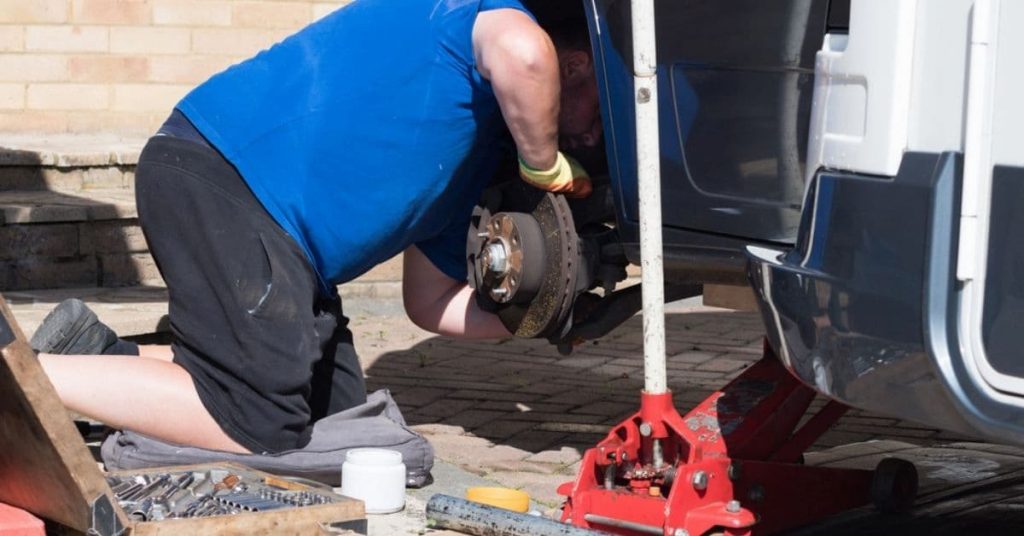
Monthly RV Maintenance Tips
It is not unusual for RVs to sit unused for months. That’s why it is essential that RV owners perform monthly checks and routine maintenance.
1. Check and Repair Seals
Check all interior and exterior seals on the roof, doors, and windows.
Good seals play a crucial part in limiting water leaks and preventing water damage that is so common in travel trailers.
2. Check Battery Water Level
With time the RV battery water will evaporate and vanish. If you have this type of battery, be sure to top off the water level with distilled water to ensure that it works optimally.
3. Start The Generator
If the generator has not been in use for a lengthy period, then there is a chance that the gasoline will not be good. To avoid this, you can add a fuel stabilizer along with running the generator at 50% capacity for at least two hours each month.
4. Clean Air Conditioning Vents
An RV’s air conditioner provides nice, cool air inside the RV. If the vents are clogged, the AC won’t work properly and impaired units can have high repair costs.
So, to counter this issue, use a vacuum to clean the vents every month and keep the air conditioning unit in good health.
5. Check the RV’s Engine
Engine maintenance is a crucial part of vehicle maintenance tasks. You, the RV owner, must look at the engine for potential leaks and along with making sure the clamps and hoses are attached properly.
The best way to maintain a well-balanced engine is to run the vehicle for a short distance every month.
6. Top Off All Fluid Levels
The engine oil, transmission fluid, antifreeze, and windshield wiper fluids might drop below normal as time goes by.
If sitting idle for long, you may have to add fluids. So don’t forget to give these a quick check as you go down your RV maintenance checklist.
7. Gather The Toolbox
An emergency toolbox is needed for every RV owner.
You never know what complications you might face on the road. So, having a toolbox with spare parts along with necessary tools and extra fluids can be a lifesaver.
8. Check The Smoke Detectors
Carbon monoxide and smoke detectors inside RV are essential!
But, you must check the batteries regularly and test them to make sure they are working properly.
Be sure to change the batteries every six months too!
9. Keep Pests Out
If the RV is not in use for a while, it could turn out to be a shelter for unwanted critters.
To counter this problem, make sure all doors and windows are closed tightly, there are no gaps in the siding, and there is no cracked insulation underneath so those little creatures can’t get in.
If you need help making sure your RV is secure, check out this article about how to keep mice out of your camper .
10. Inspect Moisture Seals
Always look for cracks or bubbles on exterior sealants. Moisture can wreak havoc, so you can use RV sealants to prevent and repair cracks.
11. Lubricate the Slideouts
Last but not least, make sure the RV slide-outs are well lubricated. The hinges, latches, and other parts must be working smoothly, so lubricating them adequately is the best way to keep them functioning.
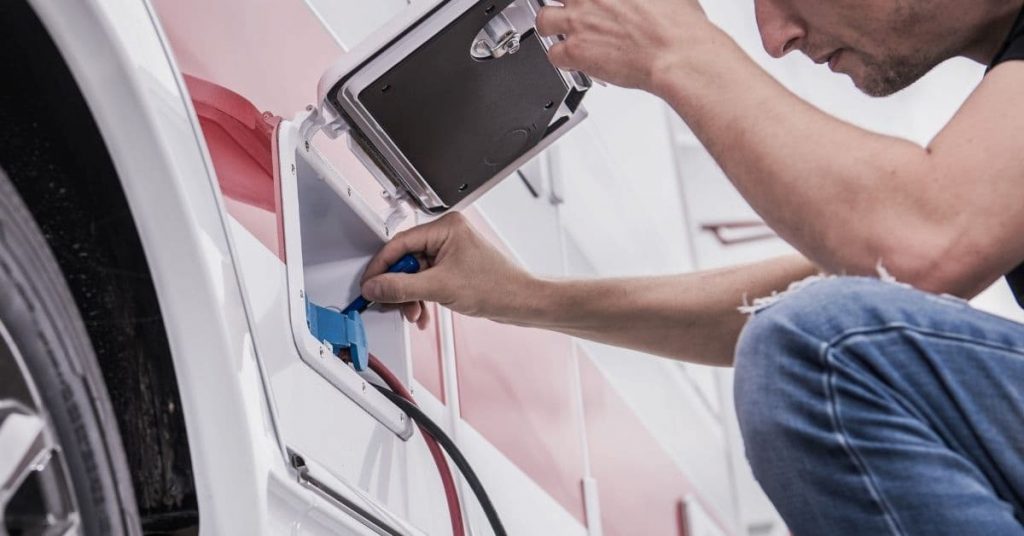
Seasonal RV Maintenance Tips
There are a few aspects of maintenance that don’t need to be looked after every day or month. You can simply have it checked every six months or so to keep things in good working order. Let’s look at some basics….
1. Deep Cleaning the Interior
Performing a deep clean on the interior will help keep your RV clean, smelling fresh, and keep little creatures out.
For best results, give your camper a deep cleaning every six months with lighter cleanings in between.
2. Wash And Wax The Exterior
To keep your travel trailer or RV looking nice and keep it protected, it’s a good idea to wax the exterior once or twice a year.
3. Clean Tanks & Replace Water Filters
Even though most campgrounds have potable water, in order to have water that tastes good and is free from contaminants, it is almost always necessary to have a water filter.
If used often or left unused for an extended period, it will be necessary to change your filter.
Another important chore is to add to your RV maintenance checklist is to make sure you clean and sanitize the water tank and fresh water hose.
Be sure to clean the tanks and then replace your water filter though so the whole system is fresh and clean!
4. Damage Check
RVs sitting for a long period, even the running ones, may still suffer from water damage, broken seals, or other issues.
Harsh weather can wreak havoc on a camper.
So, be sure to look for any broken seals, cracks on the RV roof, or wet spots.
If you find one, apply sealants to secure it so that no pests or water can enter the interior.
5. Lubricate Metal Parts
Metal joints are common on the steps, slideout, leveling jacks, hitches, etc.
These places are likely to get corroded easily so take a little time to make sure these are properly lubricated.
This can save time, money, and reduce the chance of problems down the road.
6. Check Wheel Bearings
To make your RV roll down the road smoothly, you may need to check the wheel bearings. If you need help be sure to ask your mechanic to give them a look when taking it in for service.
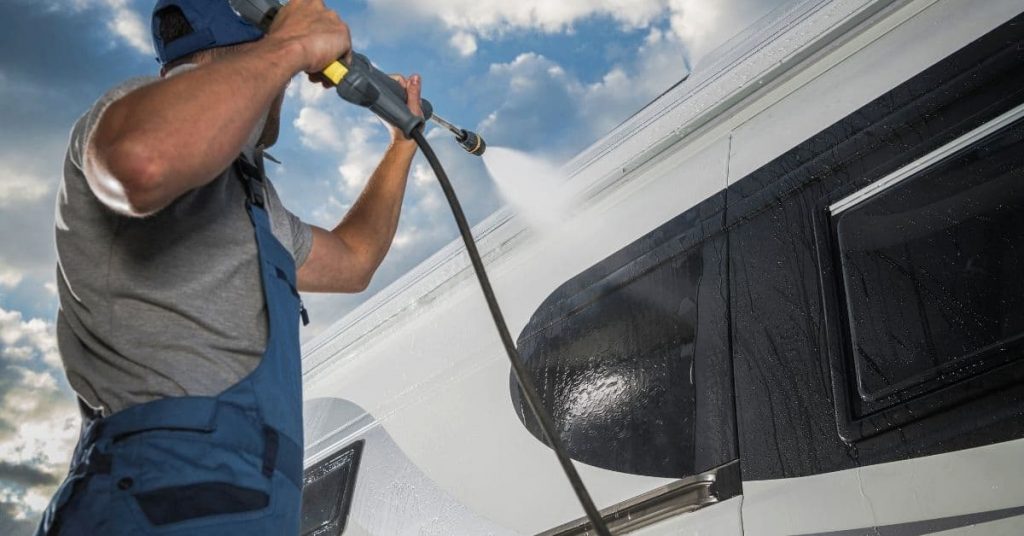
Yearly RV Maintenance Tips
In addition to regular maintenance and monthly checkups, your RV will need yearly maintenance as well. It is similar to the monthly list, but there are a few other things you need to consider.
Let’s have a look…..
1. Look For Bad Seals
We have already talked about taking a good look at the seals on an RV. Now, during the camping season, it’s not unusual to just patch things or get along until you’re not using the camper, but during a yearly inspection, a bad seal really should be replaced.
This is important because proper sealants keep the RV roof and windows secure so no water (or bugs!) get in and cause damage.
2. Examine Tires, Brakes, Hoses, and Belts
Like any vehicle, it is typically advised that you have the tires, brakes, hoses, and belts serviced by a professional yearly unless you are very familiar with doing this type of work yourself.
If you have a vehicle that you tow behind a motorhome, be sure to inspect these parts, rotate the tires, and check for safety issues on this vehicle as well.
3. Test The Propane Tanks
Check for leaks in your RV’s propane system.
You’ll want to look for connection issues, paint damage, and dents.
Also, be sure to check over the hoses and seals to see if there are potential gaps that can lead to a propane leak.
4. Test Safety Equipment
The smoke detector battery and carbon monoxide alarm battery will wear out in time. That’s why it’s best if you replace the batteries at least once per year (every six months is better though!).
Don’t forget to check the safety equipment after installing new batteries to make sure it works properly.
5. Clean The Cooling and Heating System
Just like when you service and clean your air conditioning vent every month, you must perform this task yearly as well.
Also, be sure to check over the heating system.
Make sure that the vents are cleaned, the thermostat works properly, and there are no leaks.
6. Fluid Levels
Rechecking the fluid level on RV batteries, transmission, radiator, and engines every year is a good idea.
A yearly inspection is a great time to change the oil, replace a battery that’s wearing out, or fix any leaks that were not taken care of earlier.
7. Keep Your Maintenance Log Updated
Having an annual maintenance log helps you keep track of the service and maintenance of your RV.
If anything is due, you can have it checked accordingly.
This will not only help you keep on top of maintenance but if you ever decide to sell the new owners will be grateful to see what has been done and how well you’ve cared for the RV.
So be sure to always update the log once you’ve performed any maintenance.
Don’t Forget To Grab Your Free Printable Checklist & Maintenance Log!
Frequently asked questions.
Have a few questions related to RV maintenance? We’ll try to answer a few common ones we’re asked here…
1. Are RVs hard to maintain?
RV maintenance isn’t necessarily hard, but it does take time and there are costs involved. But, that’s why a good maintenance checklist is so important. It can help you save time, stay organized, and stay on top of RV maintenance so you can have a well-cared-for camper and that usually means less costly repairs.
2. How often should an RV be serviced?
Your owner’s manual should give a recommendation for this so that is what you will want to follow. Typically, though, it is recommended that RVs be serviced every 3-6 months.
If you can’t or don’t want to service your camper every few months, at least be sure to give it a thorough check once per year.
3. How often should I start my RV while it’s in storage?
If you have a motorhome, camper van, converted school bus, or any type of recreational vehicle with a motor, it is usually recommended that you start it at least once a month and let it run for a few minutes.
If you can, taking it out for a short drive would be helpful. If that’s not possible, starting it every month will still be helpful.
Last Thoughts…..
Following the RV maintenance checklist will not only keep your RV looking and running well, but can also help you stay organized and alert to any small issues before they become bigger problems.
So, give your RV a good once over before you hit the road and you can enjoy your trip with the knowledge that you are safe and secure.
Related Articles
- Learn Everything You Need To Know About RV Antifreeze (Before Winter!)
- RV Covers: Pros, Cons & Best Options
- RV Tire Covers: Are They Necessary?
- How To Quickly & Easily Sanitize An RV Water Tank
- 9 Easy Ways To Keep Outdoor Rugs From Blowing Away
- The Ultimate Camping Planner: A Must-Have Printable Planner For Your Next Adventure
Looking for more helpful RV tips? Check out the RV Basics page to find tips, tricks, and must-have info!
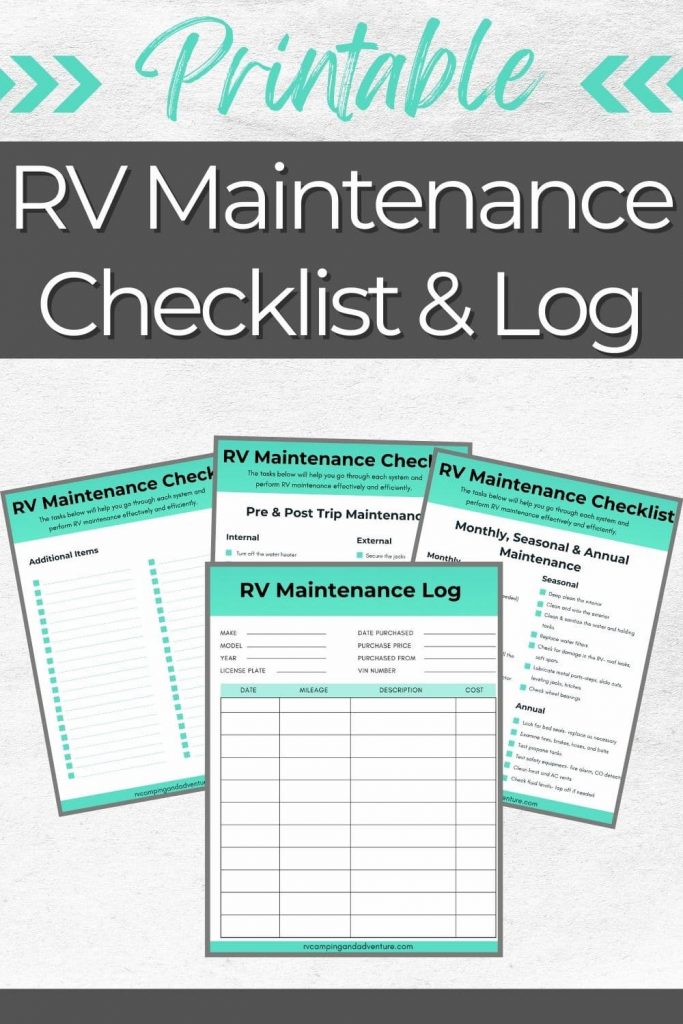
Leave a Comment Cancel Reply
Your email address will not be published. Required fields are marked *
Save my name, email, and website in this browser for the next time I comment.

- Find a Location
Maintaining Your RV: Seasonal, Annual, and Pre-Trip Checks
Use the right cleaning products to ensure you don’t damage your RV’s decals or exterior finish. Your RV’s finish will determine the right solution, so consult your manufacturer or owner’s manual to learn which products to use (and what to avoid) when you clean your RV.
Here’s a tutorial on how to wash your RV.
Checking RV Tire Pressure
Recommended Frequency: Before and after each trip
Your tires are the foundation of your RV. If you don’t maintain them properly by regularly checking tire pressure, monitoring tread depth, tracking tire wear, and covering them when your RV is sitting idle, you’ll decrease their lifespan and possibly endanger your next RV trip.
Here are some resources to help you maintain your RV tires:
- How to Maintain RV Tires While in Storage
- Why You Need an RV Spare Tire Cover
- Everything You Need to Know About RV and Trailer Tires
Maintaining Stabilizing Jacks
Recommended Frequency: After each trip (or 2-4x per season)
This RV maintenance task might require the help of a certified technician, especially if your RV is equipped with an auto-leveling system. Those systems can put your entire RV, and anyone inside, in danger if they aren’t adjusted and maintained properly. Consult a service center to see if your stabilizing system needs to be inspected and adjusted accordingly.
If you have manual stabilizers, there’s a little more you can do on a regular basis. That includes inspecting the hardware securing the stabilizers to your RV’s frame and proper cleaning and lubrication.
You should also know how to level and stabilize your RV properly to avoid unnecessary wear and tear on your stabilizing jacks.
Inspecting Seals
Recommended Frequency: Every 90 days
The seals on your RV’s roof, windows, doors, and compartments should be inspected regularly. This helps you avoid leaks and water damage that will result in much more expensive repairs on your motorhome or travel trailer.
Checking Your RV Battery
Checking the charge, cleaning the terminals, and inspecting the cables are three of several checks you should complete on your RV batteries every three months. Here are a few more resources to help you keep your RV batteries in good condition:
- How to Troubleshoot RV Batteries and Trailer Lights
- Everything You Need to Know About RV, Truck, and Boat Batteries
Maintaining Holding Tanks
Recommended Frequency: Every trip (and seasonally)
Your RV’s gray, black, and fresh water holding tanks require proper maintenance to avoid clogs and other septic issues. This can be a major learning curve for new RVers, so here are a few additional resources:
- How to Maintain RV Holding Tanks
- How to Empty Holding Tanks
- How to Use a Black Tank Flush
- How to Unclog Your RV Black Tank
Sanitizing Your Fresh Water Tank
Recommended Frequency: Seasonally in the spring (or after 2-4 weeks of non-use)
Using an RV water filter is key to keeping dirt and corrosive chemicals out of your RV’s fresh water tank. But even with diligent filter use, you should sanitize your RV’s fresh water tank regularly. Here’s our complete step-by-step tutorial for sanitizing your RV’s water distribution system .
Flushing the Water Heater and Checking the Anode Rod (if applicable)
Recommended Frequency: Seasonally (usually during winterization and dewinterization)
An anode rod is a sacrificial element that attracts corrosive chemicals to keep them from damaging your water heater tank. Once it’s diminished, it must be removed and replaced to keep your water heater tank safe.
Packing Wheel Bearings
Recommended Frequency: Annually
This is a maintenance task that has quite a bit of nuance. You need the correct type of grease, specialty tools for removing and packing bearings, and expertise to inspect trailer brakes while your tire is removed. We highly recommend contacting a Camping World RV Service Center to schedule your annual wheel bearing maintenance.
Rubber Roof Maintenance
Rubber RV roofs should be inspected and cleaned seasonally, at the very least. But they should also be professionally inspected each year to ensure all the seals are intact and there’s no significant damage to the roof membrane.
Of course, there are other types of RV roofs besides rubber, such as fiberglass and aluminum. Check your manufacturer’s instructions for the proper roof maintenance procedures for your RV.
Covering Your RV
Recommended Frequency: Anytime your RV will sit idle for an extended period
Installing an RV cover is the best way to prevent exterior fading and other weather-related wear and tear. RV covers are fairly easy to install, and they can save your roof, seals, windows, exterior decals or paint, and tires from harmful UV exposure, moisture, and other environmental factors.
Maintaining Your Air Conditioner
Cleaning the filter in your RV’s air conditioner is important for efficient operation. You can also look into blocking air vents, installing insulated window treatments, and other solutions to keep your RV cool when camping in hot climates.
Maintaining Slideouts
Working on RV slideouts should be left to a professional RV technician. They are driven by complex systems, and you can significantly damage your RV if you aren’t careful. That said, there are ways to manually retract slideouts if you’re stuck in an emergency situation.
If your slide-out is stuck, here are a few resources to help you pull them in so you can make it to the nearest Camping World Service Center :
- How to Manually Operate RV Slideouts
- Troubleshooting Schwintek Slide Errors
Inspecting and Maintaining RV Awnings
Awnings are a useful RV accessory for protection from sun and light rain. But they can easily be compromised if you don’t operate and maintain them correctly. Here are a few more resources to help you maintain your RV awnings:
- How to Open an RV Awning
- A Complete Guide to RV Awnings
- What to Know When Choosing a Retractable RV Awning
Winterizing Your RV
Recommended Frequency: Seasonally
When your RV is sitting idle, and there’s the possibility of freezing temperatures, winterizing is essential to protect your plumbing lines, tanks, and fixtures from damage. Camping World offers a basic winterization and a complete winterization package. Contact a service center to find out which package is right for your RV.
Here are a few more helpful resources:
- How to Winterize an RV Generator
- Everything You Need to Know About RV Antifreeze
Dewinterizing Your RV
When preparing for spring camping, you’ll need to flush the RV antifreeze out of your fresh water and wastewater systems. There are several other tasks that all RVers should know to get their unit ready to hit the road for camping season.
Here are a few more tutorials to assist with spring RV prep:
- Spring Cleaning: Tips for Organizing the Inside of an RV
- How to Sanitize an RV Fresh Water Tank
Other RV Maintenance
For more RV maintenance tips, check out our YouTube How to RV Playlist .
Meet the Speakers

Hi folks, I’m Ian Baker! I have been an RV Product Specialist at Camping World for 4 years, so you can call me an expert in the RV industry! If I’m not at work, you’ll find me outdoors with my wife and kids – I am a family man at heart. I hope to answer many of your questions about maintaining your RV.

Hi everyone, I’m Sean Harless! I am a Service Director for Camping World, based out of North Carolina. Let’s review the ins and outs of maintaining your RV. If I’m not at work, you’ll find me behind a barbeque with friends and family!
- Comment (2)
we just purchased an RV & it has no manuals with it at all….you used to offer a kind of “walk thru” class that teaches you how to work everything properly. Do you still offer this service? Or do you know how we can possibly get ahold of the “owners manuals” that would go with the make & model of the RV that we purchased? Any help you can give us would be much appreciated. Thank you so much.
Great info. I’ve been RVing for a few years and did pick up some interesting tips. Will now subscribe to your info sessions.
Leave Your Comment Cancel Reply
Save my name, email, and website in this browser for the next time I comment.
Shop By RV Type

Your Adventure Awaits
Copyright © 2023 cwi, llc all rights reserved.
- RV Glossary |
- Privacy Policy |
- California Privacy Rights |
- Do Not Sell or Share My Personal Information |
- Targeted Advertising Opt Out |
- Terms of Use
A Comprehensive Guide to RV Servicing And Maintenance

Imagine hitting the open road, with the assurance that your RV is in its best shape. This is not just a dream for RV enthusiasts; it’s a crucial aspect of RV ownership. Our guide, “A Comprehensive Guide to RV Servicing And Maintenance” is your indispensable companion in this journey. Here, we’ll explore the essential RV repairs and maintenance tasks that keep your travel trailer, motorhome, or camper humming smoothly. Whether you’re planning a campervan getaway or embracing full-time RV living, understanding the nuances of RV care – from RV service requirements to seasonal maintenance – is key. Moreover, for those who cherish their fifth wheels or Class A motorhomes, we’ll provide tailored advice to ensure longevity and safety. So, buckle up and get ready to navigate the road of RV upkeep with confidence and ease.
Table of Contents
Understanding RV Types and Their Maintenance Needs
Navigating the diverse world of RVs requires an understanding of different types and their specific maintenance needs. Whether you own a sleek Class B campervan or a luxurious Class A motorhome, each type demands a unique approach to upkeep. In this section, we delve deep into the maintenance nuances of various RV categories, providing tailored tips to ensure your vehicle remains road-worthy and efficient.
Class A, B, C Motorhomes: Differences and Maintenance Implications
The Class A, B, and C motorhomes each present distinct features and maintenance challenges. Moreover, Class A models, often the largest, demand comprehensive care, especially for their advanced systems. Class B vehicles, typically more compact, focus on maximizing space and efficiency. Class C motorhomes blend these qualities, offering a middle ground in size and complexity, perfect for those seeking both comfort and mobility.
Identifying the Unique Features of Each Class
Models of Class A motorhomes are known for their spacious interiors and luxury amenities, often resembling a home on wheels. Class B vehicles, commonly known as campervans, are noted for their agility and economy, making them ideal for solo travelers or couples. Class C units strike a balance, offering more space than Class B but retaining more maneuverability than Class A, making them a popular choice for families and groups.
Tailored Maintenance Tips for Each Class
For Class A units, prioritize engine and ge nerator maintenance, given their larger size and more complex systems. Class B vehicles require regular checks on space-saving components and electrical systems due to their compact design. Class C owners should focus on engine health and living space upkeep, balancing the demands of both smaller and larger models.
Fifth Wheels and Travel Trailers: Unique Maintenance Aspects
Fifth wheels and travel trailers differ significantly from motorhomes in maintenance needs, primarily due to their towable nature and distinct structural features. These vehicles often see different types of wear and tear compared to motorhomes, especially in their suspension and external components.
Key Maintenance Differences from Motorhomes
Unlike motorhomes, these units rely on tow vehicles, necessitating hitch system and brake maintenance. Their stationary nature when parked leads to different wear patterns and maintenance focuses. Additionally, the absence of an engine and transmission means more focus on structural integrity and external components.
Specific Concerns for Fifth Wheels and Travel Trailers
Key areas include the wheel bearings, brakes, and exterior seals, which are essential for safe towing and longevity. Regular checks for moisture ingress and structural integrity are also vital to avoid long-term damage, particularly in changing climates or when stored for extended periods.

Campervans and Conversion Vans: Special Considerations
Campervans and conversion vans offer a unique challenge in maintenance due to their compact size and customized nature. These vehicles often require more frequent checks on certain systems due to their intensive use in varied environments.
Their smaller size often means more integrated systems and less space for repairs. Regular checks on space-saving features and compact appliances are essential. Additionally, due to their customized nature, these vehicles may have unique systems not found in standard RVs, requiring specialized knowledge for maintenance.
Custom elements, like unique storage solutions or bespoke electrical setups, require a specialized maintenance approach. Regular checks for wear and functionality are crucial, particularly in systems that have been heavily modified or personally designed.
Importance of Tailoring Maintenance to RV Type
Understanding and tailoring maintenance to your specific RV type is key to ensuring longevity and reliability. A well-maintained RV promises countless miles of memorable journeys, ensuring safety and comfort wherever the road may lead. Consider your RV’s size, usage patterns, and unique features when planning maintenance. Regular, tailored check-ups can prevent costly repairs and extend your RV’s life. This approach not only saves time and money but also enhances your overall RVing experience.
The RV Maintenance Checklist: Essential Components
A thorough RV maintenance routine is crucial for ensuring your home-on-wheels remains a haven of safety and comfort on your travels. This checklist covers the essential components, from engine care to HVAC systems, ensuring every aspect of your RV gets the attention it needs for a worry-free journey.
Engine and Transmission Care
The heart of your RV, the engine, demands regular attention to keep it running smoothly. Neglecting this can lead to costly repairs and unplanned downtime. Routine engine checkups should include oil changes, filter replacements, and coolant level checks. Keeping the engine in top condition is crucial for reliable performance and fuel efficiency. Regular transmission fluid checks and changes are crucial for smooth gear transitions and longevity. This not only ensures a smoother ride but also helps prevent major mechanical failures.
Electrical Systems: Batteries and Wiring
The electrical system, including batteries and wiring, is the lifeline of your RV’s functionality. It powers everything from your lights to your refrigerator, making it essential for comfortable living on the road. Regular battery inspections, clean terminals, and timely replacements ensure uninterrupted power. This is especially important for those who rely on their RV for long-term travel or full-time living. Inspect wiring regularly for damage or wear, especially after long trips or extreme weather exposure. This includes checking connections, ensuring proper insulation, and looking for signs of wear or damage.
Plumbing and Water Systems
An efficient plumbing system is key to a comfortable RV experience. From showers to cooking or toilets set , a well-maintained water system is essential for daily life on the road. Regularly inspect pipes and faucets for leaks and clear blockages to prevent water damage. This includes checking for signs of water damage, ensuring valves function correctly, and keeping drains clear. Proper winterizing protects pipes from freezing using heated water hoses or heatead sewer hoses , while de-winterizing preps your RV for spring. This seasonal maintenance is critical for preventing costly damage due to freezing or overheating.
HVAC Systems: Heating, Ventilation, and Air Conditioning
A well-maintained HVAC system ensures comfortable temperatures and air quality in your RV. It’s essential for both hot summer days and chilly winter nights. Regular checks of filters, vents, and coolant levels are essential for efficient operation. This includes cleaning or replacing filters, inspecting ductwork, and ensuring proper thermostat function. Be familiar with common issues like thermostat problems or airflow obstructions for quick fixes. Knowing how to identify and resolve these issues can prevent discomfort and potential damage.
A comprehensive and regular RV maintenance schedule is your best defense against unforeseen issues and costly repairs. Staying on top of these essential components not only enhances your RV’s performance but also ensures peace of mind during your travels. A well-maintained RV is a reliable companion, ready to take you on countless adventures.
Seasonal RV Maintenance: Preparing for Changes
As seasons change, so do the maintenance needs of your RV. Adapting your maintenance routine to the shifting demands of each season is crucial for the longevity and reliability of your motorhome or travel trailer. In this detailed guide, we’ll walk you through the seasonal nuances of RV upkeep, ensuring your vehicle is well-prepared for the temperature swings and weather patterns that each season brings.
Winterizing Your RV: Steps and Tips
Making your RV ready for the cold months is vital to prevent damage and ensure its readiness for the next season. Proper insulation is key to protecting your RV from harsh winter temperatures and preventing heat loss. This includes checking window seals, adding thermal curtains, and using insulated covers for vents. Focus on antifreeze use in plumbing, sealing gaps, and protecting the engine from freezing temperatures. Draining water systems and insulating water lines are also crucial to prevent pipes from bursting.
Spring Readiness: De-Winterizing and Inspection
As winter thaws into spring, it’s time to get your RV ready for the warmer months ahead. Inspect your RV thoroughly for any damages incurred during winter and assess all systems. This includes checking the roof for leaks, testing appliances, and ensuring all safety devices are operational. Ensure all systems, especially air conditioning and ventilation, are functional for the warmer seasons. Cleaning filters, checking fluid levels, and inspecting tires are essential steps.
Summer Maintenance: Overheating and Cooling Systems
Summer brings its challenges, primarily managing the risks of overheating in your RV. Regular checks on coolant levels and engine health are crucial to prevent overheating. This includes inspecting belts and hoses for signs of wear and ensuring the radiator is functioning properly. Maintain your RV’s air conditioning system for efficiency and comfort during hot weather. Regular cleaning of air filters and checking refrigerant levels are key maintenance tasks.
Fall Preparations: Weatherproofing and Storage
As fall approaches, preparing your RV for cooler temperatures and potential storage is essential. Weatherproof your RV by checking seals, insulating pipes, and ensuring heating systems are functional. Check for any gaps that might allow moisture or critters to enter while in storage. If storing your RV, clean it thoroughly, remove perishables, and ensure all systems are off or winterized. Covering the RV and protecting it from pests are also important considerations.
Adapting your RV maintenance routine to the changing seasons ensures its longevity and safety. These seasonal adjustments not only protects your investment but also enhances your RVing experience, making each journey a pleasure regardless of the weather.
On the Road: Maintenance While Traveling
Maintaining your RV while on the road is key to a hassle-free and enjoyable journey. Whether embarking on a weekend getaway or a cross-country tour, keeping up with regular maintenance checks and being prepared for common road issues is essential. This section covers everything from daily and weekly checklists to emergency preparations, ensuring your RV travel is smooth and safe.
Daily and Weekly Checklists for Long Trips
Staying on top of maintenance during long trips is crucial for preventing unexpected issues. Before hitting the road, always check engine oil, tire pressure, and fluid levels. Confirm that all lights are working and adjust mirrors for optimal visibility. Additionally, it’s wise to check windshield wipers and the RV’s exterior for any loose items or damage.
During longer trips, routinely inspect brakes, batteries, and electrical connections each week. Lubricating moving parts and checking for loose fittings can prevent many on-road issues. Don’t forget to monitor your RV’s cleanliness, both inside and out, as accumulated dirt can sometimes hide potential problems.
Handling Common On-Road Repairs
Knowing how to handle common repairs can save time and stress during your travels. Familiarize yourself with quick fixes for issues like flat tires, battery problems, and minor leaks. Having a basic understanding of your RV’s systems can be incredibly helpful. Simple solutions, such as carrying duct tape and a multi-tool, can often provide a temporary fix until a more permanent repair can be made.
Understand when a problem is beyond a quick fix and requires professional attention. Recognizing when to call for help can prevent minor issues from becoming major problems. Keep a list of reputable RV repair services and roadside assistance numbers handy.
Emergency Kits and Tools to Carry
A well-prepared emergency kit can be a lifesaver during unexpected situations on the road.
Must-Have Tools and Supplies for RV Travelers
Carry essential tools like a jack, spare tire, basic hand tools, and a first aid kit. These items can be crucial in dealing with common roadside issues. Also, consider including items like a water hose, extra fuses, and a portable air compressor.
Building an Effective Roadside Emergency Kit
Include items like flashlights, extra batteries, water, non-perishable snacks, and a fire extinguisher. A well-stocked kit ensures you’re prepared for a variety of situations. Adding items like a reflective safety vest and road flares can enhance safety during nighttime emergencies.
Tire Maintenance and Safety Checks
Regular tire maintenance is critical for safe and efficient travel. Regularly check tire pressure and tread depth, and inspect for any signs of wear or damage. Proper tire maintenance is crucial for safe driving and fuel efficiency. Remember, temperature changes can affect tire pressure, so adjust as needed. Be prepared to deal with common tire issues like punctures or pressure changes. Having the knowledge and tools for a quick tire change can be invaluable. Carrying a tire repair kit and understanding its use is also beneficial for on-the-spot fixes.
Regular maintenance and preparedness are the keys to a smooth and enjoyable RV journey. By adhering to these guidelines, you can ensure a safe and pleasant RV experience, focusing on the joy of the journey rather than the stress of potential issues. Your RV is more than just a vehicle; it’s your home away from home, and taking good care of it ensures countless memorable adventures on the open road.
Preventative Maintenance: The Key to RV Longevity
In the world of RV ownership, preventative maintenance is not just a chore; it’s a vital practice to ensure the longevity and reliability of your traveling home. A well-maintained RV can provide years of joyous travel experiences, free from the headaches of unexpected repairs. This comprehensive section is dedicated to guiding you through the essential aspects of preventative maintenance for your RV.
Regular Inspection Schedules
Consistent inspections are crucial in catching potential issues before they become major problems. Developing a regular inspection schedule tailored to your RV’s specific needs and usage patterns is essential. This includes frequent checks of both visible components and underlying systems. Focus on critical areas such as the roof, undercarriage, seals, and all operational systems. Pay special attention to areas prone to wear and tear.
Cleaning and Protecting Your RV Exterior and Interior
The cleanliness of your RV goes beyond aesthetics; it plays a key role in its upkeep. Use appropriate cleaning agents for different surfaces, and don’t overlook less accessible areas that can harbor dirt and moisture. Regular washing and waxing can protect the exterior paint and finish. Invest in quality covers, sealants, and protective coatings to guard against harsh weather conditions. Regularly check and maintain weatherstripping and seals.
Addressing Rust and Corrosion
Rust and corrosion can significantly shorten the lifespan of your RV if not addressed promptly. Regularly inspect your RV for any signs of rust or corrosion, especially in metal parts and joints. Early detection and treatment can prevent further damage. Apply rust-preventive solutions and keep moisture-prone areas dry. Ensure proper ventilation in enclosed spaces to avoid damp conditions that lead to corrosion.
Keeping Mechanical Parts Lubricated
Proper lubrication is essential for the smooth operation of your RV’s mechanical components. Regularly lubricate moving parts like hinges, sliders, and suspension components to ensure smooth operation and prevent wear. Choose the right type of lubricant for different components and adhere to a regular lubrication schedule. High-quality lubricants can provide better protection and longevity.
Implementing a consistent and thorough preventative maintenance routine is the best strategy to ensure the longevity of your RV. Regular care not only preserves your RV’s condition but also enhances your overall travel experience, allowing you to explore with confidence and peace of mind.
Professional RV Servicing vs. DIY Maintenance
Navigating the balance between professional RV servicing and DIY maintenance is a skill that every RV owner should master. Understanding when to roll up your sleeves and when to seek expert assistance can save both time and money, ensuring that your RV remains in peak condition for all your adventures.
When to Seek Professional Help
There are times when professional expertise is necessary for complex or specialized RV repairs.
Recognizing Jobs for Professionals
Identify tasks that require specialized tools or knowledge beyond the scope of average DIY skills. Complex electrical work and major engine repairs often fall into this category.
Finding and Choosing RV Service Providers
Research and select service providers with a solid reputation and experience with your specific RV model. Look for certified technicians who have a track record of quality work.
DIY Maintenance: Skills and Tools Needed
DIY maintenance can be both rewarding and cost-effective for an RV owner.
Essential DIY Skills for RV Owners
Build a foundation of basic maintenance skills, such as changing filters, basic electrical troubleshooting, and simple repairs. Online tutorials and RV maintenance courses can be great resources.
Must-Have Tools for Basic RV Maintenance
Equip your RV with essential tools including wrench sets, screwdrivers, a multimeter, and sealants. A well-stocked toolbox is your best friend on the road.
Balancing DIY and Professional Services
Knowing how to balance DIY efforts with professional services can maximize your RV’s upkeep efficiency. Assess each maintenance task based on your skills, the complexity of the job, and the potential risk involved. Sometimes, DIY can be more satisfying and less costly, while other times, professional services are safer and more efficient.
For optimal maintenance, blend DIY care for routine tasks with professional servicing for more complex issues. This approach ensures comprehensive care for your RV.
Finding Reliable RV Service Providers
Establishing a relationship with trustworthy service providers is key for those times when professional help is needed. Look for service providers with specific experience in RVs, good customer reviews, and a willingness to discuss and explain their work. Transparency and communication are as important as technical expertise. Develop a rapport with service providers who understand your RV’s history and maintenance needs. A good relationship with a trusted technician can lead to more personalized and effective service.
Balancing professional RV servicing with DIY maintenance requires knowledge, skills, and judgment. By understanding your limits and leveraging professional expertise when needed, you can ensure that your RV receives the best possible care, keeping it road-ready for all your future travels.
RV Maintenance Records: Tracking and Planning
Properly tracking and planning your RV maintenance is as crucial as the maintenance itself. In this world of digital convenience, leveraging tools and apps can significantly streamline your maintenance process. This segment focuses on the importance of meticulous record-keeping, practical tools for tracking, and strategies for budgeting and planning major maintenance tasks.
Importance of Keeping Detailed Records
Keeping a detailed record of your RV’s maintenance history is vital for its longevity and resale value. Detailed records help in identifying recurring issues and planning future maintenance work, ensuring consistent care of your RV. Utilize a combination of digital tools and traditional methods to keep a comprehensive record of all maintenance activities.
Tools and Apps for Maintenance Tracking
In the digital age, various tools and apps have made maintenance tracking more accessible and efficient. Explore a range of digital tools designed specifically for RV owners, offering features from reminders to service history logs. Leverage these apps to set reminders for upcoming maintenance tasks and store details of past services for easy reference.
Planning for Major Services
Strategic planning for major maintenance services can prevent unexpected breakdowns and financial strain. Regularly schedule major services such as engine tune-ups and roof inspections to avoid long-term damage and costly repairs. Anticipate and plan for significant maintenance tasks, ensuring you’re financially and logistically prepared for them.
Budgeting for Maintenance Costs
Effective budgeting for RV maintenance is crucial in managing overall costs and avoiding financial surprises. Calculate the average annual maintenance costs based on past records to set a realistic budget for your RV’s upkeep. Adopt practical tips like setting aside a monthly maintenance fund and shopping around for cost-effective service providers.
Meticulous maintenance tracking and strategic planning are fundamental in sustaining your RV’s condition and performance. With the right tools and a proactive approach, you can enjoy seamless journeys in your well-maintained RV.
Common RV Maintenance Mistakes to Avoid
RV maintenance is an ongoing process that demands attention and care. Avoiding common maintenance mistakes can save you from unnecessary repairs and costs. This section highlights the pitfalls many RV owners encounter and provides guidance on how to sidestep these common blunders.
Neglecting Regular Inspections
Regular inspections are the backbone of effective RV maintenance, helping to catch issues before they escalate. Infrequent inspections can lead to overlooked problems, resulting in bigger, more expensive repairs down the line. Establish and adhere to a routine inspection schedule, tailored to how frequently you use your RV.
Overlooking Small Issues
Small issues can quickly escalate into major problems if not addressed promptly. Ignoring minor issues like leaks or strange noises can lead to significant damage and higher repair costs. Regularly check for and address minor issues, and don’t postpone small repairs that can be easily fixed.
Improper Winterization Techniques
Proper winterization is key to protecting your RV from cold weather damage. Failing to adequately winterize can result in frozen pipes, engine problems, and interior damage. Follow a comprehensive winterization checklist to ensure all aspects of your RV are protected against the cold.
DIY Errors: When Enthusiasm Exceeds Skill
While DIY maintenance can be rewarding, it’s important to recognize your limits. Acknowledge when a maintenance task is beyond your skill level to avoid causing more harm than good. Invest time in learning new skills and know when to seek professional help for complex tasks.
Avoiding these common RV maintenance mistakes is crucial for the health and longevity of your vehicle. Being proactive, knowledgeable, and realistic about your maintenance capabilities can save you time, money, and ensure that your RV remains a reliable companion on your travels.
Advanced RV Maintenance: Upgrades and Modifications
Advanced maintenance through upgrades and modifications can significantly enhance your RV experience. This segment delves into the essentials of upgrading your RV, focusing on electrical systems, comfort enhancements, safety features, and structural modifications. These improvements not only add value to your RV but also augment your comfort and safety during travels.
Upgrading Electrical Systems for Efficiency
Optimizing your RV’s electrical system can lead to improved efficiency and sustainability. Regular assessment of your RV’s electrical systems is crucial for identifying potential upgrades. Consider solar panels or LED lighting to reduce energy consumption and enhance off-grid capabilities.
Enhancements for Comfort and Livability
Customizing your RV can transform it into a more comfortable and livable space.Upgrades like improved bedding, efficient storage solutions, and awnings can greatly enhance comfort. Installing modern amenities such as Wi-Fi extenders or upgraded entertainment systems can elevate the RVing experience.
Safety Upgrades
Safety should always be a priority in your RV maintenance and upgrade plan. Ensure your RV is equipped with functioning smoke detectors, carbon monoxide alarms, and fire extinguishers. Regular checks and upgrades of safety equipment are crucial for a worry-free journey.
Structural Modifications: Do’s and Don’ts
Structural modifications can improve your RV, but it’s important to approach them correctly. Consult professionals before undertaking significant structural changes to ensure safety and compliance. Aim for modifications that not only look good but also serve a practical purpose and enhance the RV’s usability.
Undertaking advanced maintenance through thoughtful upgrades and modifications can greatly enhance your RV’s efficiency, comfort, and safety. These improvements, done correctly, can transform your RV into a more enjoyable and sustainable travel companion.
Navigating RV Warranty and Insurance: Maintenance Perspective
Understanding and managing your RV’s warranty and insurance from a maintenance perspective is key to protecting your investment and peace of mind. This section provides insights into the intricacies of warranties and insurance, offering guidance on how to navigate these aspects effectively as part of your overall RV maintenance strategy.
Understanding Your RV’s Warranty
Knowing the details of your RV’s warranty is essential for effective maintenance planning. Familiarize yourself with different types of warranties and their specific coverage areas to maximize benefits. Leverage your warranty for significant repairs and services, ensuring adherence to warranty terms for eligibility.
How Regular Maintenance Affects Insurance
Consistent maintenance not only keeps your RV in top condition but can also impact your insurance. Well-maintained RVs may qualify for lower insurance rates and better coverage terms. Keep detailed maintenance records as proof of upkeep, which can be crucial during insurance claims.
Dealing with Warranty Services and Claims
Navigating warranty claims can be complex, but understanding the process makes it manageable. Understand the process for filing claims and getting repairs under warranty to ensure smooth handling. Maintain thorough documentation and communicate effectively with service providers and warranty companies.
Choosing The Right Insurance for Your RV
Selecting the right insurance coverage is crucial for comprehensive protection of your RV.Assess various insurance options, considering factors like coverage extent, deductibles, and premiums. Look at your RV usage, value, and specific needs when choosing an insurance policy to ensure adequate coverage.
Effectively managing your RV’s warranty and insurance is a critical aspect of your maintenance strategy. Understanding these elements and integrating them into your overall care plan can provide financial protection and peace of mind, allowing you to focus on enjoying your RV adventures.
Long-Term RV Maintenance: Keeping Your RV Road-Ready for Years
Making sure your RV remains road-ready over the long term requires a dedicated approach to maintenance. This comprehensive guide will help you understand the crucial aspects of long-term RV maintenance, from engine care to aesthetic preservation, ensuring your RV endures through years of adventures.
Engine and Mechanical Longevity
Keeping your RV’s engine and mechanical parts in top condition is key to long-term performance. Regular engine maintenance, including oil changes and filter replacements, is crucial for longevity. Consistently monitor fluid levels, belt tension, and engine performance to prevent mechanical failures.
Preserving Exterior and Interior Aesthetics
Maintaining the look and feel of your RV is just as important as its mechanical health.Regular cleaning, waxing, and attention to detail will keep your RV looking new. Use UV protectants on the exterior and condition interior surfaces to prevent wear and tear.
Upgrading and Replacing Aging Parts
Timely upgrades and replacements can significantly extend your RV’s usability and reliability. Stay vigilant for signs of wear and consider upgrades for outdated components. Evaluate the cost-effectiveness of upgrades versus replacements for optimal long-term maintenance.
Preparing for Resale: Maintenance Considerations
Good maintenance practices can enhance your RV’s resale value should you decide to sell. Regular maintenance and detailed records can significantly increase your RV’s market value. Focus on engine health, cosmetic appearance, and updated features to attract potential buyers.
Long-term RV maintenance is a comprehensive process that ensures your vehicle remains reliable and attractive for years to come. Regular care and timely upgrades not only enhance your travel experience but also contribute to preserving your RV’s value.
Special Considerations for Full-Time RVers
For those who choose the RV lifestyle full-time, maintenance takes on a new level of importance. This guide addresses the unique challenges and considerations for full-timers, ensuring your home on wheels is always ready for the road.
Continuous Maintenance in a Full-Time Setting
Living in your RV full-time means continuous upkeep to maintain its condition and functionality. Adjust your maintenance schedule to account for increased usage and wear. Stay proactive in maintenance tasks, prioritizing systems that are used most frequently.
Handling Humidity and Weather Extremes
Protecting your RV from the elements is crucial for comfort and longevity. Use weather-specific protections like covers and sealants to guard against the elements. Invest in dehumidifiers and ensure proper ventilation to combat moisture buildup.
Space Management and Organization
Efficient use of space is crucial for maintaining an organized and functional RV environment. Strategically store tools and supplies for easy access without cluttering your living space. Implement storage solutions and regular decluttering practices to maintain an orderly RV.
Balancing Travel and Maintenance Schedules
Searching for a balance between exploration and upkeep is key to a fulfilling full-time RV lifestyle. Schedule maintenance tasks during downtimes or stationary periods to avoid disruptions. Prioritize maintenance without sacrificing the joy and freedom of your travel experiences.
For full-time RVers, maintenance is a continuous and essential part of the lifestyle. By staying diligent and organized, you can ensure your RV remains a comfortable and reliable home, no matter where the road takes you.
A Comprehensive Guide to RV Maintenance Schedules: Answering the Core Question
Maintaining an RV is more than a series of tasks; it’s a commitment to the longevity and safety of your mobile sanctuary. In this detailed guide, we’ll explore how to create and adhere to a custom RV maintenance schedule. Tailoring this schedule to your specific RV type and needs ensures optimal performance and longevity, allowing you to enjoy worry-free adventures on the road.
Creating a Custom Maintenance Schedule
Developing a personalized maintenance plan is crucial for every RV owner. Consider your RV’s model, age, usage patterns, and typical travel environments to start crafting your schedule. Begin by listing all maintenance tasks, then schedule them based on your RV’s unique requirements and manufacturer recommendations.
Adapting the Schedule to Different RV Types
Each RV type, from Class A motorhomes to travel trailers, has distinct maintenance needs. Tailor your maintenance plan to address the specific needs of your RV, considering its design and features. For instance, a Class A motorhome might need more frequent engine checks, while a travel trailer requires regular hitch inspections.
Importance of Adherence to Schedules
Sticking to a maintenance schedule is key to preventing unexpected breakdowns and costly repairs. Regular maintenance enhances safety, performance, and can extend the lifespan of your RV. Neglecting scheduled tasks can lead to significant damage and higher costs in the long run.
Case Studies: Success Stories of Proper Maintenance
Real-life examples highlight the importance and benefits of diligent RV maintenance. Stories from experienced RVers demonstrate how consistent maintenance has kept their vehicles road-ready for years. These success stories offer valuable insights and best practices that every RV owner can learn from.
A well-planned and executed RV maintenance schedule is the cornerstone of a worry-free and enjoyable RV experience. By customizing your maintenance plan to your specific RV and adhering to it, you ensure that your travels are safe, your RV is reliable, and your adventures are limitless. Remember, consistent care and attention today mean more miles of joyful journeys tomorrow.
Fina Words!
In this thorough guide, we’ve traversed the vast and vital territory of RV maintenance, highlighting its paramount importance. We’ve explored how crafting a tailored maintenance schedule is crucial for the well-being of your RV, addressing the specific needs of various RV types and the repercussions of overlooking regular care. Moreover, we’ve emphasized the profound impact of diligent maintenance in extending your RV’s life and ensuring safe, enjoyable travels.
Regular maintenance is more than a checklist; it’s a commitment to your RV’s longevity and your peace of mind. It’s about proactive care, preventing issues before they arise, and embracing the responsibility that comes with the RV lifestyle. By adhering to these maintenance strategies, you’re not just caring for a vehicle; you’re nurturing your home on the road, your gateway to adventure.
Remember that your RV is your partner in exploration, a companion in your journey of discovery. Treating it with care and respect ensures a smoother ride and more enriching experiences. As you travel the roads less taken, let your well-maintained RV be your reliable guide, bringing you home safely after each adventure. Here’s to many more miles of memorable journeys in your well-loved RV.
What Is The Recommended Frequency For Oil Changes In An RV?
Typically, oil changes should be done every 3,000 to 5,000 miles, but always check your RV’s manual for specific recommendations.
How Often Should RV Tires Be Replaced?
RV tires should generally be replaced every 5-7 years, regardless of mileage, due to wear and environmental factors.
What Are Essential Items To Include In An RV Emergency Kit?
An RV emergency kit should include a first aid kit, basic tools, a spare tire, flashlights, and extra batteries.
How Can I Prevent My RV’s Pipes From Freezing In Winter?
To prevent freezing, use antifreeze in the plumbing system, insulate pipes, and keep the RV heated when temperatures drop.
Is It Necessary To Have A Professional Perform All RV Maintenance Tasks?
Not all tasks require a professional; many owners can do basic maintenance like fluid checks and replacements, but complex repairs often need professional service.
As outdoor enthusiasts ourselves, we understand the significance of reliable gear that can withstand the elements and support you throughout your journey. Our honest and transparent reviews of essential outdoor gadgets and products are rooted in real-world testing and experience. We take great satisfaction in offering unbiased evaluations, ensuring that you can make informed decisions when investing in outdoor gear. As an affiliate website, we may earn a small commission from some of the products we feature. However, rest assured that our opinions are not influenced by this, and your trust is always our top priority.
Related Posts
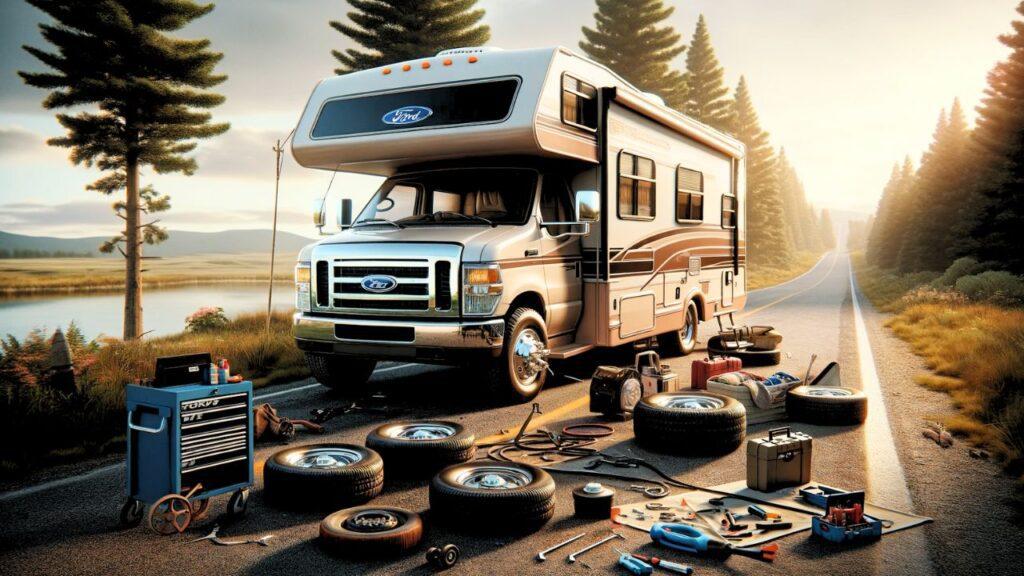
A Guide To Common RV Mechanical Problems You Need to Know!
The allure of the open road and the comfort of a home on wheels have…
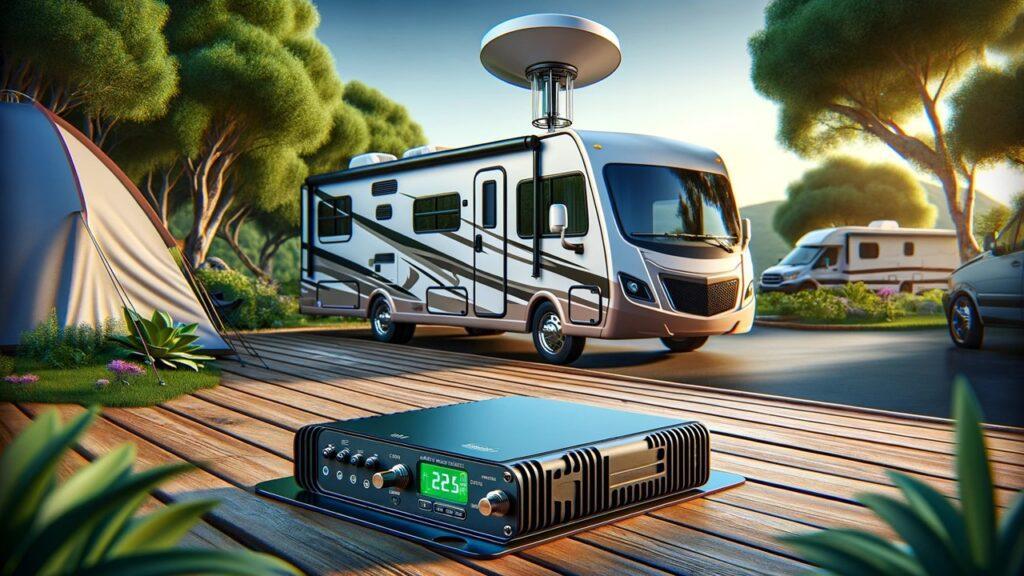
5 Best RV Cell Phone Signal Boosters for Improving Cellular Signal Strength for Seamless Communication In 2024
Navigating the vast landscapes in your RV demands more than just a sense of adventure;…
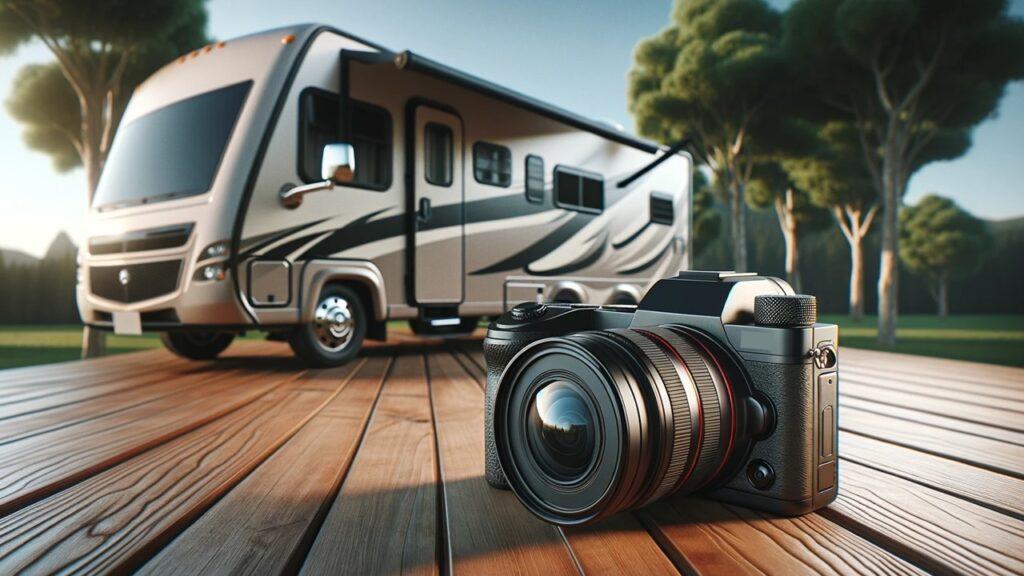
5 Best Mirrorless Cameras for Van Life To Capture High Quality Photos On The Road In 2024
Diving into the van life with a camper RV opens up a world of wanderlust,…

11 Top Reasons Why People Quit Van Life That You Need to Know!
Embracing van life is like diving into a realm where the hum of the road…
Leave a Comment Cancel Reply
Your email address will not be published. Required fields are marked *
Save my name, email, and website in this browser for the next time I comment.
- Testimonials
- Photo Gallery

Ultimate Travel Trailer and RV Maintenance Checklist
Travelling in your RV is always a breeze, but not until something goes off in the middle of the road, and ruins your entire trip. Well, you shouldn’t be surprised if you’re not running a complete travel trailer checklist or RV maintenance check as needed.
Parts and functions of your travel trailer need to be inspected and checked for a number of reasons. There might be materials that are deteriorating, parts that needed changing, or machineries that should be dusted off. Follow these tips we’ve gathered for you.
Monthly maintenance
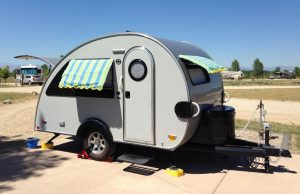
Tire pressure
People would mistake healthy-looking tires just by simply looking at them. If you’re preparing for a long trip, your tires must be ready– not overinflated or underinflated.
To make sure this won’t mess your trip, invest on a quality gauge so you can inflate or deflate your tires if necessary. Most of them come with a pressure checker so you’ll be informed.
One of the most unnoticed parts in the RV is the battery simply because it’s out of sight. But you should be able to run a check on them once a month so you’ll know what’s happening.
Clean your batteries and make sure they’re free of corrosion. Always check the water levels as water can easily evaporate during trips. Maintain them at the right level at all times.
Charge your battery correctly and make sure it reaches a full. You should never allow it to charge at less than 50%, but do not overcharge either. With a properly maintained battery, you won’t have to replace them in 5 years.
Hydraulic pump reservoir
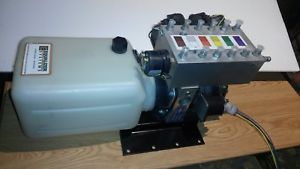
Annual maintenance
A yearly travel trailer maintenance is good for the other parts, systems and mechanisms of your RV. Your annual maintenance and spring cleaning must include the following parts:
The awning is highly vulnerable to a lot of dust from the outside, all the while rain and humidity may cause molds and mildew to accumulate. That’s why cleaning the awning is needed at least once a year.
You can either buy a cleaning solution, or just do it yourself with a simple concoction. Mix bleach and mild detergent on water and use it to spray on your awning. Retract your awning and leave it for 5 minutes before extending it again and rinsing off.
Your whole RV must be washed and waxed at least 2 times a year, especially if you’re using it very often. Start cleaning from the roof down. Brushes and scrubbers are definitely a must-have, but a pressure washer can make the job a lot easier.
RV finishes usually have a protective fiberglass layer with a gel coating. This should be washed and waxed to prevent it from damage and oxidation. For effective RV cleaning tips , ensure you follow these steps.
Water system
Water inside your RV or travel trailer is essential on every travel that’s why it needs to be properly maintained as well. Faucets must be sanitized at least 2 times a year so you’re guaranteed that water is safe to drink.
Wash and clean your water heater once a year to prevent rust from forming.
Before washing, do a roof inspection first and check if there are any leaks. There should be an ample amount of quality sealants on the surfaces that are leak-potential. Most leaks appear in the attached parts on the roof.
Clean your roof with a pressure washer, but set it to a gentler pressure. For hard-to-remove dirt, use brushes or mops to clean them.
It’s never a good thing once the sewage system gets damaged or broken. Avoid this by changing the sewer hose annually, even if it’s not yet broken.
The black tank must also be properly cleaned before and after every travel to avoid your toilet from stinking.
Windows and screens
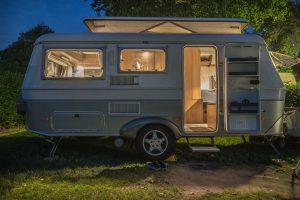
See if the glass windows have accumulated cracks or dents during rough rides. Make sure the emergency window’s lever and hinges still work properly– you never know what could happen.
For damaged windows, consider replacing them as soon as possible. Our experts at Peninsula Glass will be glad to help you with that.
Related: 5 Tips For Successful RV Window Repair
Now, have you ticked off anything yet from your monthly and yearly travel trailer or RV maintenance checklist? It’s your job to treat your RV with love so you can keep it for longer.
Author: Tim W |
Recent Posts
- Custom RV Windows: Enhance Your Travel Experience with Personalized Views
- How to Start a Sprinter Van Business?
- How to Clean Double Pane Windows? All You Need to Know
- Stress crack windshield: Everything You Need to Know
- The Simple Guide to Choosing Your RV Windows: Framed vs. Frameless

The Ultimate Guide to RV Maintenance
- Latest Posts
- How to Find the Best Small Camping Trailers with Bathrooms - September 15, 2022
- Best Cold Weather RV: Best RVs for Cold Weather RVing - September 14, 2022
- Truck Camper vs Travel Trailer: Which Is The Best For You? - September 14, 2022
With the proper RV maintenance and care, your RV can last a lifetime. This RV maintenance guide will give you all of the essential information you need to keep your RV in good shape.
- 1 Bottomline Upfront
- 2 Building an RV Maintenance Schedule
- 3 Motorhomes vs Trailers
- 6.1 Exterior Maintenance
- 6.2 Roof maintenance
- 7.1 1. Repair cracks
- 7.2 2. Clean roof
- 7.3 3. Coat with UV protectant
- 8.1 1. Wash RV
- 8.2 2. Wax or seal finish
- 8.3 3. Cover when stored
- 9.1 1. Wash awning
- 9.2 2. Use UV protectant
- 9.3 3. Inspect for holes and tears
- 10.1 1. Lubrication
- 10.2 2. Sweeper seal check
- 11.1 1. Clean coils
- 11.2 2. Clean AC drain pans
- 11.3 See some Air cooling g reviews and alternatives here:
- 12.1 Batteries
- 12.2 1. Clean battery terminal ends
- 12.3 2. Replenish battery electrolyte
- 12.4 3. Keep batteries charged
- 12.5 4. Replace batteries
- 14 Lighting
- 15 Mechanical/Chassis Maintenance
- 16.1 1. Change the oil
- 16.2 2. Top off fluids
- 16.3 3. Check for signs of wear
- 16.4 Check here some important Guides:
- 17.1 1. Top off tire pressure
- 17.2 2. Rotate tires
- 17.3 3. Repair or replace tires
- 17.4 4. Tighten lug nuts
- 17.5 5. Protecting tires
- 18.1 1. Check brake system
- 19.1 1. Grease joints
- 20.1 1. Run your generator
- 20.2 2. Change generator oil
- 21.1 RV Toilet
- 21.2 Freshwater system
- 21.3 Black water tank
- 21.4 Grey water tank
- 22.1 Check for leaks
- 22.2 Winterize pipes
- 23.1 1. Test detectors
- 23.2 2. Inspect fire extinguisher
- 24 Frequently Asked Questions
- 25 Final Notes
Bottomline Upfront
Keeping a schedule for your RV maintenance is key. Make sure you don’t neglect safety. Pay attention to any safety tasks first if you have to choose, but keeping up with all your RV maintenance tasks like the ones below is key:
- Repair cracks
- Coating roof with UV protectant
- Wax or seal finish
- Cover RV when stored
- Wash awning
- Use UV protectant for awning
- Inspect awning for holes and tears
- Lubricate slideout
- Sweeper seal check for slideout
- Clean coils in AC
- Clean Ac drain pans
- Clean battery terminal ends
- Replenish battery electrolyte
- Keep batteries charged
- Replace batteries
- Change the oil
- Top off fluids
- Check for signs of wear
- Check all tires and wheels
- Check brake system
- Check generator
- Check toilet
- Check freshwater system
- Check black and gray tank
- Inspect fire extinguishers
- Check detectors
Building an RV Maintenance Schedule

Different maintenance activities have different maintenance intervals. Some components may require yearly maintenance, while others may need to be maintained every time you use them. Creating a maintenance schedule will help keep you on track, so you don’t accidentally forget to maintain a vital component.
There are typically six different intervals for maintaining your RV:
1. Annual RV maintenance and RV repair tasks – these are typically big things such as electrical systems, propane tanks, smoke and carbon monoxide detectors, and seals.
2. Quarterly RV maintenance – these are regular upkeep items that keep your RV running smoothly. This includes filter changes, chassis lubrication, and battery checks.
3. Monthly RV maintenance – these tasks include cleaning the AC filter, washing your awning , and running your generator.
4. Weekly RV maintenance – these are regular tasks such as dumping your holding tanks, adding holding tank treatment chemicals, and clearing debris off of the roof.
5. Mile-based RV maintenance – these are specifically for the chassis of your motorhome or trailer. This list includes tire replacements, oil changes, and topping off fluids.
6. Use-based RV maintenance – these are essentials that you should complete every time you drive your RV. This list includes checking tire pressure and checking your headlights, fog lights, clearance lights, tail lights, and brake lights.
If an RV maintenance schedule book came with your RV, it might also specify these intervals. Having an RV maintenance checklist can help you stay on track.

Find all the RV parts and Mobile Home parts and supplies that you need, all in one place.
Motorhomes vs Trailers

What type of RV you have will also determine how long your maintenance list is so you can keep your RV humming along nicely for your next RV trip. For instance, a small teardrop trailer with no bathroom will be relatively short—it won’t require engine maintenance, septic tank maintenance, and oftentimes, no fresh or grey water holding tank maintenance. On the other hand, a class A motor home will make for a much longer maintenance list.
There are nine common types of RVs: class A, class B, class C, travel trailer, fifth-wheel trailer, teardrop trailer, truck camper, popup camper, and a park model. They can be split into two groups: motorhomes and trailers. Let’s go over the pros and cons of maintaining each type.
Motorhomes: class A, class B, class C
Motor homes require the most maintenance of all RVs. That’s because you have to maintain the driving components—engine, transmission, brakes—on top of the other maintenance items.
One great thing about using a motorhome is that you don’t have to worry about putting extra miles on your day-to-day vehicle. In some cases, you may be traveling thousands of miles in one trip. With a trailer, these miles will add up quickly on the vehicle you tow it with. This may put you over your allotted miles on a leased vehicle and shorten the life of the vehicle.
However, when problems do arise, repairs on a motorhome can be time-consuming and expensive. If you are a full-timer, you may also have to find another place to stay if you need to have a mechanic work on it for several days.
- Save wear on your day-to-day vehicle
- You can get around in smaller rigs without a tow vehicle
- Less set up and tear down
- More maintenance and repairs
- You may need to tow a vehicle to get around
- Repairs are often more costly
Non-motorized RVs: trailers, fifth-wheels, truck toppers

Any RV that isn’t motorized will require significantly less upkeep. Second, the difference in price, is the primary reason why many choose a trailer or a truck topper over a motorhome.
If there are fewer components, then there are also fewer things to go wrong. However, there is the added hassle of hooking up your RV to your vehicle. Plus, you have to have a vehicle capable of handling the weight of your RV.
- Far fewer components to maintain
- You can use your vehicle to get around after you set up camp
- Repairs are typically less costly
- Excessive wear on your vehicle
- Requires more set up and tear down
- Fewer features such as an onboard generator
How You Can Maintain Your RV
Exterior maintenance.
Maintaining your RV exterior will keep it looking good, and more importantly, it will keep you from running into expensive problems in the future.
Neglecting the exterior of your RV will eventually cause water damage to the internal components of your RV. Keep the exterior in tip-top shape, so your RV is ready for adventure when you are.
Here are some things you should add to your maintenance list.
Roof maintenance
One of the most neglected areas on an RV is the roof. There are three types of RV roofs: rubber, fiberglass, and aluminum. Fiberglass and aluminum roofs are low maintenance.
However, the majority of RVs have rubberized roofs which are effective but need consistent maintenance throughout the year. How much maintenance depends on factors such as:
- The weather—extreme hot or cold can cause cracks
- Whether or not you keep it under an awning or in a garage
- The age of the roof—the older, the more problems
Rubber roofing systems can be made from either EPDM or TPO. So the kinds of chemicals you can use without damaging your roof will differ. There’s no specific interval in which you should maintain your roof. However, you should check it at least once a quarter if you live in an area with mild weather, and once a month in areas of more extreme weather (Florida, Texas, Nevada, etc.).
If your RV is older than 10 years, it’s best to check it even more regularly. Neglecting your roof can lead to leaks, mildew, rotting wood, mold, and even electrical damage.
Check here more about your RV’s Roof maintenance:
- Best Material for RV Ceiling
Regular Maintainance to Keep RV Roof In Top Shape

1. Repair cracks
Cracks in rubberized roofs are very common. You will usually find cracks around the AC units, fan unit, vents, antennas, and ladder. Climb up the rear latter (if you have one) and work your way from the front of the RV to the back.
Look closely and mark any cracks you see with a pen or sharpy (you’ll cover up the marks later). Once you’ve discovered all of the cracks, make sure the area is clean (using a rubber roof cleaner) then use a self-leveling RV rubber roof sealant (this requires a caulk gun) over the marked areas.
Always keep several tubes of roof sealant handy in case you run into a leak while you’re on the road. There are two different types of rubberized roofs—each requires a different type of sealant. Check your RV owner’s manual for the proper materials to use, or you may risk damaging your roof further and voiding your warranty.
Alternatively, you can use RV rubber roof patches or RV tape. These can be difficult to get into smaller crevices, but they are effective for large flat areas. It’s best to keep roof tape or patches on hand.
2. Clean roof
Leaves, limbs, bugs, dirt, and dust quickly build up on an RV roof. Unlike the roof on most houses, there isn’t a slant on an RV roof to allow gravity to push debris off naturally. If roof buildup isn’t taken care of, it can cause damage to your roof and lead to leaks.
How much buildup occurs depends on several factors. If your RV is parked underneath a tree or if you live in an area with lots of dust and pollen, you may need to do a light roof cleaning weekly and a deep clean quarterly.
Start by sweeping off any loose debris with either a standard broom or a push broom. A regular house broom works best for tight spots like around AC units. Then, you can use a rubber roof cleaner specific to your type of rubber roof and rinse with water.
Using a noncompatible cleaner can ruin your roofing system and require a long and expensive fix. Always refer to your owner’s manual. It’s often a good idea to do a thorough clean (and let the roof fully dry) before you repair cracks to ensure your self-leveling rubber roof calk or RV tape adheres correctly.
3. Coat with UV protectant
The sun’s rays eventually wear down your RV roof, causing it to dry out, crack, and crumble. You can help prevent this by using a UV protectant. Dicor Roof-Gaurd is a trustworthy product for this job. This is essentially sunscreen for your RV.
After giving the roof a good cleaning, spread the UV protectant around on the roof using a mop or rag and let it dry on its own. This will help extend the life of your RV’s roof and prevent leaks. You should use a UV protection coating once every quarter.
Paint/finish maintenance

Maintaining the finish on the outside of your RV will keep your RV looking beautiful. While it may be a lot of work, it’s worth taking preventive maintenance measures to ensure your RV’s finish isn’t damaged by the elements. Once damage occurs, it’s very costly and time consuming to repair. Here’s how you can maintain your RV’s paint and finish.
This is a no-brainer. Keep the outside of your RV nice and clean. A quarterly wash should do the trick. However, you may need to wash your RV more often if you notice dust, pollen, and or bugs building up on the finish.
If you’re unlucky enough to experience lovebug season in Florida, you may have to scrub the front of your RV every couple days. Make sure to use scratch-free sponges and brushes to avoid damage to the finish.
2. Wax or seal finish
Once your RV is nice and clean, use wax or sealant to protect the finish from harmful sun exposure and debris. RV wax will offer protection for 2-3 months, and a sealant can offer up to 6-7 months of protection. Which you use is a matter of preference.
Some RVers say that wax looks better than a synthetic sealant. However, the long-term benefits of a sealant will save you time, energy, and money. With the exception of very small RVs, you’ll need an electric buffer.
3. Cover when stored
As far as preventative maintenance goes, storing your RV with a cover or underneath an awning can save your finish from UV rays, dirt, and other debris. If you plan on storing your RV for months at a time, it’s highly recommended that you don’t allow it to sit in direct sunlight—especially in the summer.
Awning maintenance
When you’re relaxing under your awning, the last thing you want is to feel water dripping through a hole, or to catch frequent whiffs of mildew. If you want to keep your awning working properly and avoid an expensive replacement, complete these simple maintenance tasks.
1. Wash awning
Mold, mildew, and debris can cause excessive wear on awning material. Plus, it’s not pleasant to see and smell mold when you step outside your RV. Give your awning a good scrub each time you wash your RV.
Some awning material may require special cleaners so check the owner’s manual. Always allow your awning to dry before rolling it up. Otherwise, moisture caught in the awning may cause the material to rot away.
2. Use UV protectant
The sun’s harmful rays can dry out the material your awning is made out of. This can lead to rips and holes, and eventually, you’ll need to replace your awning. However, you can use a UV protectant spray to prevent sun damage. Reapply a UV protectant each quarter.
3. Inspect for holes and tears
Once a year, perform a careful inspection of your awning. Keep an eye out for small holes or tears. Even pin-sized holes and tears can turn into large ones very quickly without attention. Patch up any holes and tears you find with an awning repair patch or awning repair tape.
Slideout maintenance

RV slideouts are great for opening up the floorplan and giving you plenty of space to move around. Slideouts are designed to be low maintenance, so you shouldn’t need to maintain them too frequently. To keep them functioning properly, there are only two maintenance tasks you need to perform.
1. Lubrication
There are special lubricants available for keeping your slideout moving smoothly. 3-IN-ONE Slide-Out Silicone Lube is one of many lubricants designed to keep slideouts working properly. One application every quarter should do the trick.
2. Sweeper seal check
RV slideouts have rubber seals around them called sweeper seals. These keep moisture and debris from getting inside your RV. However, over time they can become damaged. This can lead to water getting into your RV which will can cause extensive damage.
Check your seals at least once a year. Clean out any debris and use seal lubrication. A lubricant will help keep the rubber seals from drying out. Damaged seals will need to be replaced by a professional and could be a costly fix—but not as costly as water damage.
RV AC unit maintenance
The overhead AC unit keeps your RV cool and dry in the warmer months. Keeping it maintained will lessen the risk that it will suddenly stop working when you need it the most. Here is how you can maintain your RV AC unit.
1. Clean coils
Your roof unit has two types of coils: the condenser coil and the evaporator coil. As air passes through these, dust, dirt, and pollen build up on the coils. This causes your AC to work harder than it needs to which in turn causes excess wear on the components. Plus, dirty coils can restrict the air flow into your RV and prevent cooling.
Once a year, it’s essential to clean your AC coils. Here’s how.
- First, turn off your electricity and disconnect the house batteries. Working on high voltage components with the electricity turned on is extremely dangerous. It’s not a bad idea to use electrical gloves as well.
- Next, remove the exterior AC unit cover to expose the coils. Then, cover the opening into the RV with a trash bag, so you don’t get water and cleaner into your RV.
- Now you can spray the coils with evaporator coil cleaner and condenser coil cleaner. Let them sit for a few minutes.
- Finally, rinse off the coils with a light mist. Don’t use high-pressure water and don’t use a sponge or rag to wash your coils or you will bend the coil fins.
2. Clean AC drain pans
AC drain pans catch the moisture that your AC removes. They are notorious for getting clogged up. Not only does dirt and grime build up in the drain pan, but also critters tend to make their nests in AC enclosures which can easily lead to a clog.
Clogs can cause the pan to overflow and drip into your RV. To prevent damage to your roof, flooring, and electrical, you should clean out the drain pans once each year.
Cleaning the drain pans is simple. Run warm water through the pan with a jug and use a rag and a pipe cleaner to remove any debris. It’s important not to use any harsh chemicals since the drain pans often drain onto the rubber roof. Most cleaning chemicals will damage your roofing system. Plain old water will do the trick.
See some Air cooling g reviews and alternatives here:
- Zero Breeze Review: Is it Worth it?
Electrical Maintenance
Nearly everything in your RV requires electricity. That’s why it’s essential to keep up with your electrical components regularly. Let’s go over how to maintain each item.
Batteries are one of the most important components of an RV. There are two types of batteries you may find in an RV—chassis batteries, and house batteries. While trailers only have house batteries, motor homes use both house and chassis batteries.
Chassis batteries are used to start the engine as well as power other components such as the headlights and stereo. The house battery is a deep cycle better used for the living space. Unlike most chassis batteries, the house battery is designed to allow you to drain the battery to about 50-60% of its capacity without damaging the cells.
When you’re not hooked up to shore power or running your generator, your house battery will keep your 12-volt components running. This includes your water pump, interior lights, heater, and vent fans. Both types of batteries can last you up to five years if they are properly maintained.
Here is how you can maintain your RV battery system.
1. Clean battery terminal ends
Every year, you should do a deep clean of your battery terminals. Rust, corrosion, oil, and dirt can build up on the terminal ends. There are two problems that can occur from this buildup. First, it causes a poor connection which can lead to both insufficient power and also insufficient charging. If your battery isn’t fully charging, it will wear out quickly.
The second problem that can occur is even worse. Buildup on battery terminal ends can prevent a good connection which allows electrical arcing. This may cause the battery to explode which can destroy any nearby mechanical components and cause bodily injury.
You can use a wire brush and a mixture of one cup of hot water and a tablespoon of baking soda to clean the terminals. There are also battery terminal cleaning kits. However, these aren’t necessary. Once the cleaning is finished, rinse the terminals with water, reconnect the positive and negative terminals, and then spray with a terminal sealant to prevent future corrosion.
2. Replenish battery electrolyte
When a battery is low on electrolyte, a chemical process called sulfation begins. This will significantly shorten the life of your batteries. It’s best to check your battery electrolyte levels monthly, but for lighter use, quarterly checks should be fine. If the electrolyte level is below or near the metal plates, replenish them by adding distilled water.
3. Keep batteries charged
Just because your RV is not in use, doesn’t mean your RV batteries can’t drain. Things such as clocks, CO detectors, and meters can slowly drain your RV batteries.
While some RVs are equipped with a small solar panel to keep the battery charged, many do not. If yours doesn’t, it’s essential to either hook up your RV to a power source, run the engine, or run the generator to recharge the batteries when they get low. Check the charge of your RV batteries once a month at minimum. If your batteries remain low for a long period of time, you will shorten their lifespan.
4. Replace batteries
Regardless of how well you take care of your RV batteries, eventually you will need to replace them. Check the condition of your batteries once a year to determine if you need to replace them.
Some digital RV control panels will tell you when you’re ready for new batteries. You can also remove the batteries and check them manually. Typically, with proper upkeeping, you should expect to replace your RV batteries at least once every five years.
Keep in mind that you must replace all batteries that are in series or parallel. Keeping just one old battery can ruin your new batteries. So always replace all batteries at once.
Fuses are another vital part of your electrical system. Your owner’s manual should specify where your fuse box is and which types of fuses to use.
At least once a year, you should check all of your fuses to ensure none are blown. The last thing you want is everything in your fridge and freezer to go bad on your trip. You can use a tool to check your fuses, or, since fuses typically are transparent, you can look at the fuse to see if it’s still intact or if it’s blown.

On both trailers and motorhomes, it’s vital that you check all of the exterior lights before each trip. This includes your:
- Brake lights
- Backup lights
- Marker/clearance lights
- Turn signals
This is as simple as having someone walk around your RV while you activate each light. If you find a burnt out bulb, replace it before you hit the road.
Mechanical/Chassis Maintenance
As with any vehicle, the engine and other mechanical components in your RV need regular maintenance. Here are some ways you can maintain your RV’s engine.
1. Change the oil
This should be at the top of your list. Keeping old or overused oil in your motorhome’s engine will significantly decrease the life span of the engine as well as decrease your gas mileage.
Changing the oil yourself is easy to do and inexpensive. You can change the oil based on mileage or seasonally. Even if your RV is stored for most of the year, you should still change the oil at least once every twelve months. Using a high-mileage oil is best for frequent travelers. Be sure to change your oil filter each time you change your oil.
2. Top off fluids
Check the fluids in your RV before and after each trip as well as each month and top off as necessary. Here are the fluids you should routinely check:
- Brake fluid
- Radiator fluid
- Transmission fluid
- Power steering fluid
- Windshield wiper fluid
Aside from windshield wiper fluid, if you commonly find that any of the fluids need filling, you should inspect for a leak.
3. Check for signs of wear
Along with topping off your fluid levels, you should also look over the rest of the engine compartment regularly. Keep an eye out for cracked hoses, worn out belts, and dirty filters.
Snapping a belt while on the road can result in the loss of power steering and a hose leak could leave you stranded with an overheated engine. Catching these problems early will save you a lot of aggravation on your next trip.
Check here some important Guides:
- Our Top Diesel vs Gas RV Considerations
1. Top off tire pressure
Before every single trip and at each pit stop along the way, you should check your tire pressure. When your tire is low on air, it makes excess contact with the road which causes heat to build up in the tire.
Overheating tires is the #1 cause of tire blowouts. A blowout can cause a massive amount of damage to your RV and even be fatal. Keep in mind that it doesn’t matter how new your RV tires are, you should always check the tire pressure. You can typically find the factory-recommended tire pressure inside your RV (often in a closet, in a compartment, or near the driver seat).
2. Rotate tires
Rotations are essential for getting the most life out of your tires. Tire rotations help to spread out the burden so that the tread wears evenly. Depending on how much use you’re getting out of your RV, you should rotate your tires either quarterly, bi-yearly or annually. Don’t forget to include your spare in the tire rotation.
3. Repair or replace tires
Before you head on the road, make sure your tires are in tip-top condition. Check for wear, punctures, and bulges. If you find any issues, don’t chance it—take your RV directly to a tires specialist. You don’t want to spend the day on the shoulder of the interstate because of a flat.
4. Tighten lug nuts
Your RV wheels are held on by a series of lug nuts. Vibrations while driving can cause them to loosen up. You certainly don’t want your lug nuts coming off. Make sure they are good and tight before each trip. But be sure not to overtighten them—you want to be able to get them off when it comes time to change a tire.
5. Protecting tires
As your RV sits, harmful UV rays will cause damage to your tires. Eventually, the sun will dry out the rubber which can cause a flat or a dangerous blowout on the road. There are two ways to protect your tires.
First, you can use RV wheel covers. You simply put the covers over your wheels, and your RV’s tires will be protected from sun exposure.
However, if you move around often or prefer not to order RV wheel covers, the second option is to use a spray-on protectant. You’ll need to reapply the protectant at least once each year in cooler climates or once per quarter in warmer climates.
One of the scariest moments for any RVer is when you hit the brakes and realize you have no stopping power. Check these items off your maintenance list to ensure you don’t have this happen to you.
1. Check brake system
Visually inspect your brake pads, brake lines, and brake fluid reservoir for damage before each outing. If you notice any leaks or if your brake pads are worn out, get them repaired immediately by a professional. You should also perform an air brake test .
- Break Controllers
Your RV chassis has several joints which need to be taken care of on an annual basis. Maintaining your RV’s joints is simple, inexpensive, and will save you a hefty repair bill in the future.
1. Grease joints
Once a year, you should grease your RV’s joints. For this job, you’ll need a grease gun, the manufacturer-recommended lubricant, and a way to get up underneath your RV. Of course, you can simply take your RV to an RV garage for chassis lubrication.
Find here the best Grease products:
- Best Wheel Bearing Grease for Travel Trailers On The Market
Many class A, class C, class B, and fifth-wheel RVs have onboard generators. However, we are going to talk about generators in general since many RVers using trailers will bring along a portable off-board generator.
Your generator will be your source of electricity when you’re not able to hook up to a power source or if the power goes out at a campground. To keep your generator happy and running when you need it the most, there are a few easy maintenance tasks you need to perform.
1. Run your generator
One of the easiest ways to ensure your generator runs properly is to turn it on once in a while—even when you don’t need it. Your generator needs to run at least once a month for about an hour with a fair-sized load.
Start by letting your generator warm up for 5-10 minutes without a load. Then, increase the load by turning on your AC or other appliances. Let it run for 30-45 minutes and then allow it cool down by running it without a load again for 5-10 minutes.
This will greatly extend the life of your generator and ensure the moving parts don’t seize up. Keep in mind that you should always let your generator warm up before turning on your AC or other power-hungry appliances.
2. Change generator oil
The second easiest thing you can do to keep your generator healthy is to change the oil regularly. The owner’s manual should specify the number of hours the generator can run before needing an oil change. However, if you don’t use your generator often, you should still change your generator oil and oil filter at least once each year.
Only use the specified oil type and filter or a compatible alternative. Changing your generator oil is simple and typically only takes 15 minutes. While you’re waiting for the oil to drain, clean out any dust or debris around your generator and your generator compartment (for onboard generators). Check the oil level often and top-off as needed.
Water and Sewage System

There are three types of holding tanks you’ll find in your RV: freshwater tanks, grey water tanks, and black water tanks. Your freshwater tank is part of your freshwater system which supplies water to your faucets, toilet, and shower. Your freshwater tank will primarily be used while you’re boondocking or on the road since most campsites supply you with a fresh water supply.
Your grey water tank is for holding water from your sinks and shower. And finally, your black water tank is used specifically for toilet waste. Each of these tanks requires specific routine maintenance to function properly and prevent bad smells or contaminated water.
Nearly all RVs have these three types of holding tanks. Although, some teardrop and park model trailers do not have holding tanks at all or may use a composting or cassette toilet. Let’s talk about maintaining your RV water and sewage systems.
Classic RV toilets look a lot like the kind of toilet you’d have at home. Some of the cheaper models are plastic, but you can get porcelain versions – this is great if you want it to feel just like the real thing.
The waste goes into a black tank and is flushed away using a button or foot pedal. Sometimes you may need to add water first. You can then empty it at a dump station, using a hose.
Many people prefer the traditional type of RV toilet. They like the fact that they are permanently attached, and that they feel homely – and the emptying process is pretty straight forward and ‘hands-off’, unlike some of the other types on this list. This is a big selling point when people are considering which type of RV toilet to get. The black tanks can also hold a lot of waste – great for bigger groups of people traveling together, or if you need to wait a while between dump stations.
See Some of our RV Toilet Comparisons and Reviews here:
- Dometic 310 vs Dometic 320
Freshwater system
When you’re not using your RV, the leftover water in the pipes and fresh water tank sit which may produce harmful build-up and bacteria over time. It’s best to sanitize the fresh water system before each trip if your RV sits for more than a few months. Or, if you’re a full-time RVer, you should sanitize your fresh water system once a year.
Sanitizing your RV fresh water system is quite simple. First, fill your fresh water tank up to about halfway. Then, mix one cup of bleach into a gallon of water and pour it into the fresh water tank with a funnel. Fill the tank the rest of the way up and then turn each faucet on until you smell bleach and then shut it off. Top off the fresh water tank again and let it sit overnight.
If you can, go for a drive and let the water slosh around in the tank and faucets. Next, open all of the faucets until the fresh water tank is empty. Fill and empty the fresh water tank multiple times until there’s no more bleach coming out of the faucets.
Bonus: if you keep your grey water tank valve closed, you can let it fill up with the bleachy water which will sanitize it as well. Don’t let the bleachy water sit for too long or you may risk damaging your seals.
Black water tank

RV black water tanks are notorious for getting clogged and causing bad odors to enter into the RV when flushing. However, if you maintain your black water tank correctly, you can avoid most clogs and bad odors.
The first thing you should do to maintain your black water tank is to use black water tank treatment chemicals. Blackwater treatment helps break down waste, protect the sensors inside the tank, and prevent bad smells. Camco TST MAX toilet treatment is a go-to for many RVers since it’s easy to find at supermarkets, simple to use, and inexpensive.

Camco TST RV Toilet Treatment / 64 oz. helps to break down waste and tissue. Special fragrances has been added to help control odors. This product contains no formaldehyde, and is non staining and safe for septic tanks. Just 4 ounces will treat up to 40 gallons of water.
Simply pour the recommended amount into the toilet and flush it down with a few gallons of water. You should empty your black water tank at least once a week. For larger families, once every other day may be necessary.
As a rule of thumb, allow the black water tank to reach two-thirds full before dumping. Keep in mind that you must keep the black water valve closed at all times except for when dumping. Otherwise, solids will build up in the bottom of the tank and cause a clog. When dumping your black water tank, make sure the grey water valve is closed to prevent black water from going up into your grey water tank.
Aside from weekly emptying, you will also need to do a routine deep clean of the black water tank. Even with black water treatment chemicals and regular dumping, waste will build up on the walls which will cause false sensor readings and foul smells. Some RVs come with a flush valve. If your RV is equipped with a flush valve, simply hook up a water hose and run water into the tank to flush it out.
However, if your RV is not equipped with a flush valve, you can use an external holding tank rinser such as the Camco Swivel Stik . You stick the rinser into the holding tank, turn on the water, and it sprays water in all directions to dislodge any buildup. You should flush your black water tank out at least once every quarter. If you notice your black water level sensors are giving false readings, a deep clean may be past due.

Powerful rotary cleaning action dislodges and flushes the stubborn waste deposits and odor-causing particles left after holding tank is emptied.
Some items you should try:
- How to Find the Best RV Sewer Hose
- Best RV Toilet Treatment
Grey water tank
The grey water tank is the easiest of your holding tanks to maintain. After all, your grey water tank is primarily used to hold soapy water. If you begin to smell foul odors coming from your drains, you can flush out the gray water tank by closing the valve and filling it with hot soapy water or dishwashing detergent gel.
Go for a drive and let it slosh around and then empty the grey water tank. There are also specific products designed for rinsing the gray water tank such as Thetford’s Tank Blaster holding tank chemicals which work as well. You may get away with deep cleaning your grey water tank only once a year as long as food particles aren’t frequently sent down the drain.
The pipes in your RV are similar to what you may find in a house. However, since RVs frequently experience bumps and vibrations—as if a house regularly experienced the shock of a small earthquake—you frequently run into problems. Leaky pipes are a common problem. Here are some ways to maintain your RV pipes.
Check for leaks
Before and after outings, it’s a good idea to check your RV for leaks. Aside from the vibrations and bumps on the road, your RV also endures many different climate changes. Drastic changes in temperature can shift and crack pipes.
Check for leaks each quarter or after major climate changes. Leaks won’t necessarily appear as gushing water. Often times it’s no more than a drip. However, a constant slow drip of water can cause a substantial amount of damage over time such as dry rot and mold.
To check for leaks, start by hooking up to a water source. Keep in mind that you should always use a water pressure regulator when hooking up to water. Unregulated water can burst pipes and cause flooding. Next, let the water run in the sinks , shower, and toilet for a minute and then let the RV sit. Some leaks are so slow they may not be noticeable for several minutes. Then, check underneath all your sinks, inside your compartments. If you notice a leak, fix it right away with new pipes or reseal threading with plumber’s tape.
An effective alternative to checking for leaks is to fill your freshwater tank and turn on the water pump if your RV is equipped with these. After your water pump has built up enough water pressure, it should automatically turn off.
However, if there is a leak, it will eventually kick back on to compensate for the loss in water pressure. While this may not tell you where the leak is, it can help identify if there is a leak somewhere in your RV.
Keep in mind that you may have to sit and listen for the water pump for 10-60 minutes depending on how sensitive the water pump is to a loss in pressure and how slow the leak is. Don’t forget to include your water pump in your leak check. The seal on your water pump may wear out over time.
Winterize pipes
When storing your RV for the winter in cold climates, it’s essential to winterize your RV’s pipes. When the temperature drops below freezing, any water in your RV pipes and holding tanks will freeze.
Frozen water expands which will cause pipes to crack—leaving you with a big mess come spring. You can avoid this problem by winterizing your RV.
This is the process of draining the water from your water lines and then filling the pipes with a non-toxic RV/marine antifreeze. Keep in mind that you may need to install a water heater bypass kit if your RV does not already have a water heater bypass valve.
Safety Features

Last but not least, let’s talk about maintaining your RV’s safety features. This may be the most important of all maintenance items on your list. These are the maintenance tasks that will keep you and your family safe while on your next vacation.
1. Test detectors
In every RV, there should be smoke, CO, and propane detector. Some detectors have a replacement date written on them. If the detector is expired or close to expiring, don’t take a chance. Replace them right away. Use the test function to ensure they are working properly and change any batteries in standalone units as necessary.
2. Inspect fire extinguisher
Fire extinguishers don’t last forever. Check the expiration date if it has one, and replace the extinguisher if necessary. Inspect for any rust or other damage that may prevent it from working correctly.
Frequently Asked Questions
Question: What is the most important RV maintenance task?
Answer: Examining tires before a travel day is one of the most important tasks for maintaining your RV.
Question: How often should you change your RV’s oil?
Answer: Change your RV’s oil every 3,000 to 5,000 miles or whatever mileage your mechanic recommends.
Question: How much does an oil change for an RV cost?
Answer: An RV oil change can cost around $80-$100.
Final Notes
Keep in mind that this isn’t quite an exhaustive list of RV maintenance. Units such as the refrigerator, microwave, range, water heater, furnace, and vents may also need occasional maintenance. However, this guide has covered the basics which will prepare you for the RV life. While these maintenance tasks may seem overwhelming at first, they are worth the enjoyment that comes with traveling.

Vintage Trailer Supply's mission is to make restoring trailers possible by engineering and sourcing the highest quality, most authentic reproduction and replacement parts in the world.
Further read:
- Best RV Jack Stands: All You Need To Know About
- Best Replacement Flooring for RV
- How to Tell If the RV Converter Is Bad: Our Guide
- The Best 30 Amp RV Plugs Out There!

Travels with Ted
Free RV Maintenance Checklist: 13 Important Tasks
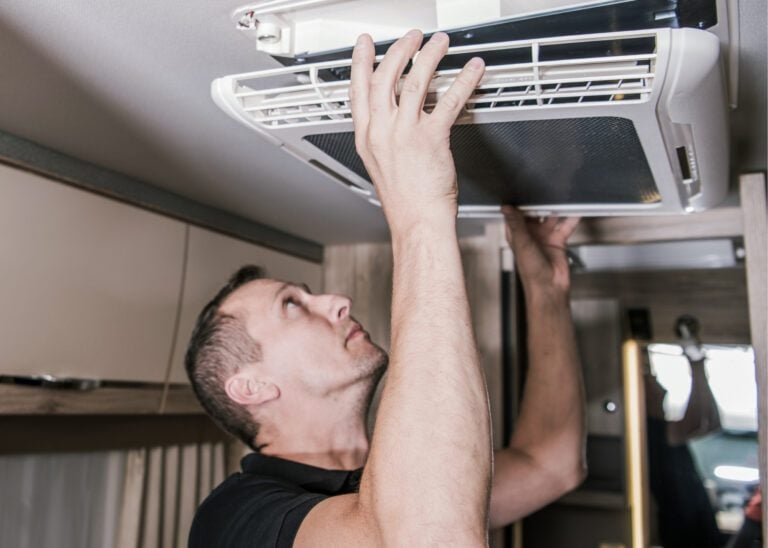
This post may contain affiliate links. See our affiliate disclaimer here.
Regular RV maintenance helps keep your camper or motorhome out of the shop and out on the road. Performing your own maintenance also saves RV owners hundreds of dollars each year.
However, it can be difficult to keep track of all the maintenance tasks and when they should be completed. Our RV maintenance checklist is a great tool for RV owners to keep track of necessary tasks to keep their RV in tip-top shape.
- 1 Printable RV Maintenance Checklist
- 2.1 Repair Exterior Seals
- 2.2 Lubricate Tank Valves
- 2.3 Inspect Tires
- 2.4 Inspect Exterior Stairs
- 2.5 Check Plumbing Connections
- 3.1 Air Conditioner Maintenance
- 3.2 Water Heater Maintenance
- 3.3 Furnace Maintenance
- 3.4 Inspect Safety Equipment
- 3.5 Inspect the RV Roof
- 3.6 Clean and Defrost the Refrigerator
- 3.7 Sanitize your Fresh Water Tank
- 3.8 Recertify Propane Tanks
Printable RV Maintenance Checklist
Click the image below to sign-up for our mailing list and receive your free RV maintenance checklist. Then, scroll down for detailed RV maintenance instructions.
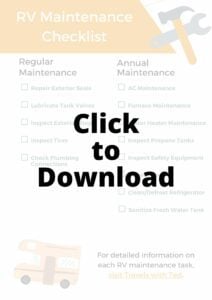
Regular RV Maintenance Checklist
Repair exterior seals.
Keeping all of the seals around your RV’s exterior doors, windows and storage bays is critical for preventing water damage. Visually inspect the seals each month.
Any spots with cracked, chipped or thinning sealant needs to be re-sealed. Before applying the sealant, remove the old sealant. Then, place painters tape above and below the sealant line to ensure even lines.
Apply the new sealant with a caulk gun and remove the tape after 3 to 5 minutes. Check the forecast and make sure there is no rain for at least 24 hours so they sealant has time to dry.
See our guide to RV sealants for more details.
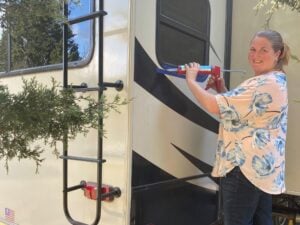
Lubricate Tank Valves
The handles for RV black and gray tanks need to be lubricated. If they are not properly lubricated, the handles can stick and your black tank can get stuck in the open position. To prevent sticky handles, lubricate them regularly.
First, empty all of your holding tanks. Then, pull one handle out and spray Teflon lubricant on the metal rod. Slowly pull the lubricated handle in and out a few times. Repeat for the other tanks. Always pull the handles straight out, twisting can damage the connected cables.
Inspect Tires
RV tires should always be inspected before travel. Start by checking the pressure of each tire. The recommended tire pressure is noted on the sidewall of your tires. Owning your own air compressor is ideal, so tire pressure can be adjusted before driving.
Next, use a tread depth gauge to measure the tires’ tread depth. Place the gauge in the cracks of your tire’s tread located near the tire indicators. If your tire’s tread depth is below 2/32 of an inch, it’s time to replace your tires. Finally, visually inspect the tires for wear and cracks.
Don’t forget to also inspect your spare tire. Spare tires should be inspected every 5,000 miles (or at least every 6 months if you travel short distances).
To ensure you have a safe back-up on the road, check the tire pressure of the spare and visually inspect it for cracking or other damage.
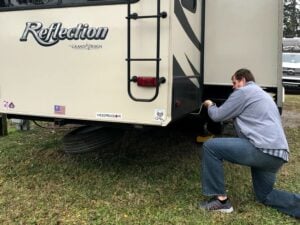
Inspect Exterior Stairs
Like all things in an RV, entrance stairs need to be routinely inspected. The most common issue with stairs is screws coming loose during bumpy travel days.
Check the screws every month or so to make sure they are secure. Always have extra screws on hand, in case one completely pops out. Also, consider updating your RV stairs to one of these sturdy units with a top deck.
Check Plumbing Connections
The plumbing line connections in RVs are attached with clamps. These clamps can easily come loose during travel or due to high water pressure. Once a clamp detaches, water will flow out and can cause a major flood.
These fittings should be checked regularly to ensure they are tight and undamaged. Carry extra clamps and a Pex crimping tool in your RV to repair any loose connections.
It is always a good idea to turn off your water pump or the city water before leaving your RV. If a leak happens when you are away from your camper, it can turn disastrous quickly.
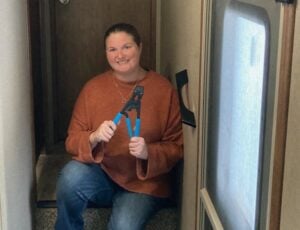
Annual RV Maintenance Checklist
The below tasks should be performed one each year. If you store your RV during the winter, it is ideal to perform appliance maintenance in the spring after de-winterizing your RV .
Air Conditioner Maintenance
Rooftop RV AC units need to be cleaned and serviced annually. Properly maintaining RV air conditioners does require climbing onto the roof of your RV.
If you are not comfortable standing on your roof, schedule annual maintenance with a certified RV technician. If you feel comfortable completing the service yourself, see our step by step guide to air conditioner maintenance.
Water Heater Maintenance
Another RV appliance that must be serviced annually is the water heater. Water heaters should be cleaned at least once every year to flush out sediment that has built up and prevent damage.
Cleaning your water heater is a simple process that most RV owners should be able to do on their own. See our guide to maintaining RV water heaters for step by step instructions on how to clean Atwood and Suburban water heaters.
Also, don’t forget to fully drain your RV water heater before winterization .
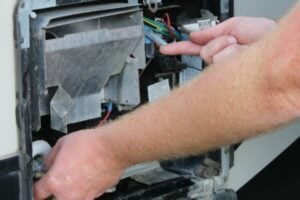
Furnace Maintenance
RV furnaces should also be serviced and cleaned annually. To service forced-air RV furnaces (found in most modern RVs), first turn off the RV’s power sources. Then, locate your furnace vent on the outside of your RV, unseal the exterior compartment and remove the furnace cover.
Start your furnace maintenance with a visual inspection of the circulation and combustion wheels. Remove any debris or obstructions. If the wheels are dirty, use compressed air to clean.
Next, visually inspect the burners. If the burners have debris or corrosion buildup, remove them and clean them with a wire brush . Also inspect the heat exchange / combustion chamber. Replace if there are any cracks or holes.
Finally, inspect the rest of the unit and the control compartment. Remove any obstructions or nests, and clean any dusty or dirty parts.
Inspect Safety Equipment
All RVs should have both a fire extinguisher and a gas detector. RVs come with one of two types of fire extinguishers, rechargeable and disposable. If your fire extinguisher has a dial with “recharge” and “overcharge” sections, it is rechargeable.
Rechargeable extinguishers should be serviced every 6 years. Check with the local fire department to see if they offer this service. Disposable fire extinguishers have a dial that reads either “full” or “empty.” The fire extinguisher needs to be replaced if the dial is pointing to empty.
RV gas detectors also need to be replaced regularly. These detectors typically have a lifespan of about five years. If you have a used RV and do not know when the detector was installed, the production date is printed on the back.
It is best to always have a replacement detector on hand, so a new one can be installed as soon as the old one malfunctions.
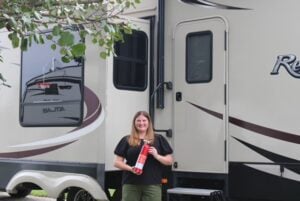
Inspect the RV Roof
You should inspect your RV roof at least once annually. However, full-time RVers or frequent travelers may want to inspect their roof every 3 to 6 months. First visually inspect all seals on the edge of the roof and around vents, racks and appliances.
Look for cracks or voids in the seals, and add lap sealant to any areas where seals are damaged or missing. Next check the roof for cracks, tears or bubbles. If there is major damage to the roof, take your RV into a service center for repairs.
Clean and Defrost the Refrigerator
If your RV is put into storage during the winter, your refrigerator should be cleaned and defrosted before storing. (See our guide to RV winterization for more storage tips).
Campers who use their RV year-round, should defrost their fridge annually or whenever excessive frost builds up on the fridge’s cooling fins.
The proper way to defrost an RV fridge is to simply turn it off, open the doors and let the ice and frost melt inside. After defrosting is complete, clean up excess water and completely dry the inside before tuning the fridge back on.
Never use a scraping tool or a heat source to melt the ice as both could damage the cooling fins.

Sanitize your Fresh Water Tank
RV fresh water tanks also need regular cleaning. These tanks should be sanitized on new RVs before your first trip, annually after long periods of storage and after contamination (i.e. filling with water in Mexico).
To sanitize your fresh water tank, simply empty the tank, fill it back up with a mixture of bleach and potable water, let the solution sit for several hours and thoroughly drain and flush the tank.
See our step by step guide to cleaning RV fresh water tanks for more detailed instructions.
Recertify Propane Tanks
One RV maintenance item that must be completed by a professional is propane tank recertification. Portable propane tanks found on travel trailers and fifth wheels must be recertified every 10 years.
To see when your tank was manufactured check for a stamp near the top of the tank on the collar. The stamp should also state when the tank needs to be recertified (typically 10 years from the date of manufacture).
When it’s time for recertification, head to AmeriGas or another propane dealer that offers the service. After the initial recertification, tanks should be recertified every 5 years
While RV travel is fun, RV ownership requires knowledge about maintenance and travel to prevent accidents. See our comprehensive list of RV camping tips for more information you should not travel without.
Do you perform RV maintenance on your own or do you take your RV into the shop? Share your maintenance style with us in the comments section below.

Christina Pate is a seasoned full-time RVer who, along with her husband Justin, has journeyed across the US, Canada, and Mexico. Drawing from her extensive travels, RV repairs and RV renovations, she founded Travels with Ted to guide and inspire fellow RV enthusiasts. Christina is also the co-author of The Owner’s Guide to RV Maintenance and the creator of My RV Log Book .
New from ACTIVE: Check out our latest products here
RV Maintenance: Ultimate Guide

Ever found yourself on the road, humming along to your favorite tunes in your RV, only for a mechanical hiccup to throw a wrench into an otherwise perfect trip? If you answered yes, then this RV maintenance guide is for you.
We’ve all heard it before, “prevention is better than cure” and guess what? This holds true even for maintaining our homes-on-wheels. Proper care can keep us from unnecessary pit stops and hefty repair bills.
What should you do to maintain your RV? Do you need to do something with the RV engine? What about the hydraulic filters?
For the answers, be sure to keep reading. We’ll be going over everything you need to know in our ultimate RV maintenance checklist!
Table of Contents
Importance of RV Maintenance
Maintenance tasks aren’t just chores, they’re vital for your RV’s longevity and performance.
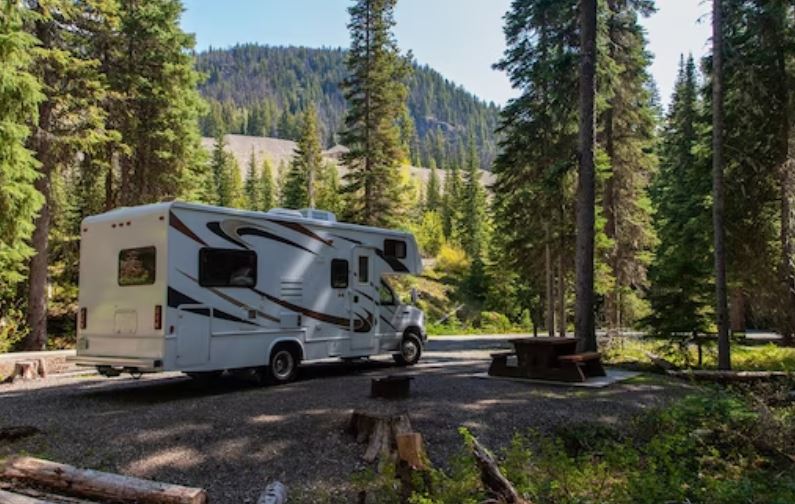
Not only that but you also want to check the vehicle’s body seams, seals, gas detectors, and bearings on a regular basis.
In fact, 70% of RV failures are from inadequate maintenance.
The resale Value of your RV also depends heavily on how well maintained the vehicle is so if you plan on selling it at some point, it’s best to take care of it.
Tip: We highly recommend following an annual RV maintenance checklist – that way, you’ll always be on top of things.
What Happens If You Neglect RV Maintenance
Things can quickly get out of hand if you neglect the tasks mentioned above. For one thing, it might result in costly repairs.
For example, a leaky roof vent or poorly cared for water pump can lead to irreversible water damage, which isn’t cheap to fix.
Similarly, you can damage your RV’s engine if you fail to change your oil and filters regularly.
Essential Pre-Trip RV Checks
These essential checks will ensure safety and prevent potential issues on the road.
Check Your Appliances Before Traveling
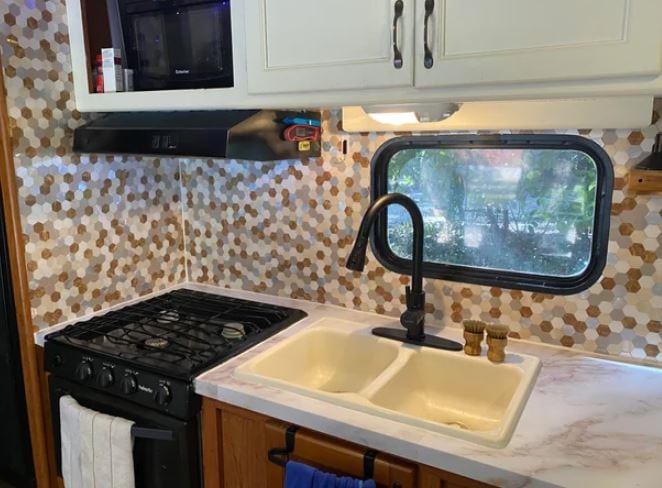
Don’t forget about the kitchen area as well. More specifically, you want to confirm that appliances like fridges and stoves are switched off before traveling.
That will help prevent unnecessary energy consumption. Not only that but it’ll also prevent hazards such as gas leaks or fire incidents during transit.
Check Tread Wear and Tire Pressure
Maintaining correct tire pressure isn’t just about fuel efficiency; it’ll also impact your RV’s handling characteristics. That’s one of the reasons why checking your RV tires is high up on the maintenance tasks list.
In addition to checking your tire pressure – particularly after long periods in storage – pay attention to the tread wear patterns; uneven wear can indicate alignment problems that require immediate action.
The wheel bearings should also be serviced every 10,000 miles or annully, whichever occurs first.
Tip: You can protect your tires by using RV tire covers – that’ll protect them from the elements including UV rays from the sun.
Check the Water Tanks
As an RV owner, you want to check the freshwater tank and black tank regularly for leakage or contamination.
The grey water tank also needs periodic cleaning – that will prevent unpleasant odors and protect against costly repairs. To keep your black and grey water tanks functioning properly and decrease odors, we recommend using ACTIVE RV Holding Tank Treatment regularly.
Turn Off the Water Heater
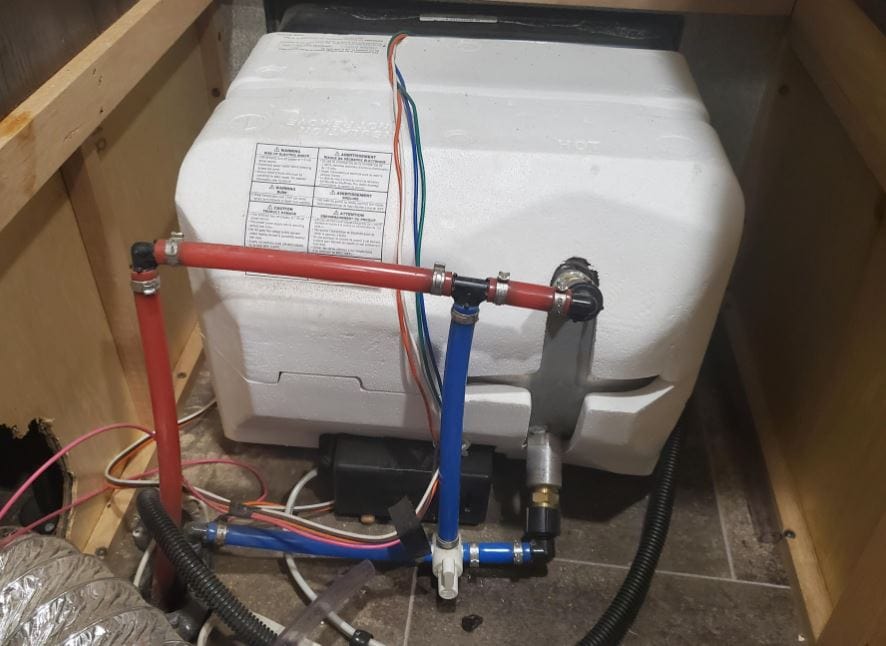
Check Your Safety Equipment
Make sure you’ve packed all of your safety equipment with you before your trip. This includes a carbon monoxide detectors, fire alarm, fire extinguishers, battery monitor, smoke detectors, surge protector, and a first aid kit.
It’s also a good idea to have some distilled water with you, just in case.
Monthly RV Maintenance Tips
Here are some RV maintenance tips that’ll help ensure that every inch of your RV—from the roof vents down to the tire pressure—is properly cared for and ready for travel.
Secure Your Items Inside the Vehicle
Before hitting the road, make sure large items are secure, cabinets are closed tight, and doors are latched—these simple steps can prevent unwanted accidents during transit.
If you have a propane tank in the RV, it should also be properly stored.
Inspect the Roof
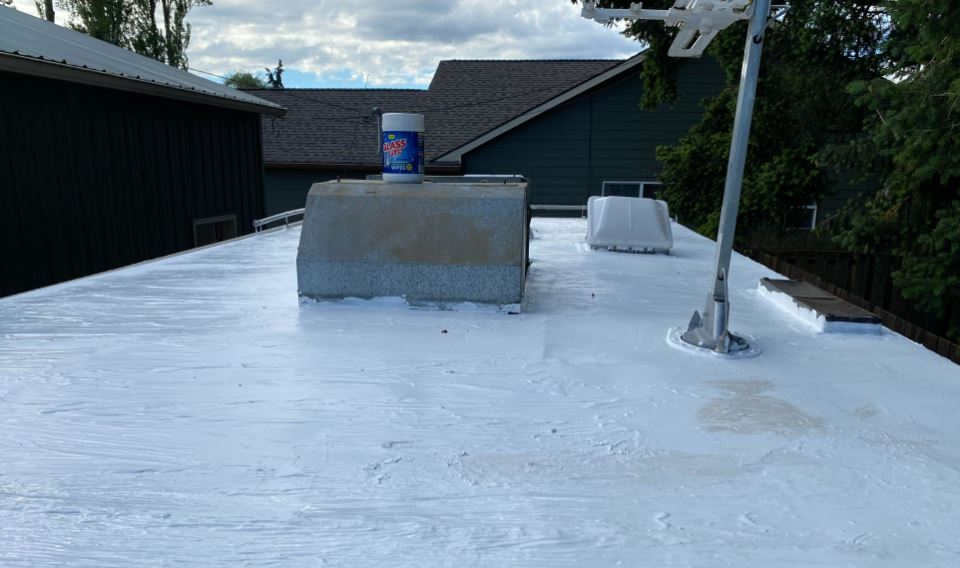
You also want to keep it clean. When it comes to cleaning products, you’ll want to find options that are tough on dirt but gentle enough not cause any harm.
Protect the Roof
You can protect your RV’s roof by applying RV Roof Magic – it’s designed to protect your roof from the elements and environrmental hazards.
Check the Brake Lights
Make sure the brake lights are working properly. The best way to do this is to get someone to stand behind the RV and tell you if they’re turning on.
Systems Maintenance Checklist
Maintaining the key systems in your RV, such as the water system, water filter, propane system, electrical system, and appliances is essential. Here’s what you need to know.
Check Your HVAC System
Your HVAC system, including the air conditioner and air filter, needs regular attention.
More specifically, you want to check that the intake is clean and clear of dust and debris. You should also check the filters and examine the divider dam, insulation, and gaskets.
In addition to that, you want to inspect the ductwork, including the hydraulic filters, regularly for damage.
The Electrical Systems
The heart of any modern RV is its electrical systems – without them, your vehicle wouldn’t be able to function properly.
Proper maintenance here involves checking wires for fraying or wear and tear, ensuring circuit breakers function correctly, and keeping batteries at correct charge levels.
If anything looks amiss, consider getting professional help at a repair shop.
Mechanical Maintenance
The heart of your RV lies in its chassis and mechanical components. Neglecting them can lead to expensive repairs, but regular maintenance will keep you cruising smoothly.
Checking Your RV’s Brakes
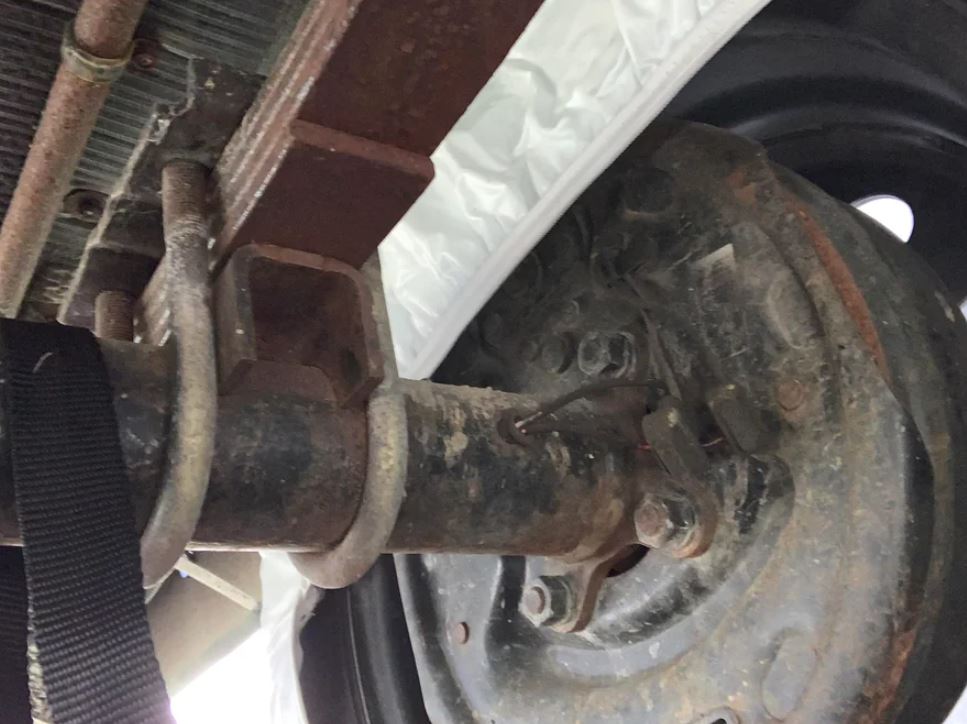
If you aren’t able to perform the maintenance yourself, seek help from a professional at an RV service center.
Regular Oil Changes
Routine oil changes are essential not just for cars but also for RVs. Clean oil will ensure proper lubrication, which will prevent overheating.
That’s not all, it’ll also remove any contaminants that may harm your engine over time.
Common Mistakes
Maintaining your RV is essential to ensure it stays in excellent condition, but if you’re not careful, mistakes can lead to expensive repairs.
Neglecting the Tires
It might seem minor, but if ignored, these things can snowball into big problems. For instance, underinflated RV tires wear faster and are more prone to blowouts.
Neglecting Oil and Brake Fluid Changes
The second blunder is ignoring your manufacturer’s recommendations for things like oil change and brake fluid change intervals or lug nuts torque specifications. Your tow vehicle needs regular love too.
Neglecting the Slide Outs and Roof Vents
Sometimes even diligent owners forget about areas of their rig that require maintenance only occasionally – such as roof vents or slideouts – leading us straight into mistake three. Regular inspections prevent unwanted surprises down the line.
The fourth gaffe lies with batteries – out of sight often means out of mind until it’s too late and we’re dealing with a dead RV battery just when we need them most during camping season.
Basic RV Maintenance Tips – FAQs
What does yearly maintenance entail for a rv.
Yearly RV maintenance includes inspecting and servicing systems like plumbing, electrical, and propane. It also involves checking brakes, tires, and roof seals.
How often should you service your RV?
You need to service your RV at least once per year. However, high usage might necessitate more frequent check-ups.
What not to do when buying an RV?
Avoid buying an un-inspected used RV or one that doesn’t fit your travel style. Also, don’t ignore hidden costs like insurance and storage fees.
How many miles should an RV last?
An average gas-powered Class A motorhome could easily cover 200k miles if well-maintained, while diesel engines can go beyond this range.
Does the entire RV need annual maintenance?
Yes, the entire RV – both the interior and exterior needs to be maintained regularly. For more details, refer to the owner’s manual.
Routine Maintenance For Your RV
And there you have it- some basic RV maintenance tips! As you can see, there are several things that you want to consider when it comes to keeping your RV in tip-top condition – from checking the tire pressure to the RV’s batteries.
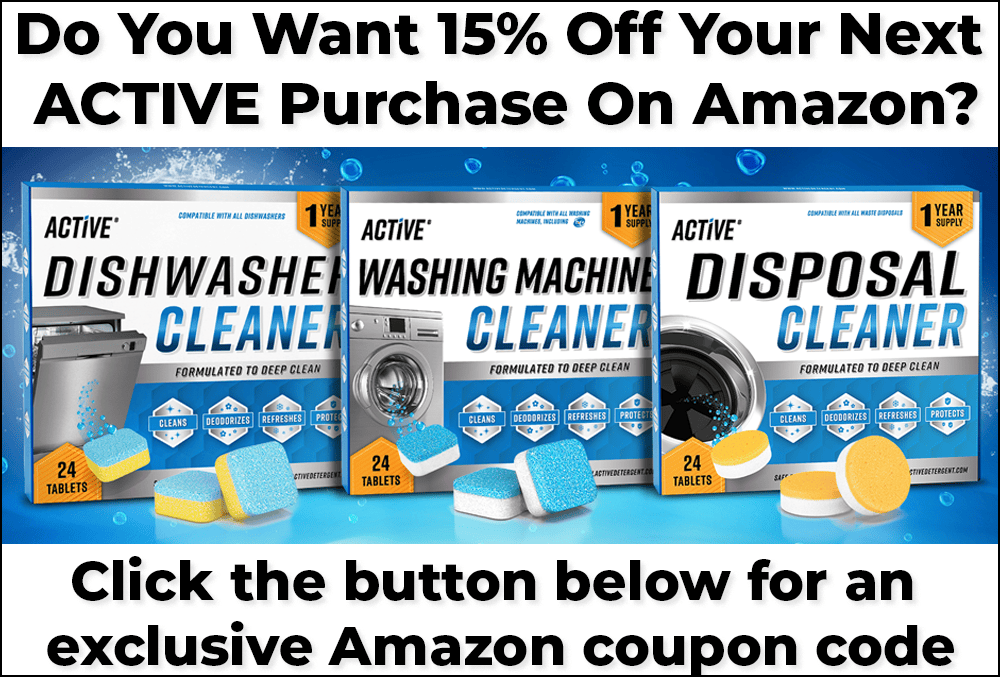
15% Off Amazon Coupon
Click To Reveal The 15% Off Coupon Code For Your Entire ACTIVE Purchase At Amazon.com
Note: This promotional offer is only guaranteed through the end of the day.
Click this link to view on Amazon

Marcus Washington
Leave a reply cancel reply.
Your email address will not be published. Required fields are marked *
Save my name, email, and website in this browser for the next time I comment.
Continue Reading

How to Wash Bzees Shoes & Boots

How to Clean & Deodorize Stinky Lacrosse Gear

How Often Should You Wash Bed Sheets?

RV Maintenance Checklist | What I Do
Owning a recreational vehicle enables pursuits of new horizons and adventures. But keeping your home on wheels functioning optimally over miles of travel requires diligent care and maintenance along the way. Use this RV maintenance checklist to help monitor critical components and prevent avoidable breakdowns or hazards.
Performing routine upkeep catches minor issues before they become major headaches down the road. Prioritize safety and reliability with regular recreational vehicle inspection and servicing.
Let’s explore the nuts and bolts of maintaining your RV, ensuring that every trip is a smooth ride into the sunset.
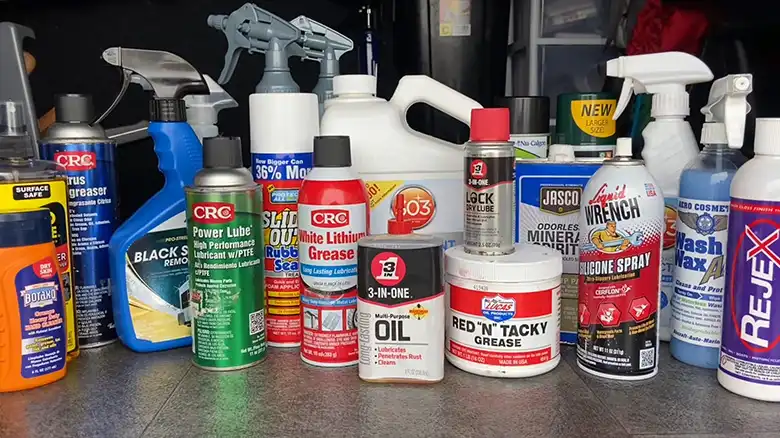
Why Consistent RV Maintenance Matters
Before we roll up our sleeves and open the checklist, let’s understand why routine RV maintenance is the unsung hero of your travel escapades. Imagine cruising down the highway, wind in your hair, only to be halted by a preventable breakdown. Regular maintenance ensures your RV stays road-worthy, reduces the risk of unexpected issues, and extends the lifespan of your beloved rolling abode.
Like any complex vehicle, RVs suffer wear and tear from road vibrations, weather exposure, and component aging. Without proactive stewardship, problems accelerate. Skipping maintenance leads to:
- Costly unexpected repairs from sudden breakdowns
- Extended downtime being stuck at repair shops
- Potential safety risks from tire blowouts, faulty brakes or other failures
Don’t learn the hard way by letting preventative care slide. Keep your investment protected and mobile with some basic mechanical skills and this checklist guide.
Checking Maintenance List Before Each Trip
Quick pre-departure inspections ensure readiness to cruise safely. Always check:
- 1. Inspect Tires
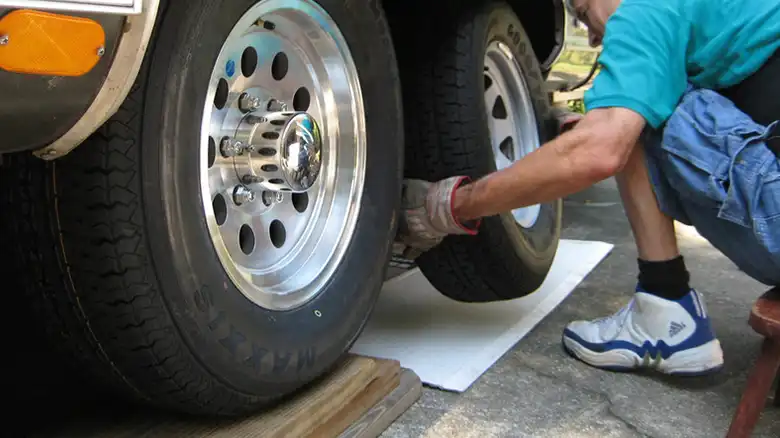
Before you hit the road, give your tires some love. Check for proper inflation, tread wear, and any visible damage. A well-maintained set of tires ensures a smooth and safe journey.
- 2. Test Lights
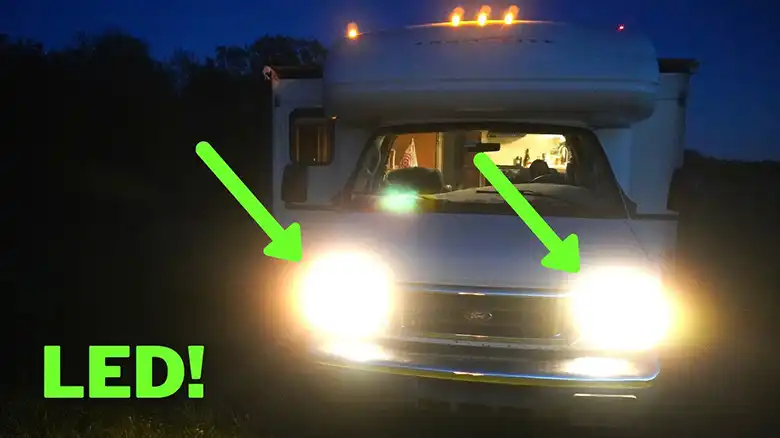
Visibility is paramount, especially during nighttime drives. Test all exterior and interior lights to guarantee they’re in working order, keeping you visible and safe on the road.
- 3. Check Trailer Hitch/Towing Components
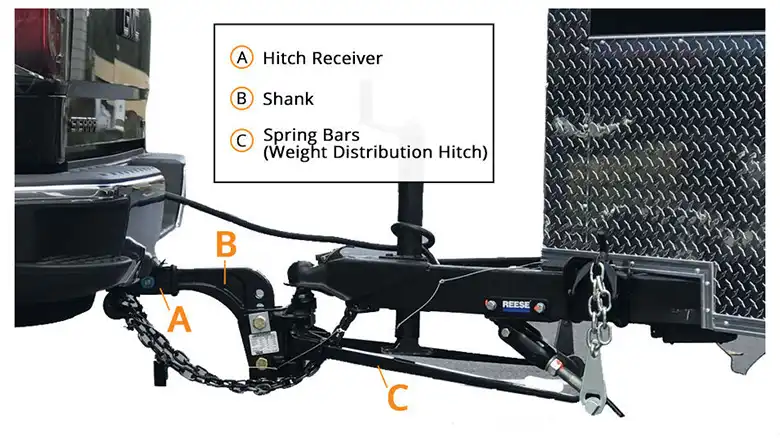
For towing enthusiasts, ensuring the hitch and towing components are secure is non-negotiable. A thorough check ensures a secure connection between your RV and any towed vehicles.
- 4. Inspect Propane System
Propane powers many essential RV functions. Inspect the system for leaks, ensure connections are tight, and verify that all appliances are functioning correctly.
- 5. Clear Debris from Roof
A clean roof isn’t just cosmetic; it prevents water damage and maintains your RV’s structural integrity. Remove debris, leaves, and other gunk to keep your roof in top shape.
- 6. Test Electrical Components and Appliances
From your air conditioner to the coffee maker, test all electrical components and appliances to guarantee they’re ready for action. A pre-trip check ensures no unpleasant surprises mid-journey.
- 7. Secure Interior Items
Prevent the ‘RV shuffle’ by securing interior items. A quick walkthrough to ensure everything is stowed away properly avoids potential damage during transit.
Monthly Maintenance Checks
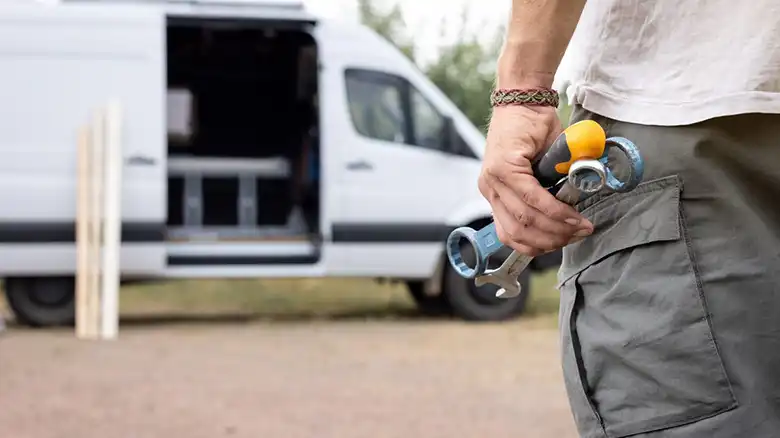
On a monthly basis, examine:
- 1. Drive Motorhome
Even if your RV sits idle for most of the month, take it for a spin. Regular movement prevents tire flat-spotting and ensures all systems remain lubricated.
- 2. Run Generator
Generators need exercise too. Running it monthly keeps the engine lubricated and the generator ready for action when you need it most.
- 3. Check Battery Water Levels
Batteries are the lifeblood of your RV. Regularly check water levels, top up distilled water if necessary, and ensure connections are clean and tight.
- 4. Clean A/C Vents and Ducts
Air quality matters. Regularly clean A/C vents and ducts to ensure a steady flow of clean, cool air throughout your RV.
- 5. Inspect Under Hood
An often-overlooked area, the RV’s under hood deserves attention. Check for any signs of wear, loose connections, or leaks to keep your engine running smoothly.
- 6. Inspect the Underside of the RV
Your RV’s underbelly can face harsh conditions. Regular inspection ensures no surprises, such as damaged pipes or potential pest infestations.
- 7. Test Safety Equipment
Safety first! Test smoke detectors, carbon monoxide detectors, and fire extinguishers to guarantee they’re ready to protect you in case of an emergency.
- 8. Check Seals
Water damage can be a silent killer. Regularly inspect and replace worn-out seals to keep your RV watertight and free from leaks.
- 9. Lubricate Slideouts
Keep your slideouts gliding smoothly by regularly lubricating the moving parts. This simple step prevents jams and extends the life of your slideouts.
- 10. Check for Pests
Unwanted guests aren’t just limited to human campers. Regularly check for signs of pests and take preventive measures to keep critters at bay.
Fixing small problems now prevents bigger headaches later.
Seasonal Maintenance
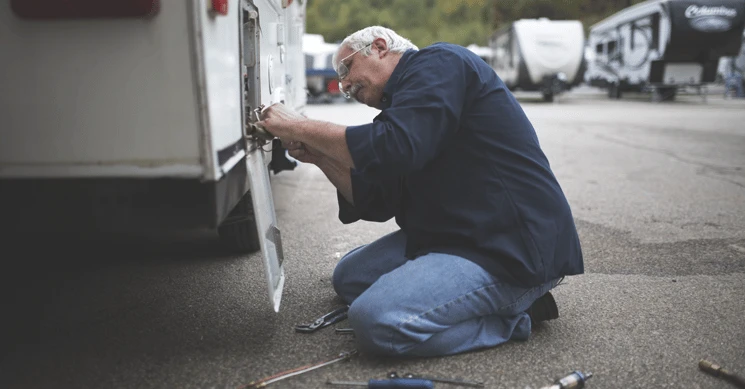
Major maintenance tasks should occur 2-4 times per year before/after peak travel seasons:
- 1. Wash and Wax Exterior
Give your RV a spa day! Washing and waxing the exterior not only keeps it looking sharp but also protects it from the elements.
- 2. Deep Clean Interior
A clean living space is a happy living space. Deep clean the interior, paying attention to nooks and crannies that are often overlooked.
- 3. Clean or Replace the Awning
Awnings provide shade and comfort. Regular cleaning or replacement ensures they stay functional and add to the aesthetic appeal of your RV.
- 4. Change Fluids
Oil, transmission fluid, brake fluid – they all play crucial roles. Regular fluid changes keep your RV’s vital systems operating smoothly.
- 5. Replace Filters
Clean air is essential for a pleasant journey. Replace air, fuel, and water filters as part of your seasonal maintenance routine.
- 6. Flush and Clean Holding Tanks
Maintain your RV’s plumbing by regularly flushing and cleaning holding tanks. This prevents odors and ensures efficient waste disposal.
- 7. Weigh RV
Weight matters. Regularly weigh your RV to ensure it stays within its recommended weight limits, optimizing safety and performance.
- 8. Treat Metals
Prevent corrosion by treating exposed metals. A protective coating goes a long way in preserving the structural integrity of your RV.
Annual Maintenance
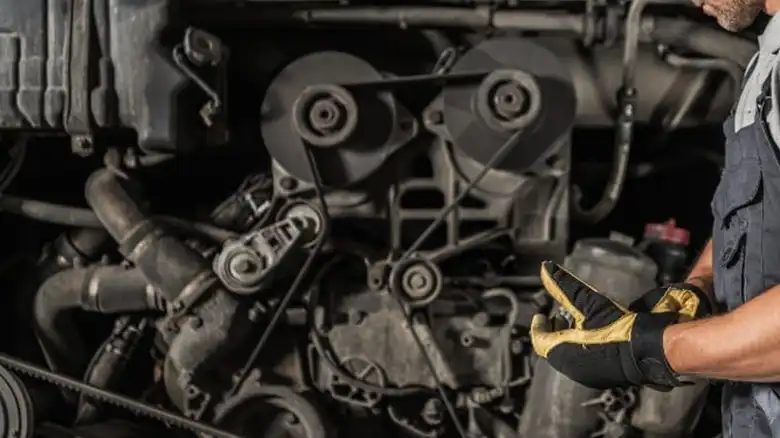
Critical annual servicing jobs:
- 1. Service A/C and Furnace
Extreme temperatures demand a well-functioning HVAC system. Annual servicing ensures your A/C and furnace keep you comfortable year-round.
- 2. Service Brakes
Brakes are your RV’s safety net. Yearly servicing, including inspection and potential replacement, guarantees they’re ready for any unexpected stops.
- 3. Inspect Propane System
Propane safety is paramount. An annual inspection ensures there are no leaks or issues, keeping your propane system in top condition.
- 4. Reseal Exterior
Protect your RV from water damage by resealing exterior seams and joints. This simple step prevents costly repairs and maintains your RV’s structural integrity.
- 5. Sanitize Water System
A clean water system is a healthy water system. Sanitize your RV’s water system annually to ensure safe and clean drinking water.
- 6. Update Maintenance Log
A well-documented maintenance log is your RV’s health history. Update it annually to track all maintenance activities and identify patterns.
- 7. Rotate Tires
Even wear on your tires is crucial for safety. Annually rotating tires ensures even tread wear, extending their lifespan.
Don’t overlook in-depth annual checkups. Identify developing problems early.
Essential RV Amenities
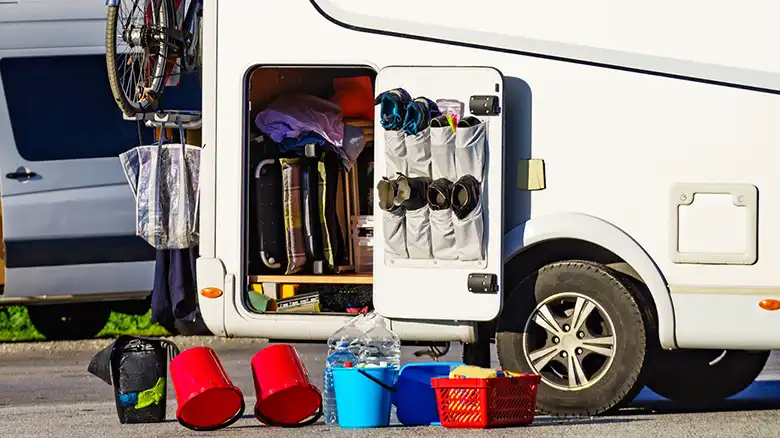
Ensure you have the essential components for RV travel. Because it is crucial for a smooth and enjoyable experience. Here’s a summary of the must-have items:
- Wheel Chocks: Keep your RV stable and secure, preventing it from rolling away.
- Levelers: Ensure your RV is level for proper equipment functionality, especially on uneven ground.
- Drinking Water Hose: Use a dedicated hose to fill your freshwater tank at each destination; choose a potable water hose.
- Water Filter: Protect your pump and drinking water by using a water filter to remove debris.
- Sewer Hose: Invest in a quality 10- to 20-foot sewer hose with adapters to ensure effective waste disposal.
- Surge Protector: Safeguard your electronics from electrical surges and dips commonly found at campgrounds.
- Shore Power Cord: If your RV lacks a power cord, use a shore power cord instead of a regular home extension cord.
- Electrical Adapters: Carry adapters to adjust to different service outputs or receptacles as needed.
- Water Pressure Regulator: Use a valve to moderate water pressure from different sources, protecting your plumbing.
- Tire Pressure Gauge: Keep a digital pressure gauge handy to check and maintain proper tire pressure.
- Duct Tape: A versatile tool for quick fixes in various situations.
- Flashlight: Have a powerful, durable flashlight with long-lasting batteries for emergencies.
- Emergency Road Kit: Include essentials like water, blankets, ice scrapers, tire chains (in winter), tools, a first-aid kit, and more.
- Extra Motor Oil and Transmission Fluid: Keep some on hand for potential breakdowns far from a gas station.
- Fire Extinguisher: Carry a fire extinguisher for safety, addressing potential engine or RV-related fires.
- Closed Bag for Important Documents: Include documents such as registration, insurance, reservations, prescriptions, emergency contacts, allergies, etc.
Being well-prepared with these essentials ensures a safer and more comfortable RV travel experience, allowing you to handle various situations that may arise on the road.
Regular RV maintenance isn’t just a checklist; it’s your ticket to endless, worry-free adventures. By investing time and effort in routine care, you’re not just maintaining an RV; you’re nurturing a lifestyle. DIY maintenance is empowering, but safety comes first. Use appropriate safety gear, follow manufacturer guidelines, and don’t hesitate to seek professional help when in doubt. While DIY maintenance is commendable, there are times when expertise is crucial. Seek professional help for complex issues, major repairs, or if you’re unsure about a particular maintenance task. Safe travels! Please share your own RV maintenance tips or questions below.
FAQ – Navigating Curves in the Road
Is It Hard to Maintain an RV?
Maintaining an RV involves routine tasks that, with proper guidance, can be manageable. While some aspects require attention to detail, many routine checks are accessible for RV owners.
What’s the Average Maintenance Cost of an RV? (Monthly, Annual)
The average monthly maintenance cost for an RV can range from $100 to $500, depending on factors like age, usage, and DIY versus professional maintenance. Annual costs can vary from $1,200 to $6,000 or more.
Similar Posts

How to Open an RV Emergency Window from Outside | A Lifesaving Guide
If you’ve ever found yourself in a sticky situation, trapped inside your RV, and needing to escape in a hurry; you know just how crucial it is to understand how to open an RV emergency window from the outside. RVs are a great way to explore the world, but they come with their own set…
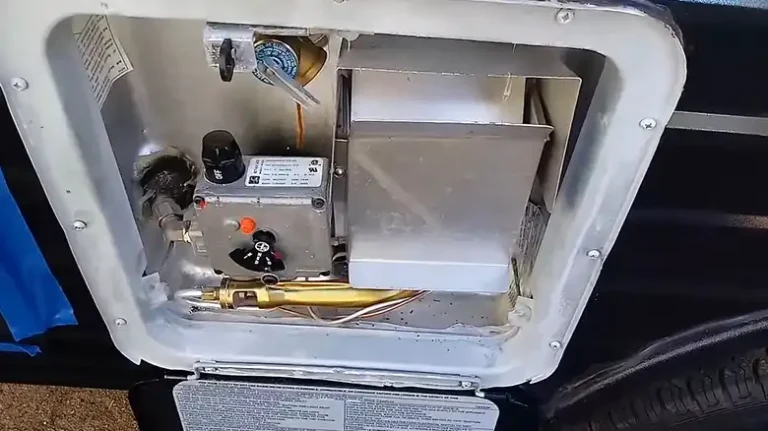
How to Replace an RV Water Heater | A Step-by-Step Guide for DIY Repair
Replacing an RV water heater can be a real pain, but I’m here to walk you through it step-by-step. I know it seems daunting, but have no fear – you totally got this! Just get your tools and materials together and we’ll go through it real easy-like. Safety first though – we gotta turn off…
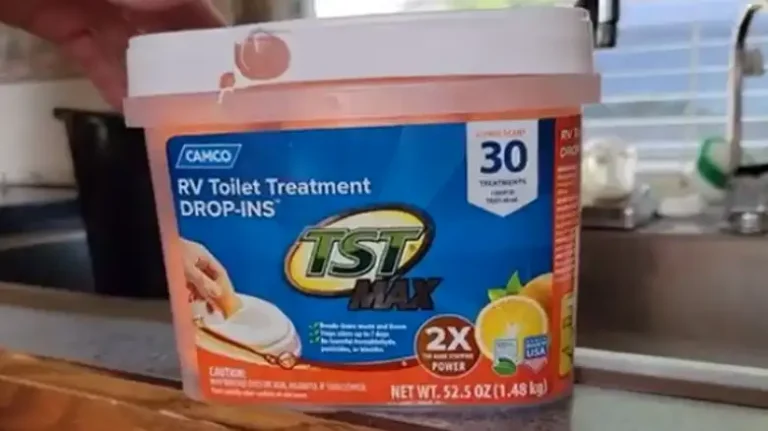
How to Use TST RV Toilet Treatment Drop-Ins | Proper Guideline
Dealing with a smelly and clogged RV toilet can quickly ruin any camping trip. The confined space of an RV means unpleasant odors have nowhere to escape. Fortunately, TST RV toilet treatment drop-ins provide an easy solution to freshen up your RV’s toilet and prevent clogs. In short, TST drop-ins are small tablets that dissolve…
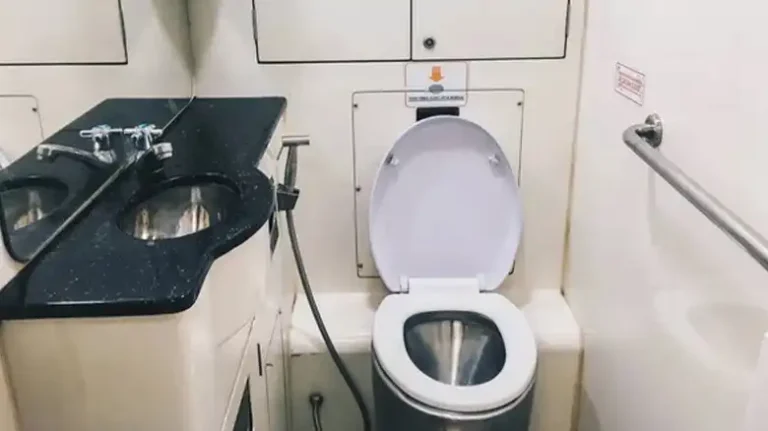
RV Toilet Bubbles When Flushed | What to Do?
As an RV owner, a bubbling toilet when you flush is never a good sign. This unusual phenomenon is often an indicator of issues within your black water system that should be addressed promptly to avoid more serious problems down the road. After dealing with a bubble RV toilet myself, I decided to investigate the…
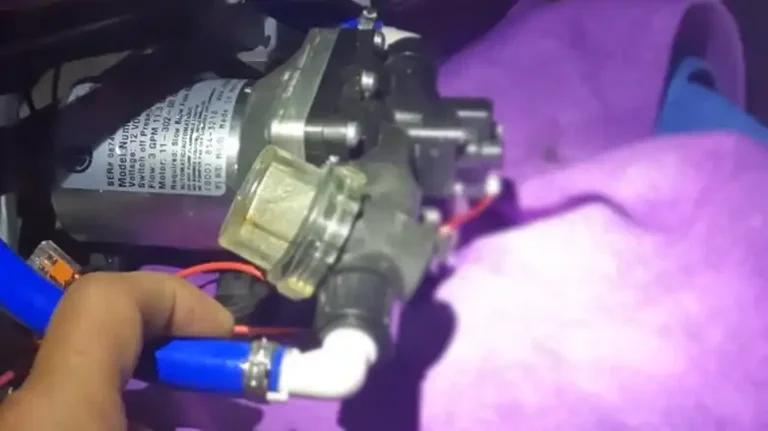
RV Water Pump Humming But Not Pumping | How Do I Fix
As an RV owner, I rely on the RV’s water pump to deliver water for cooking, washing, and flushing. So when I turned on the faucet and heard the annoying humming from the water pump compartment, without any water flowing out, I knew I had an issue to tackle. From experience, this signaled low flow…
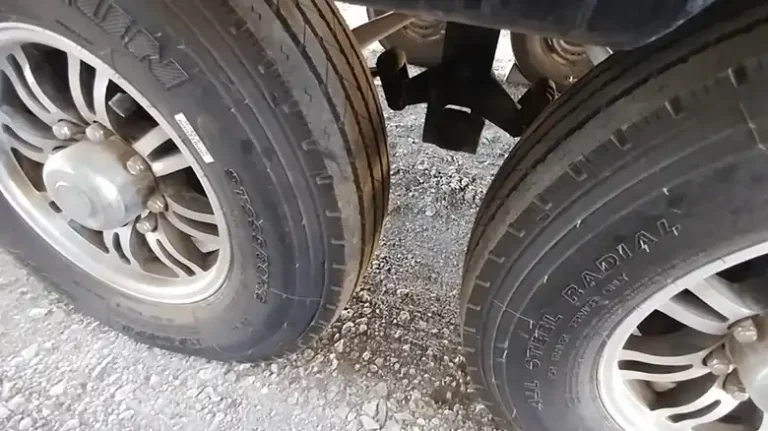
How to Properly Rotate Your RV Dually Tires (What I Did)
As an avid RVer, I frequently get asked about the specialized care and maintenance procedures for “dually” wheel/tire setups commonly found on large motorhomes and tow vehicles. Unlike standard single tires, dually (or dual) configurations have twice the number of tires clustered on each side of the vehicle axle. This provides substantially increased load capacity,…
Leave a Reply Cancel reply
Your email address will not be published. Required fields are marked *
Save my name, email, and website in this browser for the next time I comment.

The Savvy Campers
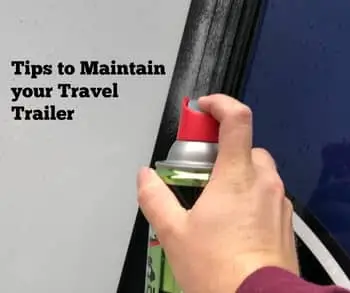
22 Simple Tips to Easily Maintain your Travel Trailer
Why should you maintain your travel trailer.
Maintaining the possessions in your life should be important if you want to keep them working and in top condition for years to come. Your travel trailer deserves simple maintenance to keep it working to the best of its ability for your travels, safety, as well as when you pass it along to another buyer to give them the best camping experience they will have.
Slide Out Maintenance
The slide outs on your RV will need to be maintained to function properly and to stop future leaks from developing. Make sure to keep all moving parts lubricated with a proper lubricant for slide outs. Along with lubricating the moving parts, gears, and rollers, you will want to lubricate the seals on your slide outs to keep them flexible and in good condition.
We use a premium rubber seal conditioner to keep our seals like new. It is also important to check all screws or rivets holding down your slide out seals, and to have someone operate the slide to make sure they are operating properly and coming in contact nicely.
Periodically, you will want to make sure your slide out is going in and out straight. Once it gets off its tracks, it can become very hard to get back on. Read your manual and become familiar with how your slide out works if you ever have to override it and it becomes off its tracks.
Axle Maintenance
The bearings on your travel trailer will need to be inspected and packed with grease periodically. Depending on what type you have, consult your manufacturer to find out what brand are on your trailer. Look up the brand that you have to find instructions of how to re grease the bearings specific to your trailer. Before you re grease the bearings on your trailer, make sure to use a compatible grease to what is originally used on the bearings to not cause damage.
Also, take and note the measurements from wheel center cap to centre cap to make sure your axles are tracking straight. This will keep wear of your tires minimal as well as tell you there is nothing structurally wrong with your travel trailer.
Travel Trailer Tire and Wheel Maintenance
Before every trip you take in your travel trailer, you should always check your tire pressure to make sure it is in range. It is also a good idea to get a tire pressure monitor to monitor tire pressure and temps remotely to prevent a blowout. A blow out can be very dangerous when on the road, so proper prevention is key. We also check our lug nuts torque before every trip when we leave. A loose lug nut can lead to others stripping out or even failure. Keeping a simple torque wrench and sockets which go to different items on your truck or trailer is handy to have in your tool kit. Make sure you have proper sockets to adjust your trailer hitch if needed. Read our article about tire maintenance here.
RV Body and Undercarriage Maintenance
Keep the body of your travel trailer maintained by checking all screws, nuts, and bolts for tightness. While checking for tightness, check for rust anywhere on the trailer and determine what is causing it. Some causes could be scrapes in undercarriage paint, to fix this you would want to sand down the rust spot to bare metal, then apply a paint and clear coat over with an undercarriage paint to match your trailer. Doing this will prevent further rusting of your travel trailer and keep it as good as new. Bare metal is a huge weakness on a travel trailer.
Roof Maintenance
The roof on your RV is one of the most important parts. A leaky roof can permanently damage your travel trailer walls, flooring, or insulation. If you get a rip in it from a low hanging branch, you will want to fix this immediately with roof tape or dicor sealant . We always keep a roll of tape handy just in case something happens.
Washing the roof in your RV with a soft bristle brush and a mild detergent will ensure it is clean and free of debris. We usually do this a few times a year. There is also a roof conditioner you can apply if you have a rubber membrane roof to condition it that will lengthen the life.
Hitch and Towing Maintenance
The hitch is one of the most important parts when you are towing your camper. It is the connection point between your vehicle and travel trailer. If something goes wrong here, you will have problems. If your hitch ball requires grease, make sure to grease the ball with the correct grease recommended by the hitch manufacturer. On our hitch, the Andersen No Sway, it does not require grease as the ball moves with the travel trailer. It is not recommended on our hitch to grease it. Always tow your travel trailer level, to find out why, read our article on how to level your travel trailer for towing.
Make sure your pin or hitch lock is in good condition and free of rust. Keep an eye to make sure it is not causing wear on the hitch mount. The nuts and bolts on your ball mount will need to be checked for correct torque and check this every time you tow your trailer. Read our top hitch guide to find out more information about weight distribution hitches.
RV Electrical Maintenance
Along with checking your trailer lights as already discussed, your electrical system will need to be periodically tested.
Check your battery terminals in your battery box to ensure they are free of corrosion. If your battery terminals are corroded, use a wire bristle brush to clean them off and reinstall. Make sure to only pull one terminal at a time so you do not get your wires mixed up. If your vehicle is equipped with a battery shut off switch, make sure it is in good condition and freely operating. If you have no power in your trailer, always check the outgoing terminals on your cut off switch to see if there is 12v power. If there is no power, you may have a bad switch.
The shore power system will also need to be periodically checked as well. We check this to make sure breakers are working and GFCI outlets are working. This requires a simple GFCI tester that will flip your GFCI breaker or switch on your GFCI outlet. If it flips, than it is protecting you.
Co2 and Smoke Alarm
Periodically hit the test button on both your smoke detector and co2 alarm, as well as check and replace batteries on them. A simple 9v battery is cheap insurance to make sure these items are fully working.
Interior cleaning
Keep your interior clean by using a soft bristle brush and mild detergent and water for all surfaces. Use all purpose cleaner to keep your counters, refrigerator, microwave, bathroom and other items cleaned. Keeping your trailer clean after every use will make one less thing to complete before you get ready for your next trip.
Exterior Cleaning
Periodically clean the exterior of your travel trailer with a soft bristle brush and mild detergent. We use an automotive detergent. As we have a fiberglass trailer, we wax ours in the same way one would wax an automobile. If you have a corrugated metal trailer, you can also keep it waxed and cleaned in the same way, it will just take a bit more time to get in and out of all the groves.
We have this extension brush to reach all heights of our trailer and a good bucket to dip it in. Make sure the bristles are soft enough as to not do damage to your sides, seals, or roofing.
Awning Maintenance
The awning is one thing that tends to be forgotten when it comes to maintenance as it is always tucked away. Make sure to roll it out and wash it just as you do the exterior of the trailer. Always wait for it to completely dry before retracting. Once a year, we condition our awning with a 303 cleaner and conditioner to keep it soft and waterproof. You will also need to maintain all moving parts on your awning. Use some silicone lubricant on the moving parts and slides to ensure a noise free and bind free operation.
RV Holding Tank Maintenance
If kept maintained, the holding tanks on your RV will be the least of your worries. Keep your water tank sanitized by adding bleach to your tank and using your water system. Find out more about the process on our article about fresh water tank maintenance .
The black tank should be rinsed out after each use with a black tank flush if installed or fill the tank about half up with water, throw a bag of ice in, then drive down the road. This will agitate solids which become stuck to the side of the tank and will allow them to be flushed. Also black tanks should have an additive added each use to ensure the waste is able to breakdown naturally.
The gray tank should also be filled and flushed periodically. There are also chemicals you can use to clean your gray tank if it develops any nasty smells. We drop a tab in about once a month when in use to keep it sparkling clean.
Travel Trailer Air Conditioner Maintenance
The air conditioner is something that is often overlooked. We also clean our pre filter which is located in our RV before we go out as it is simple and easily accessible. Once a year, we clean the fins on our condenser of excessive buildup which can cause the air conditioner to not be as efficient. The condenser fins can be located on the roof of the unit. You can use a specialized cleaner with a very soft brush and rinse them off. Doing this will keep your air conditioner blowing the coldest air possible.
RV Furnace Maintenance
The furnace on your RV typically takes little maintenance. Periodically you will need to inspect the exhaust vent for proper airflow. Insects, mice, and birds like to build nests in these vents. If there is a blockage in your exhaust vent, the heater can overheat and cause a fire. Fires are bad.
The ductwork and vents have a tenancy to become disconnected due to being jarred around when driving. Make sure these ducts are connected as well as the return ducts so that there is proper airflow. If you do not have proper airflow, this can cause your motor to run faster and overheat causing premature failure of your furnace.
Water Heater Maintenance
Every time you work on your water heater, remember that most are ran off of electricity as well as propane. Take precautions to turn off your propane gas as well as electricity to the water heater so you do not get electrocuted or your heater does not try and fire up. To do this, turn your propane off at the tank, flip the breaker in your fuse panel, and make sure your hot water tank power is shut off on the switch. Some heaters have an anode rod which is supposed to corrode so the tank does not. You can pull this out and inspect, if it is uncleanable then order a new one and install. If it looks good, reinstall the anode.
Flushing the water tank will go a long way with its longitivity. Empty your water tank, then use a wand to spray around in the tank or fill it up and empty it a few times. This will remove all the buildup and gunk from hard water at campsites.
If you have an electric heating element, remove it and inspect to make sure it is in good condition. If not, replace.
Check your propane burner for buildup and clean with a towel or sandpaper.
Inspect your heater to make sure there has been no water leaks or is no excessive soot buildup from the burner. If there is excessive build up, consult your dealer.
Break and Tail Lights
Before each trip, you should grab a partner and run through your break lights, turn signals, running lights, marker lights, hazzards, and any other exterior lights. This will ensure you get these bulbs replaced asap in case one goes out so you are not a hazard on the road.
Battery Maintenance
Make sure to check water levels monthly when you are using your RV or even more often if you are a full timer or are using and charging frequently. If water levels go low, this can damage your batteries permanently. Keep your batteries charged up so they are ready to go for each trip. Make sure not to discharge your batteries under 60% as this can permanently damage and lower the life of your batteries greatly.
If you live in the colder regions, remove your batteries from your RV over the winter and keep indoors on a piece of wood. Make sure to not directly store batteries on concrete as it is bad for them. Keep them on a battery maintainer or periodically charged over the winter months to keep them happy and working as long as they can. Read more on how long travel trailer batteries last .
Roof Vent Maintenance
The vents on the top of your RV in your bathroom as well as your living area if equipped will need to be checked for leaks. You can apply a seal conditioner to your seals on these vents to keep them supple and water free. While at it, apply some lubricant to your gears that open and close the vent.
Travel Trailer Breaks
The breaks on your travel trailer will need to be checked and adjusted periodically. Consult your owners manual to learn how to service your brakes. If you have questions, have your local dealer complete this service to give you piece of mind.
Travel Trailer Towing Electrical Connection
The 7 way connector will need to be checked as well to ensure all the wires are getting a good connection and there are no breaks in the wire. Make sure there is no nicks or kinks in this wire, or rust or items stuck in your connector. Always store facing down so rain does not build up and cause the rusting of your wire terminals
Inspect Propane Gas Lines
The propane lines will need to be checked for leaks periodically. To do this, make a soapy water solution in a spray bottle. Spray on all fittings, wait to see if there are any bubbles that come up. If no bubbles appear, then you should be fine. If some appear than you have a leak. This is also a good leak finder if you in fact do smell propane.
If you have a leak, shut off all propane, do not use any gas appliances, and fix immediately.
These are just some quick tips to keep an eye on to keep your travel trailer in good working condition. There are many items to maintain depending on your make and model and what accessories you have installed. If you keep these items up you should be a happy camper for years to come.
Be the first to be notified about FREE tips, hints, coupon codes, and email-exclusive information. All for FREE!
Related Posts:
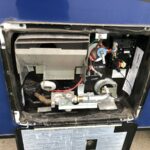
Similar Posts

Can you Camp with a Baby? Tips for a Successful Trip
Camping with my parents as a kid is one of my favorite memories. I remember my mom toting around my younger siblings as babies and I never thought twice about how camping with a baby could be tricky until I had my own. It is relatively easy to go camping with a baby. The main…
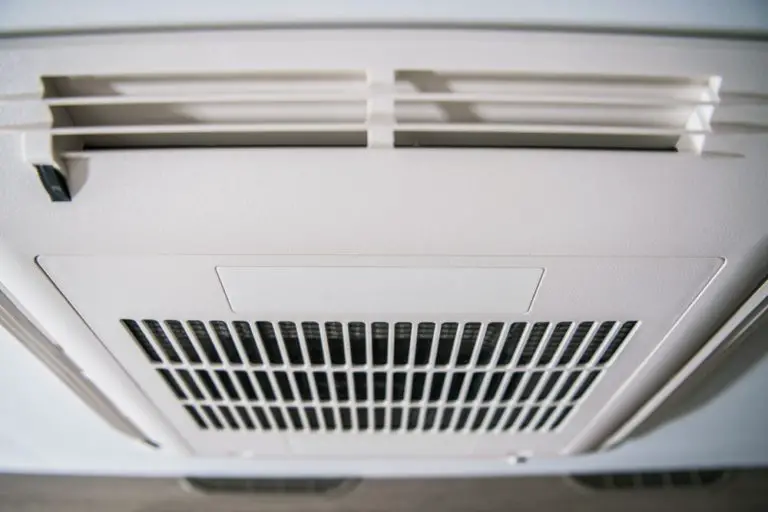
How to Run the AC while Boondocking
Boondocking is the ultimate self-sufficient camping experience. With nearly non-existent amenities when boondocking, running luxury items such as an AC unit when you have no main power can make keeping cool a challenge. How can you run an AC while boondocking? The only way to run an AC effectively and efficiently while boondocking is with…
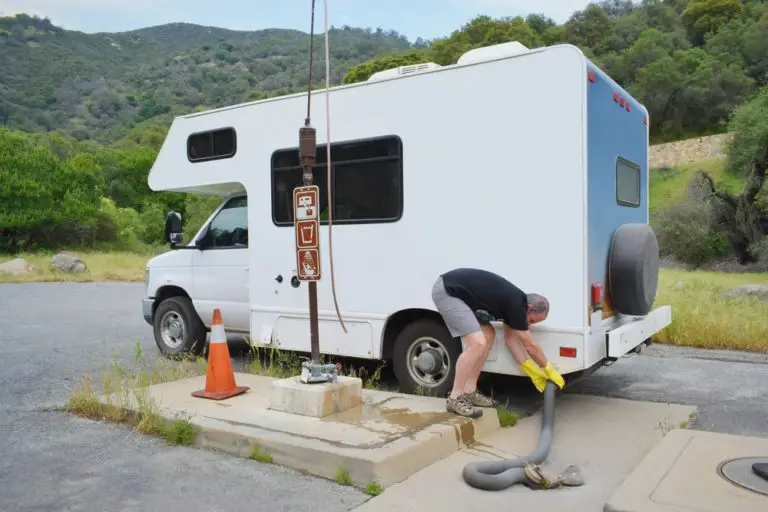
Why Does My RV Smell Like Sewer When Driving and How to Fix It?
In most cases, you won’t smell sewage while driving an RV unless it’s a motorhome. However, for whatever reason, anytime you’re driving your motorcoach down the road, the smell of sewage becomes evident and unbearable. What you can’t figure out is why does your RV smell like sewer when you’re driving but not at other…
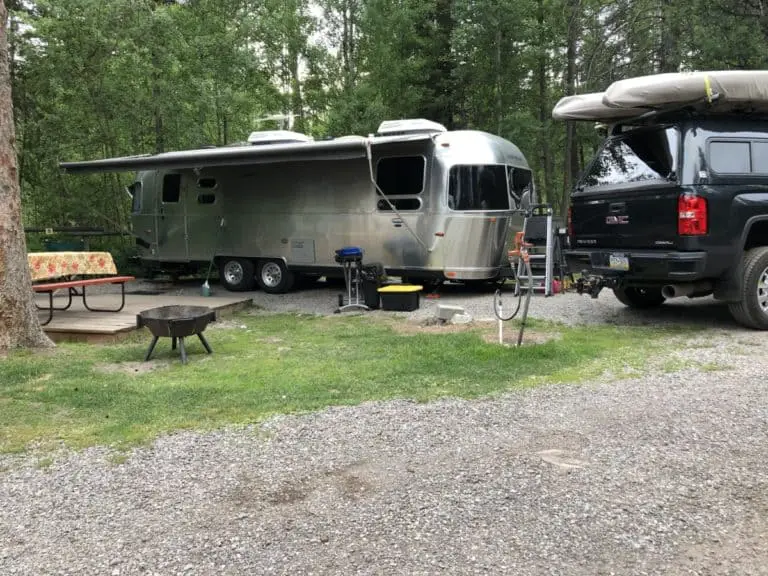
Are All Travel Trailers Self-Contained? What You Need to Know
When you think of a travel trailer, a particular image probably comes to mind-four walls, a roof, a floor, and something that can be towed. You may not know that there are quite a few different types of travel trailers based on the needs of families and even individuals-but are they all self-contained? Not all…
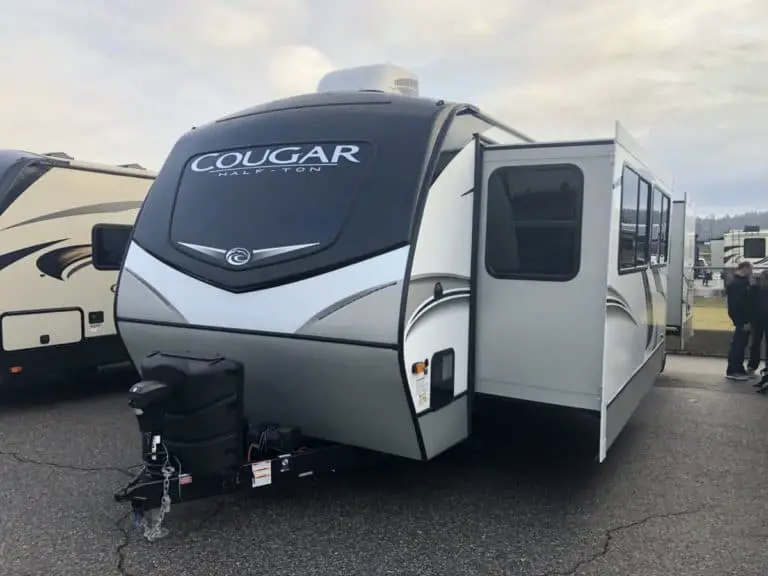
Can You Move a Travel Trailer or RV with the Slides Out?
Towing or moving a trailer with the slides out is a bad idea for a number of different reasons. It can cause thousands of dollars in repairs and it is also very dangerous. Experts and travel trailer owners both agree that it is absolutely imperative that you close your slides before towing. Read on to…
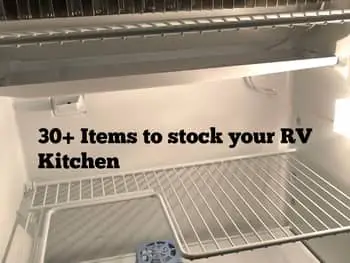
30+ Must Have Accessories you need for your RV Kitchen
One of our favorite parts of taking a travel trailer trip is being able to cook in the outdoors. Sometimes, if it becomes rainy, we are forced to hide out under the awning, or even in the travel trailer itself. We like to have a backup indoors meal planned such as soup or lasagna in…
Join our Newsletter to stay up to date on the latest RV topics and receive our FREE RV Inspection Cheat Sheet Today. Use this tool to inspect new or used campers you are looking at purchasing.
No thanks, I’m not interested!
Maintenance routine sought for Oceanside’s Loma Alta Creek

Consultant would develop plan and obtain permits for regular removal of cobblestone berm that builds up on the beach
- Show more sharing options
- Copy Link URL Copied!
Oceanside plans to hire a consultant for $120,000 to plan, design and obtain permits for the regular maintenance of Loma Alta Creek, the site of a long-planned wetlands restoration.
Loma Alta Creek flows into the ocean at Buccaneer Beach, where the naturally occurring rock cobble creates a large berm for most of the year. The city uses bulldozers and heavy equipment to remove the berm and lower the water when it becomes stagnant and threatens to flood nearby properties.
City staffers are recommending the Oceanside City Council approve a $199,999 contract with Dudek, a national consulting firm with offices in Encinitas, “for the study, design plan, permitting and environmental documents necessary” to quickly clear the creek mouth when necessary.
“Maintenance will lessen flood risks for future projects such as improvements to the existing pedestrian footpath, bathrooms, and recreation area east of the (Pacific Street) bridge, the planned extension of the Oceanside Coastal Rail Trail bike path, and the eventual decommission and conversion of the La Salina wastewater treatment plant to a lift station,” states a staff report.
Approval of the contract is on the consent calendar for Wednesday’s Oceanside City Council meeting. Consent calendar items usually are approved in a single vote without individual presentations or comments.
The area to be studied by Dudek covers about half an acre west of the bridge. The consultant’s services will provide information to assist the city with other projects planned for the creek area.
Late last year, the National Fish & Wildlife Foundation announced a $500,000 grant that was the final chunk of funding Oceanside needed to start construction on the city’s Loma Alta Slough wetlands restoration project.
Construction is expected to start this year on about six acres, mostly east of the bridge. The work will include the excavation of the creek channel and the removal of invasive plants to improve water circulation and quality.
A 6-foot-wide public trail, an overlook and interpretive signs will be added, along with a connection to the Coastal Rail Trail.
Oceanside has planned the restoration for more than 20 years. The remaining wetlands are a small percentage of a much larger slough that was reduced by encroaching urbanization over the past century.
The city received a $400,000 grant in 2018 from the State Coastal Conservancy to begin the restoration design, and in June 2022 it received $1 million from the California Ocean Protection Council in June 2022 to go toward construction costs, which are expected to be a little more than $2 million in all.
Get North County news in your inbox
Top stories from the San Diego North County every Monday, Wednesday, and Friday.
You may occasionally receive promotional content from the San Diego Union-Tribune.

More from this Author
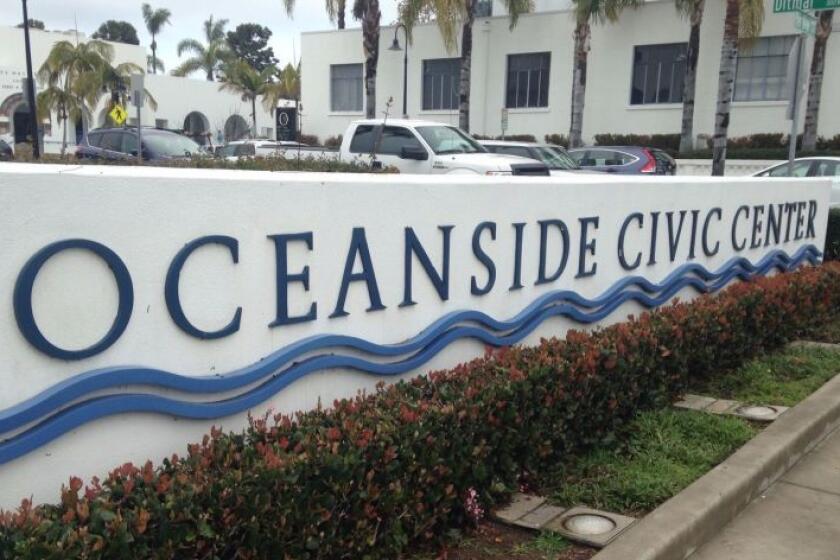
Money to hire more city employees in draft Oceanside budget
April 21, 2024

Chicano Park returns to roots to commemorate 54 years of spirit
April 20, 2024

Plans proceed for solar farm at Carlsbad city reservoir
April 19, 2024

Governor announces $11.4 million to address homelessness along Oceanside-Carlsbad border
April 18, 2024
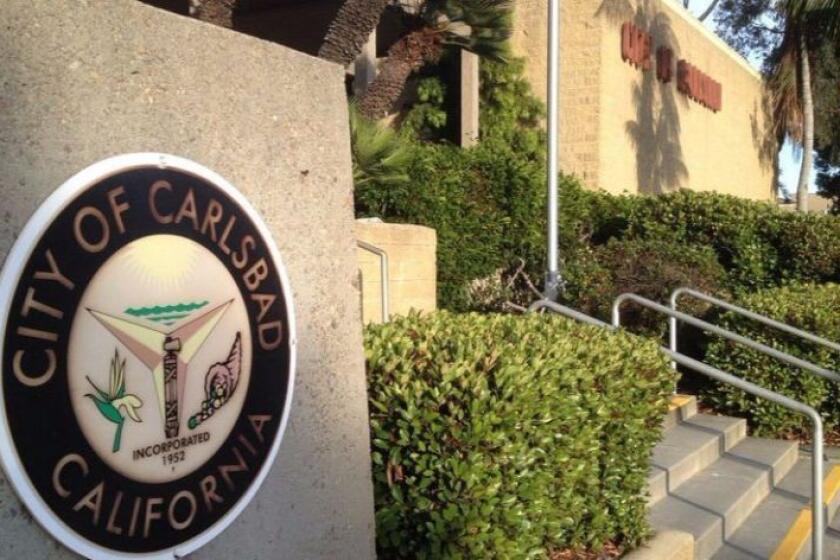
Carlsbad refuses AT&T contract for cell tower at Poinsettia Park
April 17, 2024

Del Mar councilmember censured 2nd time for alleged rogue behavior
April 16, 2024
More in this section
Public Safety
Man’s body found next to sailboat, dock in Oceanside Harbor
The man was found floating next to his sailboat and the G dock Monday morning; his name was not released pending notification of his family
April 22, 2024

Debt, deferred maintenance slow deal to rescue Tri-City Medical Center
UCSD Health CEO says she’s still optimistic that a final agreement will be approved
Camp Pendleton Marine sentenced to 13 years in prison for DUI crash that killed boy, 12
Edward Minot, 21, was arrested last summer for the Oceanside Fourth of July crash that killed Santiago Gaspar and injured two others in the vehicle

Oceanside man pleads guilty to crash that killed three members of same family
Mason Fish pleaded guilty Wednesday as potential jurors stood waiting for jury selection to begin. The crash killed a woman and her two adult daughters
Man struck, killed crossing busy north Oceanside street
The fatal crash is the second time in two days that a pedestrian was killed trying to cross an Oceanside street outside a crosswalk
One dead after car strikes three people crossing Oceanside street
The crash happened about 7:30 pm. Sunday on Oceanside Boulevard near College Boulevard. A 21-year-old man died at a hospital, and a 24-year-old man and 28-year-old woman were treated at a hospital and released
April 15, 2024

IMAGES
VIDEO
COMMENTS
Routine Maintenance and Checks. A lot of RV maintenance should be done before and after each trip. Making sure that everything works ensures safety on the road and helps prevent unwanted surprises while on the road. Properly cleaning and storing your RV after and between uses also prevents things like mold and rust that can eat away at the RV ...
Lets go through a major points that need to be on your travel trailer maintenance checklist. 1. Inspect and maintain Awning. RV awning is an important part of your RV or travel trailer. There are few things that you need to do to keep it in good shape. Make use of locks to prevent it from rolling down while traveling.
Cost of RV maintenance. RV Maintenance cost can vary depending on what type of RV you have. A Motorhome like class A or class C will have bigger needs as compared to a small pop up camper. If you own a standard RV like travel trailer or a class B Motorhome expect to spend anything around $400 to $1200 per year on maintenance.
Clean A/C filter and air returns. Check pin box bolts are tight (for fifth wheels) Check roof sealant for cracks (including areas around the TV antenna or satellite dish, front and rear cap seams, around the air conditioner, fans, solar panels etc. Check for any loose screws on ladder, trim pieces, etc. and tighten.
Exterior routine inspection and maintenance. Wash the exterior. Avoid power washers. Interior routine inspection and maintenance. Interior vacuum, dust, and wipe. Clean floors. Clean bathrooms. Disinfect counter-tops. Detailed steps are provided in the travel trailer maintenance guide below.
The video walks you step-by-step through the maintenance items that we perform on our RV for living in it full time. The description is packed with helpful r...
RV Owner Annual Maintenance Checklist. Last updated on November 7th, 2023. Originally published on August 1st, 2020. As an RV owner, one of the most important things you can do to ensure your RV stays usable year after year is to keep up with routine maintenance. Unfortunately, many RV owners have no idea what kinds of things they should be ...
Conducting routine maintenance on your motorhome can make your RV camping trip more enjoyable by freeing you from worry and reducing the chance of potential mishaps. These RV maintenance tips should help you keep your camper, motorhome, fifth wheel, or travel trailer in tip-top shape. Additional resources.
That's why it is essential that RV owners perform monthly checks and routine maintenance. 1. Check and Repair Seals. Check all interior and exterior seals on the roof, doors, and windows. Good seals play a crucial part in limiting water leaks and preventing water damage that is so common in travel trailers. 2.
This RV maintenance task might require the help of a certified technician, especially if your RV is equipped with an auto-leveling system. Those systems can put your entire RV, and anyone inside, in danger if they aren't adjusted and maintained properly. Consult a service center to see if your stabilizing system needs to be inspected and ...
The RV Maintenance Checklist: Essential Components. A thorough RV maintenance routine is crucial for ensuring your home-on-wheels remains a haven of safety and comfort on your travels. This checklist covers the essential components, from engine care to HVAC systems, ensuring every aspect of your RV gets the attention it needs for a worry-free ...
Annual maintenance. A yearly travel trailer maintenance is good for the other parts, systems and mechanisms of your RV. Your annual maintenance and spring cleaning must include the following parts: Awning; The awning is highly vulnerable to a lot of dust from the outside, all the while rain and humidity may cause molds and mildew to accumulate.
Make sure to use scratch-free sponges and brushes to avoid damage to the finish. 2. Wax or seal finish. Once your RV is nice and clean, use wax or sealant to protect the finish from harmful sun exposure and debris. RV wax will offer protection for 2-3 months, and a sealant can offer up to 6-7 months of protection.
Use the checklist below to make sure you are as current as you can possibly be in all of your RV maintenance. Maintenance Item Every Trip Monthly Seasonally Yearly Helpful media. Check your Tires Read about RV/trailer tires. Check your 7-way Read about 7-way installation. Check your Slide-Out. Check your Propane Hoses Read about propane ...
Then, locate your furnace vent on the outside of your RV, unseal the exterior compartment and remove the furnace cover. Start your furnace maintenance with a visual inspection of the circulation and combustion wheels. Remove any debris or obstructions. If the wheels are dirty, use compressed air to clean.
Air. Fuel. Coolant. Hydraulic. 4. Tires. Because RVs often sit idle for long periods of time, their tires may be prone to premature deterioration. Luckily, tire maintenance is pretty straight-forward. Regularly make sure the air pressure in your tires matches the manufacturer recommendation.
Keeping up with routine maintenance on your RV not only provides a better experience for renters but also prolongs the life of your asset. Use our blog and the checklist below as a guide for the care your RV needs to be rental-ready.. For even more information on maintenance, check out our Owner Meet-up video about easy repairs and common RV maintenance.
Maintenance tasks aren't just chores, they're vital for your RV's longevity and performance. This means checking the pressure of your tires, inspecting the RV roof vents, maintaining the water tanks (both the black tank and grey water tank), ensuring your water heater works optimally, and managing oil changes. Not only that but you also ...
When it comes to travel trailer maintenance, one crucial aspect that you should never overlook is the brakes. ... Window and door seals are an essential part of your travel trailer's maintenance routine. These seals help keep the elements out, ensuring that you stay warm and dry no matter where you go. Over time, however, these seals can ...
Before we roll up our sleeves and open the checklist, let's understand why routine RV maintenance is the unsung hero of your travel escapades. Imagine cruising down the highway, wind in your hair, only to be halted by a preventable breakdown. Regular maintenance ensures your RV stays road-worthy, reduces the risk of unexpected issues, and ...
Check out our list of RV maintenance tasks that you should perform before your trip, monthly, seasonally and annually if you want to keep your rig in tip-top shape. Your company account is blocked and you cannot place orders. If you have questions, please contact your company administrator.
Flush water heater of debris and replace anode rod (if applicable) — every 6 months. Check torque on all nuts and bolts on RV and hitch — every 6 months. Clean and lube hitch — every 12 months. Reseal all seams, including those on the roof — every 6 months. Clean and treat slide rubber seals — every six months.
Slide Out Maintenance. The slide outs on your RV will need to be maintained to function properly and to stop future leaks from developing. Make sure to keep all moving parts lubricated with a proper lubricant for slide outs. Along with lubricating the moving parts, gears, and rollers, you will want to lubricate the seals on your slide outs to keep them flexible and in good condition.
Our event pages are undergoing routine maintenance to enhance your experience. Thank you for your patience. PJ Morton - Cape Town to Cairo Tour More Info. Sun • Aug 18 • 7:00 PM The Orpheum Theatre Memphis, Memphis, TN. Close Menu. Search Artist, Team or Venue. Clear search term. Submit Search. We're Here to Help.
April 24, 2024 9:30 AM PT. Oceanside plans to hire a consultant for $120,000 to plan, design and obtain permits for the regular maintenance of Loma Alta Creek, the site of a long-planned wetlands ...
Wipe away deposits and residue under the drip tray in the dispenser housing. Clean the tip of the water dispenser tube: Use a cotton swab moistened with white vinegar to clean the tip of the water tube in the dispenser. Plug the fridge back in and run water through the dispenser to rinse vinegar from the tip of the water tube.